
- About
- Library
-
Essays
Eric Dinerstein William C. Young
- Plants
- Birds
FIELD NOTES FOR COSTA RICA
March 10-23, 2018
William Young
In March, 2017, I spent ten days in Costa Rica — the first five at Rancho Naturalista and the last five at Rancho Bajo, about a ten minute walk from Rancho Naturalista. Both are about 60 miles east of the Juan Santamaria International Airport in the capital of San Jose. In 2018, I returned to Costa Rica for two weeks around the same time with Ashley Bradford, who had never before visited the Neotropics.
Itinerary
March 10: Airport South along the Pacific Coast to San Isidro de El General
March 11: San Isidro, Los Cusingos, San Isidro, Trogon Lodge
March 12: Trogon Lodge, Rio Savegre
March 13: Trogon Lodge, Rio Savegre, Quetzal's Paradise, Heredia
March 14: Heredia, Rancho Bajo, Wayne Easley's House, Rancho Naturalista Hummingbird Pools
March 15: Rancho Bajo, La Suiza, CATIE, Rancho Naturalista
March 16: Rancho Bajo, Base of Cerro Silencio, Rancho Naturalista Road
March 17: Rancho Bajo, Rancho Naturalista
March 18: Rancho Bajo, Wayne Easley's House, Rancho Naturalista
March 19: Oriente, Tapanti
March 20: Rancho Bajo, Rio Tuis, Rancho Naturalista
March 21: Cope's House
March 22: Rancho Bajo, Casa Turire
March 23: Rancho Bajo, Rancho NaturalistaChronological Account
March 10
We left Dulles Airport in Washington around 9 a.m., and we collected our luggage and picked up our rental car in San Jose around 2:30 p.m. Our destination on the first day was San Isidro de El General. We could have gotten there by driving east through San Jose and heading south through the highlands. Instead, we drove south, which is a bit longer but avoids the San Jose traffic. It also let us drive along the Pacific coast, sometimes seeing the ocean. This route takes about 3.5 to 4 hours, and we did not have a lot of daylight left. I saw a Magnificent Frigatebird soaring over the shoreline. We stopped briefly at a lookout at Puntarenas and saw a flock of Brown Pelicans over the water. A pair of Black-crowned Tityras were in a tree along with a pair of Hoffman's Woodpeckers and a male Baltimore Oriole in breeding plumage. The male woodpecker had ruffled feathers. A Blue-gray Tanager was in a nest in the opening near the top of a utility pole. As night approached, we heard the loud, steady ringing sound of the chicharras, the Spanish word for cicadas.
We eventually arrived at the Hotel Zima. The hotel was far enough away from the main road through San Isidro that we heard little traffic noise, which had been a concern because we were staying on a Saturday night. After dropping off our luggage in our room, we went straight to dinner. The waiter was a nice man named Franco. We told him about our plans for the following day to visit the home of Alexander Skutch, whose work has influenced me so much. Franco spoke very highly of Dr. Skutch and said he used to visit Dr. Skutch's home and drink orange juice with him.
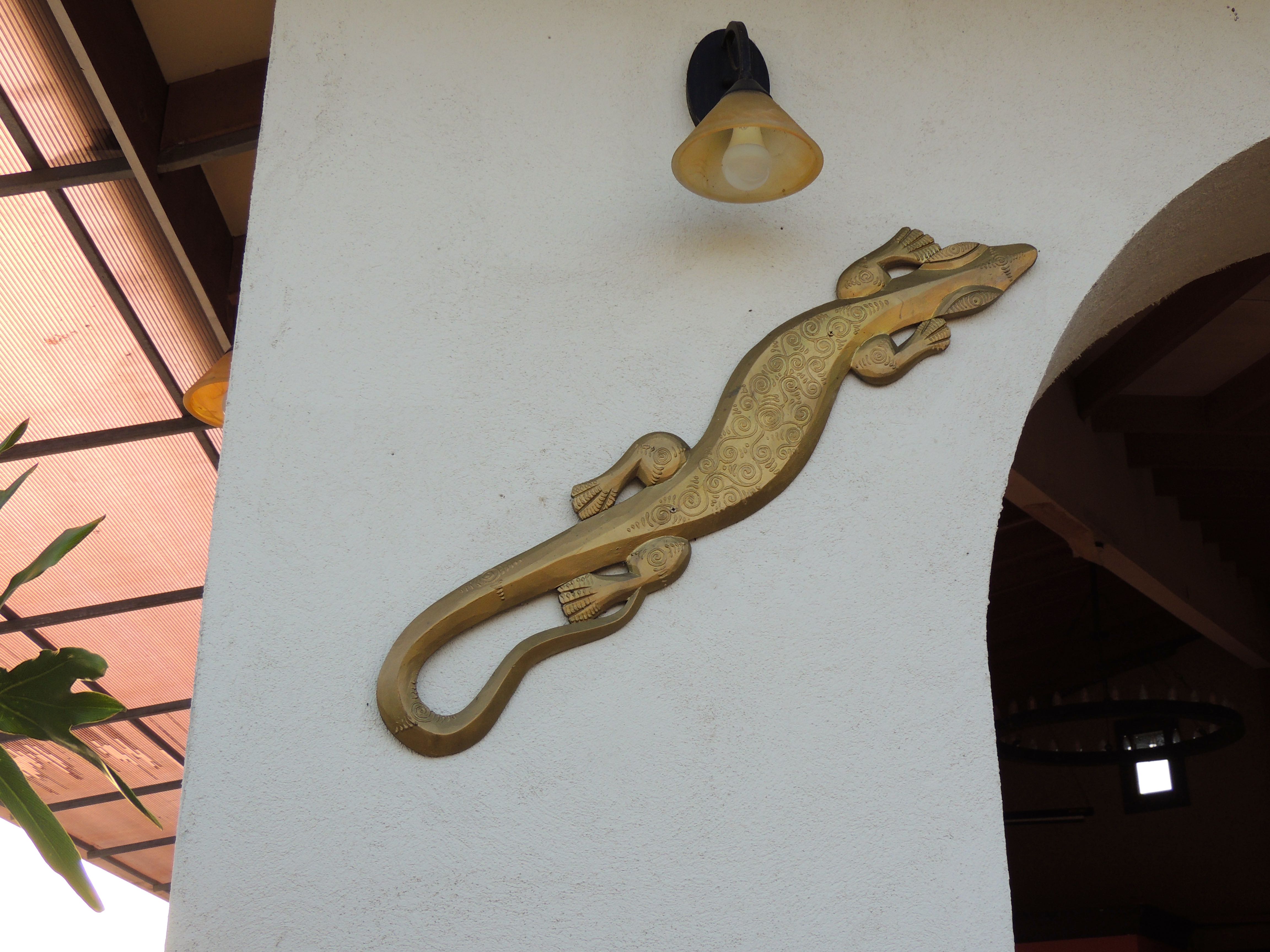 Hotel Zima - Photo by William Young
Hotel Zima - Photo by William YoungMarch 11
We got up early and had breakfast, which was included in the hotel price. Franco once again was our waiter. The Hotel Zima has a lot of fruiting trees and feeders for both passerines and hummingbirds. We did not see anything unusual, but most of the birds were new for Ashley. She had never seen Blue-gray, Palm, or Golden-hooded Tanagers, all of whom came to the feeders. She also had not seen Summer Tanagers, who occur in the United States, but most nest farther south than Northern Virginia. Chestnut-sided and Tennessee Warblers came to the feeders, while Clay-colored Thrushes and Rufous-collared Sparrows hopped on the ground. We saw Cherrie's Tanagers; the males look identical to the Passerini's Tanagers, who were very common when we arrived at Rancho Naturalista. In trees not far from our room was a colony of large bats, probably Jamaican Fruit Bats.
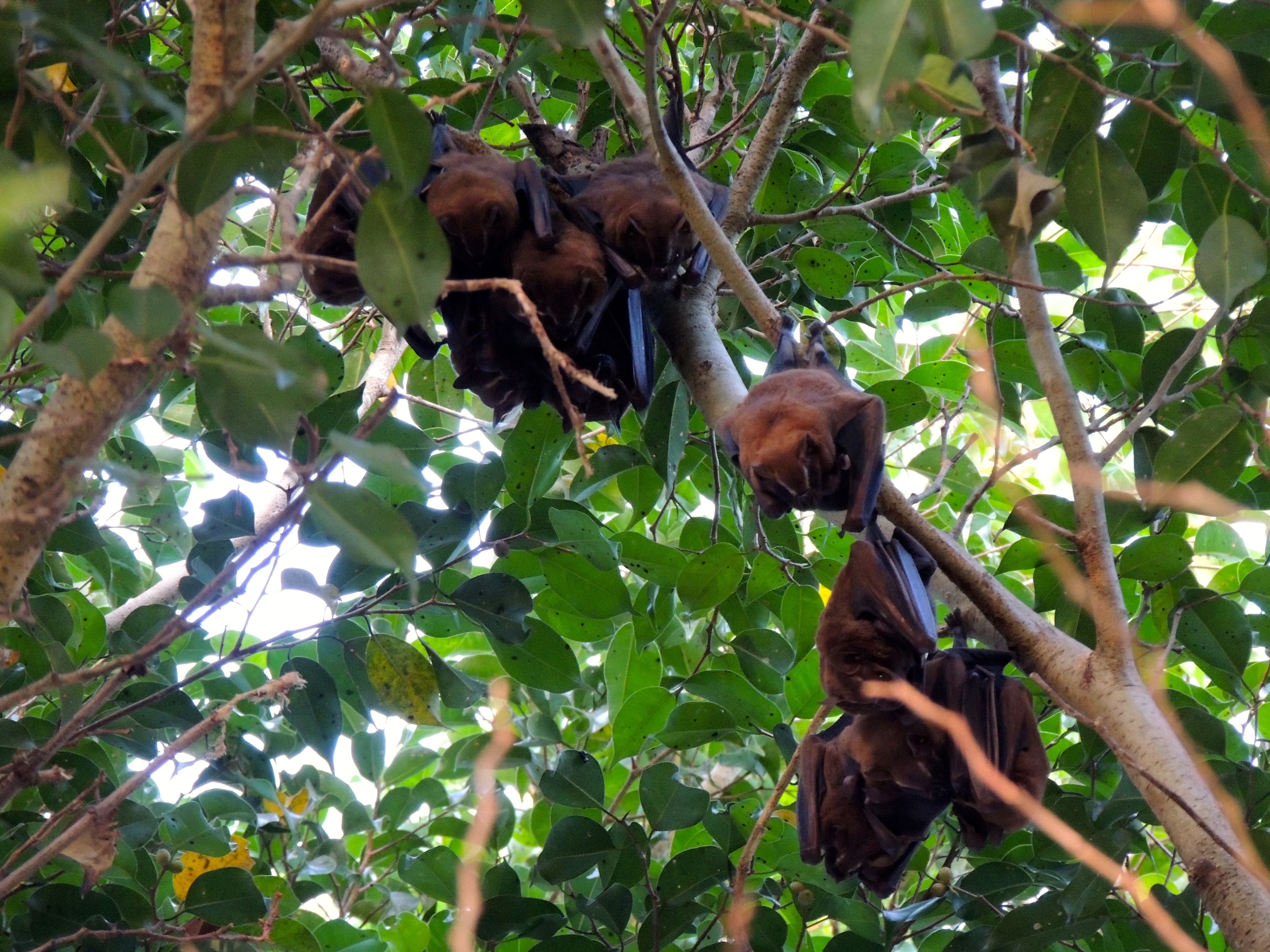 Jamaican Fruit Bats - Photo by William Young
Jamaican Fruit Bats - Photo by William YoungWe drove a half an hour to Dr. Skutch's house. In the parking area, we heard the loud calls of Yellow-throated Toucans in the trees. They used to be called Chestnut-mandibled Toucans. Dr. Skutch named his home Los Cusingos, which is the Spanish name for the Fiery-billed Aracari. He later regretted this, because toucans and aracaris raid songbird eggs and nestlings. Fiery-billed Aracaris were in the trees near the parking area. Bicolored Antbirds were perched near an army ant swarm, hoping to pick off insects or other wildlife flushed by the ants. In the forest, Ruddy Woodcreepers foraged on tree trunks. I heard the joy-buzzer sound of a Red-capped Manakin, and a male was in the trees showing off his yellow thighs. We saw two species of helicopter damselflies. One was small with yellow tips to its wings, and the other was large with blue tips.
 Fiery-billed Aracari - Photo by William Young
Fiery-billed Aracari - Photo by William YoungSpeckled Tanagers were at the feeders near the parking lot — one tanager almost hit me when flying by. We saw Cherrie's Tanagers and a Gray-headed Tanager at the feeders near Dr. Skutch's house, along with a Buff-throated Saltator. A male Green Honeycreeper was in the trees, as was a Piratic Flycatcher. We heard the plaintive calls of Great Tinamous. The hummingbird feeders were visited by Rufous-tailed Hummingbirds, the species who inspired Dr. Skutch to study free birds in the wild.
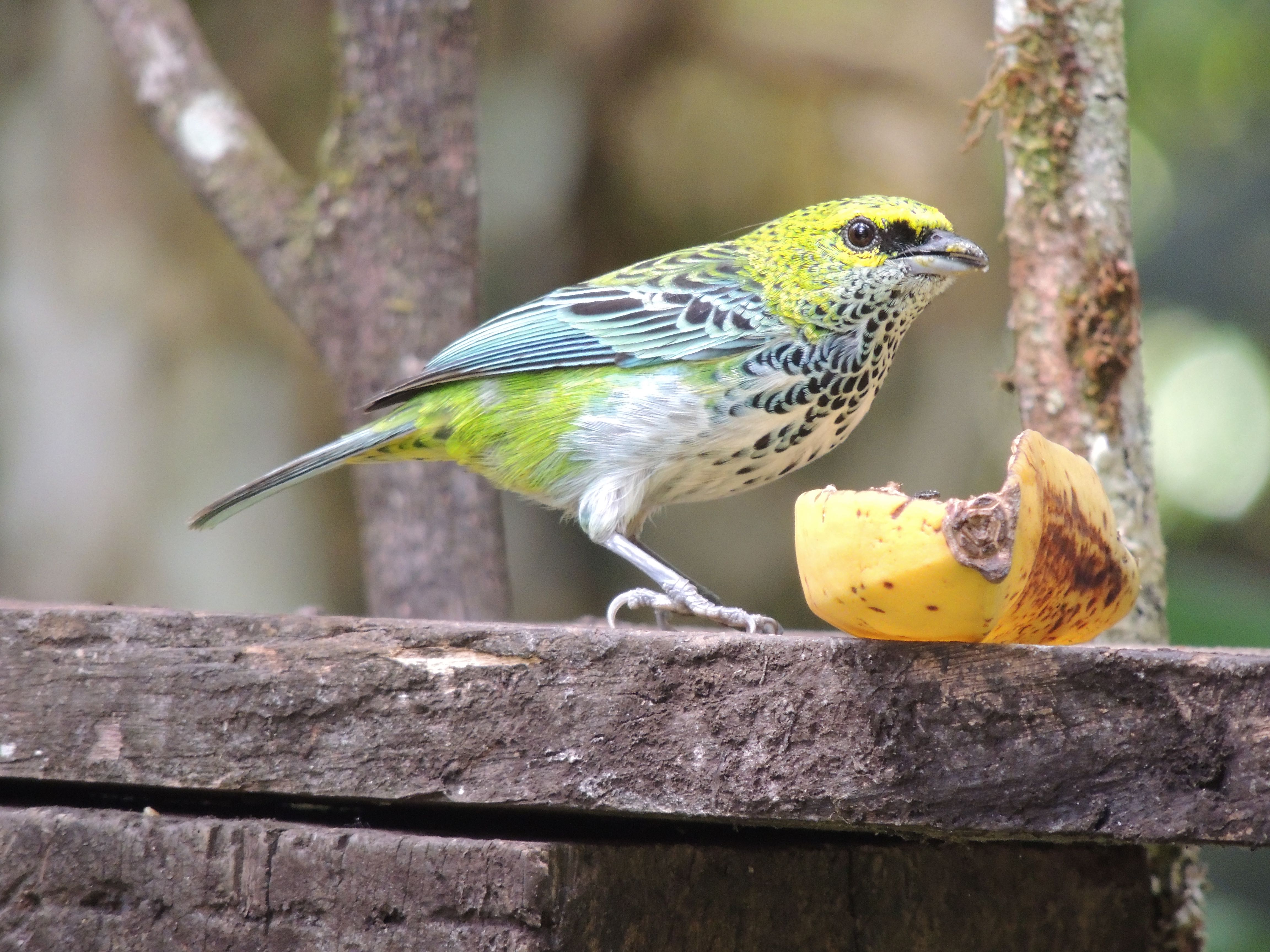 Speckled Tanager - Photo by William Young
Speckled Tanager - Photo by William YoungWe spent time looking at Dr. Skutch's house, which has been left pretty much the way it was when he lived there. He died in 2004, about a week shy of his 100th birthday. He was a lifelong vegetarian who believed in ahimsa, a principle from Jainism, Hinduism, and Buddhism concerning nonviolence toward all living things, which is why he did not use farm animals to help with work on his farm. Mahatma Gandhi practiced ahimsa.
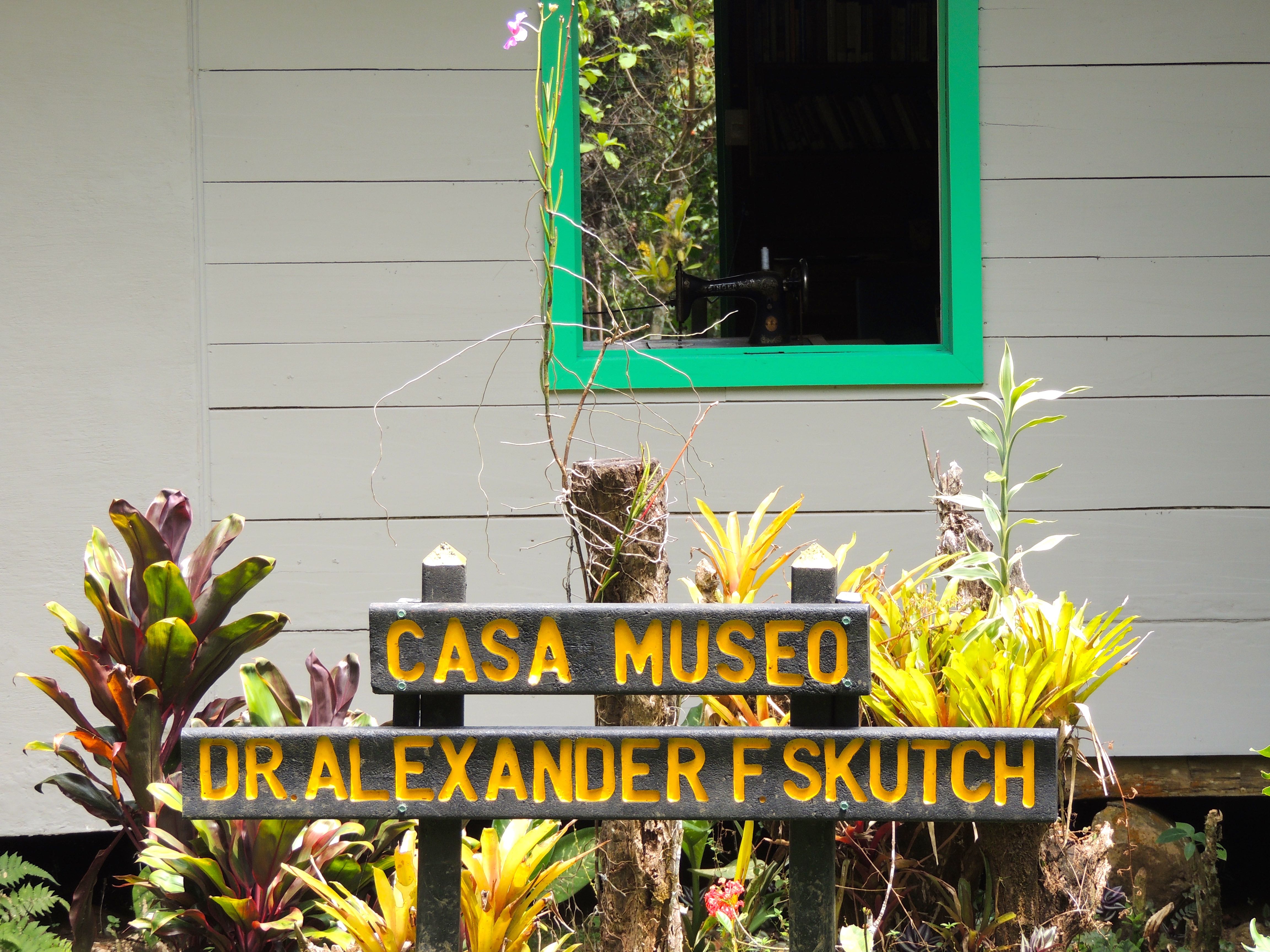 Los Cusingos - Photo by William Young
Los Cusingos - Photo by William YoungThe house has a U-shaped design. The left side of the U has the kitchen, with the pots, utensils, bowls, and oven. Next to the kitchen is the dining room, which has a cabinet with china, serving items, a safe, and a large bookshelf. I was interested to see the books on his shelves. Among the books in his dining room were John Betjeman's Collected Poems, Niko Tinbergen's The Herring Gull's World, Karl von Frisch's The Dancing Bees, Bruce Beehler's A Naturalist in New Guinea, and Alfred North Whitehead's The Concept of Nature.
 Los Cusingos - Photo by William Young
Los Cusingos - Photo by William Young
 Los Cusingos - Photo by William Young
Los Cusingos - Photo by William YoungThe rooms on the bottom of the U overlooked the gardens behind the house. The first one was where Dr. Skutch and his wife slept. There were separate single beds, and a closet had hangers with some of Dr. Skutch's clothing. There were also boots, walking sticks, and a machete. Next door was a room where Mrs. Skutch spent a lot of time; it had a small television, a sewing machine, and lots of books. The next room was Dr. Skutch's study. Dr. Skutch typed all of his 40 books and other work on manual typewriters. In 1997, I ate dinner with Dana Gardner, who did the artwork for many of Dr. Skutch's books. Dana lived in Los Angeles, and he told me that he would search in antique stores for manual typewriters so that he could send the ribbons to Dr. Skutch. One manual typewriter was on Dr. Skutch's work table, and two others were on a side table. The study also had a number of old cameras, old binoculars, and a pencil sharpener. His bookshelves had some of the same books that I own.
 Los Cusingos - Photo by William Young
Los Cusingos - Photo by William Young
 Los Cusingos - Photo by William Young
Los Cusingos - Photo by William YoungThe other side of the U had two rooms. One was where his adopted son slept. The other was the bathroom, which still had two toothbrushes neatly laid out. The house has no windows — Dr. Skutch did not like to be separated from nature. And it has no ceilings — you can see up into the roof. For a long time, I have wanted to visit Dr. Skutch's home, and seeing it in person meant a lot to me.
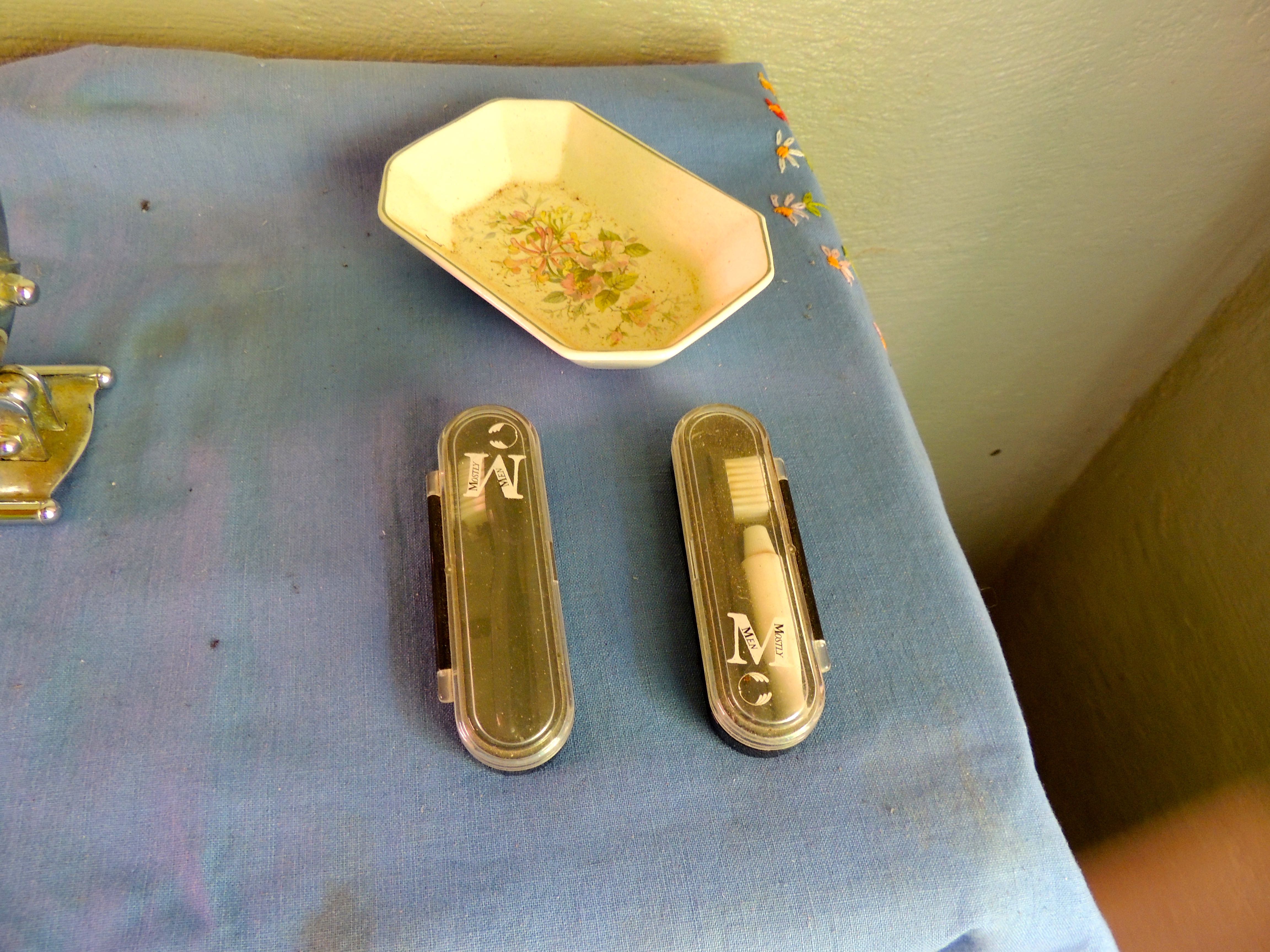 Los Cusingos - Photo by William Young
Los Cusingos - Photo by William YoungWe drove back to the Hotel Zima for lunch and told Franco about our experiences at Los Cusingos. He said that sometimes, aracaris were in one of the trees at the hotel, but they were not there when we looked. We then began our drive to the Trogon Lodge, which is in the cloud forest. On our way up, we ran into fog a few times, which is fairly common because of the elevation and the clouds. The road from Highway 2 to the Trogon Lodge is not very good, but we arrived without incident. The grounds of the lodge are lovely, with the rooms blending into the side of a beautifully landscaped hill.
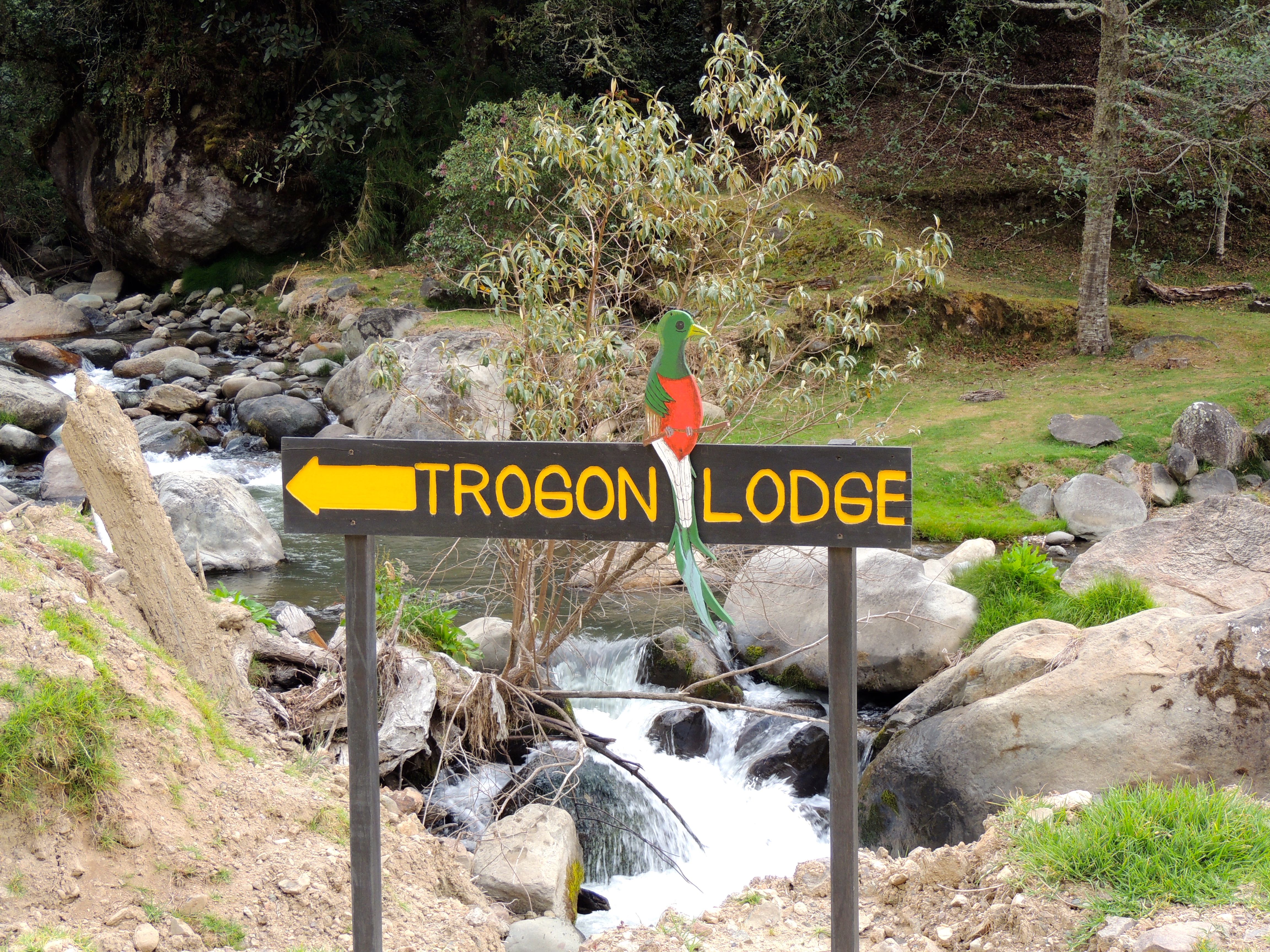 Trogon Lodge Sign - Photo by William Young
Trogon Lodge Sign - Photo by William Young
March 12
We met Grievin Gonzalez from the Trogon Lodge at 5:30 for a bird walk before breakfast. Not far from our room was a female Resplendent Quetzal, who does not have long uppertail coverts like the male. She looks like a chunky trogon, with a greenish back and breast, gray belly, red undertail coverts, and a black-and-white striped undertail. Yellow-thighed and Large-footed Finches are common on the property. We drove up a hill to an open area next to a farm and saw a pair of Black Guans, who are all black with blue facial skin. They looked smaller than the Crested Guans I saw at Rancho Naturalista last year. We saw a Hairy Woodpecker, who is a different race than the ones in Virginia — the belly has a brownish wash. We heard the call of a Costa Rican Pygmy-Owl, who sounds like a Saw-whet, but we did not see one.
A bit further up the road were male Resplendent Quetzals. The male is spectacular, with a Day-Glo green back and breast, a bright red belly, and very long uppertail feathers. We had good looks at them, but the atmosphere for viewing them was not pleasant. The area is mobbed with tourists who want to see quetzals, and I felt as if I was at a circus or a sporting event. Grievin told people not to get too close to the birds or use flash photography, but I imagine the tourists do whatever they want if Grievin is not around. One tree had a nest that a male quetzal was still excavating. Quetzals nest in holes, and we could see the hole with the male's two long uppertail coverts sticking out. From going in and out of the hole during the nesting season, the long feathers are damaged and usually fall off.
 Resplendent Quetzal - Photo by William Young
Resplendent Quetzal - Photo by William YoungOn the ride back down for breakfast, we I saw a Flame-colored Tanager in a tree, Sooty Thrushes on the road, and Acorn Woodpeckers flying around. The area also has Mountain and Clay-colored Thrushes, who look similar. The Clay-colored Thrush is the national bird of Costa Rica, which is a good choice because so many people in the country are familiar with it. I think the American Robin would be a better choice for the national bird of the United States.
The food at the Trogon Lodge is very good. At breakfast, there is a buffet and an omelet chef. The dinners are buffet style, and at lunch, there is either a buffet or you can order from a menu, depending on how many people are staying at the lodge.
After breakfast, we went on a bird walk in San Gerardo de Dota with Agniel Trejos, another guide connected to the Trogon Lodge. San Gerardo de Dota is a community that stretches along the road off of Highway 2. Our walk was on the road along the Savegre River, and we continued onto a trail that leads to the Truchas Reales Hatchery. In the flowering bushes next to the road, we saw a number of hummingbirds, including the tiny Scintillant and the Stripe-tailed. In a farm area, three Lesser Goldfinches were feeding in a bush, along with a Yellow-bellied Siskin. Black-throated Green Warblers were here in the highlands, but I did not see any at lower elevations during the trip; we also had seen one earlier this morning. A Black-thighed Grosbeak was in the trees, as were Silver-throated Tanagers and Mountain Elaenias.
On the trail to the hatchery, a pair of Ruddy Treerunners were interacting in a tree. They look very rufous and have a white eyestripe. The Yellowish Flycatcher has a giant white eyering — even though I sometimes use words with "ish" to describe a bird, it is humorous when a bird's name contains such an adjective. Spotted Wood-Quails were calling; they sound like a hospital trolley with a squeaky wheel. Sulphur-winged Parakeets flew over; we saw the yellow on the wings, but we did not see a perched one. In an area in the woods with an opening, Ashley saw a Golden-winged Warbler. We also saw Flame-throated Warblers, (whose throat is the color of a Blackburnian), Wilson's Warblers (who were common throughout the trip), and a pair of cooperative Collared Redstarts hopping on branches close to us. A Ruddy-capped Nightingale-Thrush was on the ground. A couple of Yellow-winged Vireos and a Philadelphia Vireo were in the trees. The Yellow-winged has an eyeline and wingbars that have a yellow wash. As we returned to our vehicle, we saw a Blackburnian Warbler and both a Sooty-capped and Common Chlorospingus. Chlorospingus means "green finch"; these birds used to be called "bush-tanagers" and are in the tanager family.
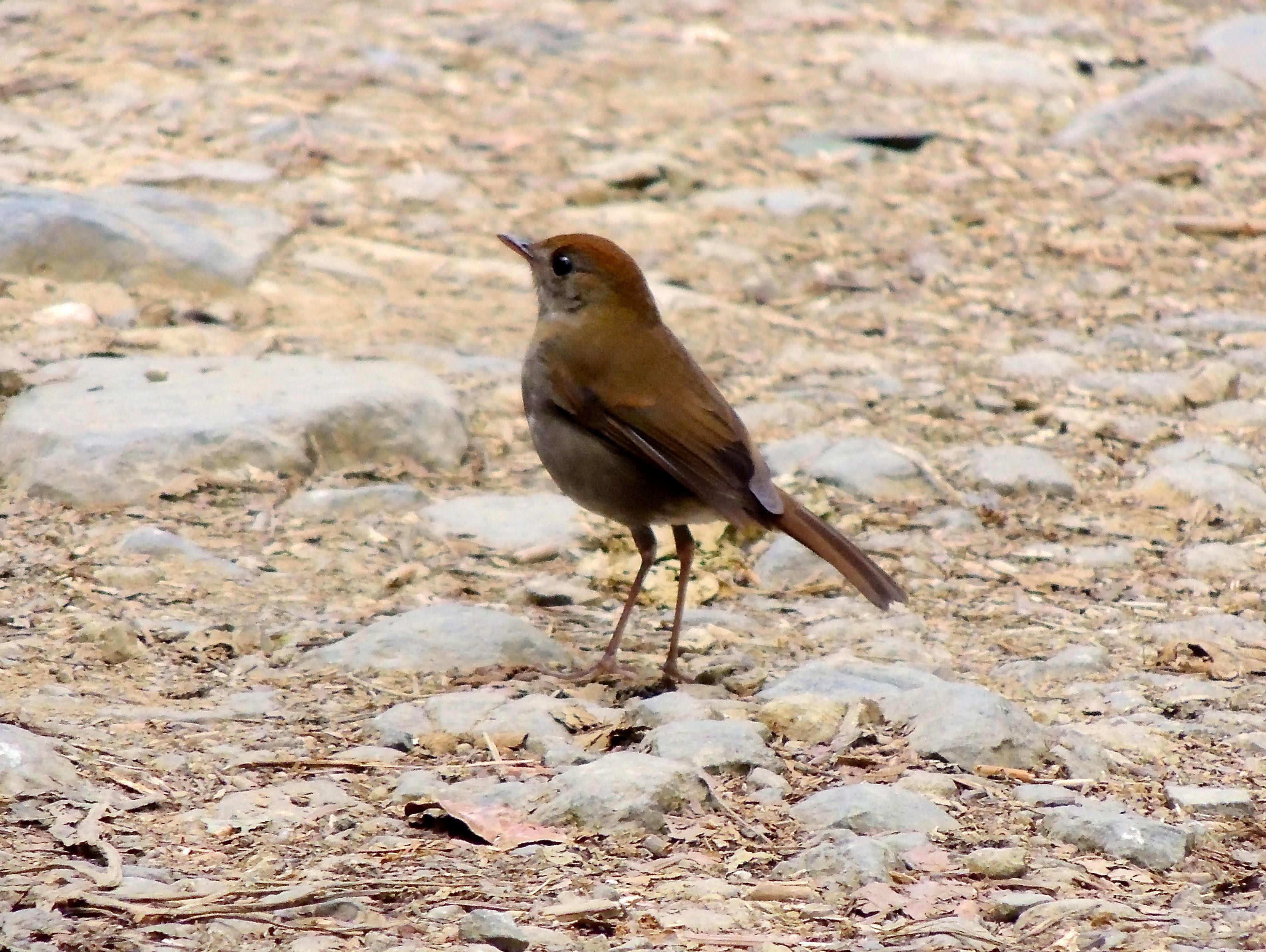 Ruddy-capped Nightingale-Thrush - Photo by William Young
Ruddy-capped Nightingale-Thrush - Photo by William Young
 Collared Redstart - Photo by William Young
Collared Redstart - Photo by William YoungWe returned to the Trogon Lodge for lunch. We walked around the gardens, which had a lot of hummingbirds. A female White-throated Mountain Gem perched in a nearby bush. Volcano Hummingbirds were common, as were Lesser Violet-ears, who used to be called Green Violetears. After lunch, we hiked about a mile along the river. Three Swallow-tailed Kited flew over. A pair of Torrent Tyrannulets were looking for insects from the rocks in the fast-running currents. We looked for dippers but did not find any. We found a Louisiana Waterthrush in a less active part of the river. The Louisiana Waterthrush is an early migrants, so they were probably getting ready to fly north soon.
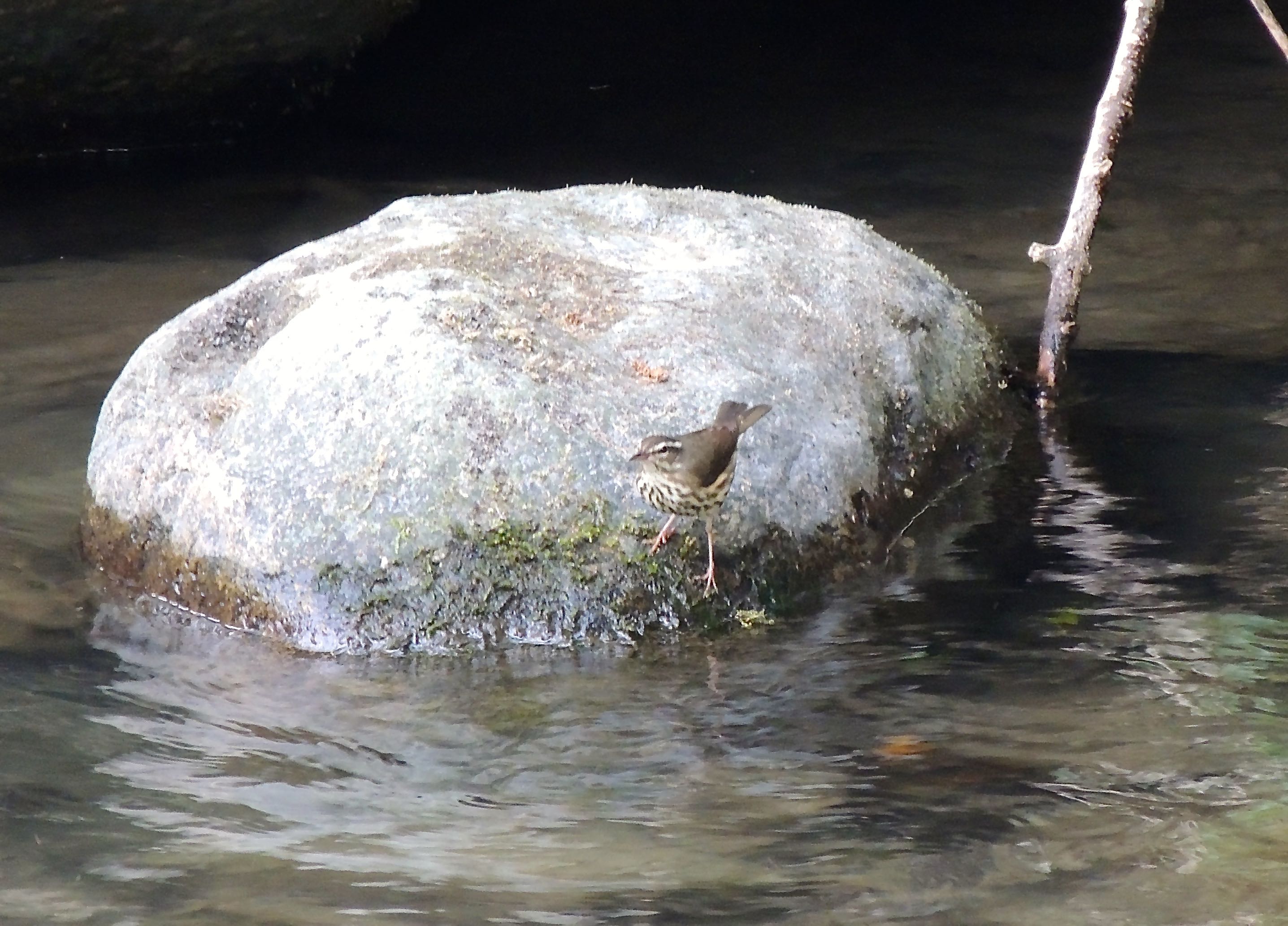 Louisiana Waterthrush - Photo by William Young
Louisiana Waterthrush - Photo by William YoungMost times when we walked past a certain section of the river near the lodge, we saw a Tufted Flycatcher, who is small and has an ochre breast. It has a slight crest which it erects when it gets agitated. It had picked out this section of the river to hawk flies. A lot of Talamanca Hummingbirds were around the lodge — they are a split from the Magnificent Hummingbird. The Talamanca is a large hummingbird and is about the same size as a Tufted Flycatcher. A female Talamanca perched on a branch near the flycatcher, which caused the flycatcher to erect its crest. From behind, the flycatcher looked as if it had a dark Mohawk haircut. The hummingbird and the flycatcher postured near each other for awhile before the hummingbird flew away.
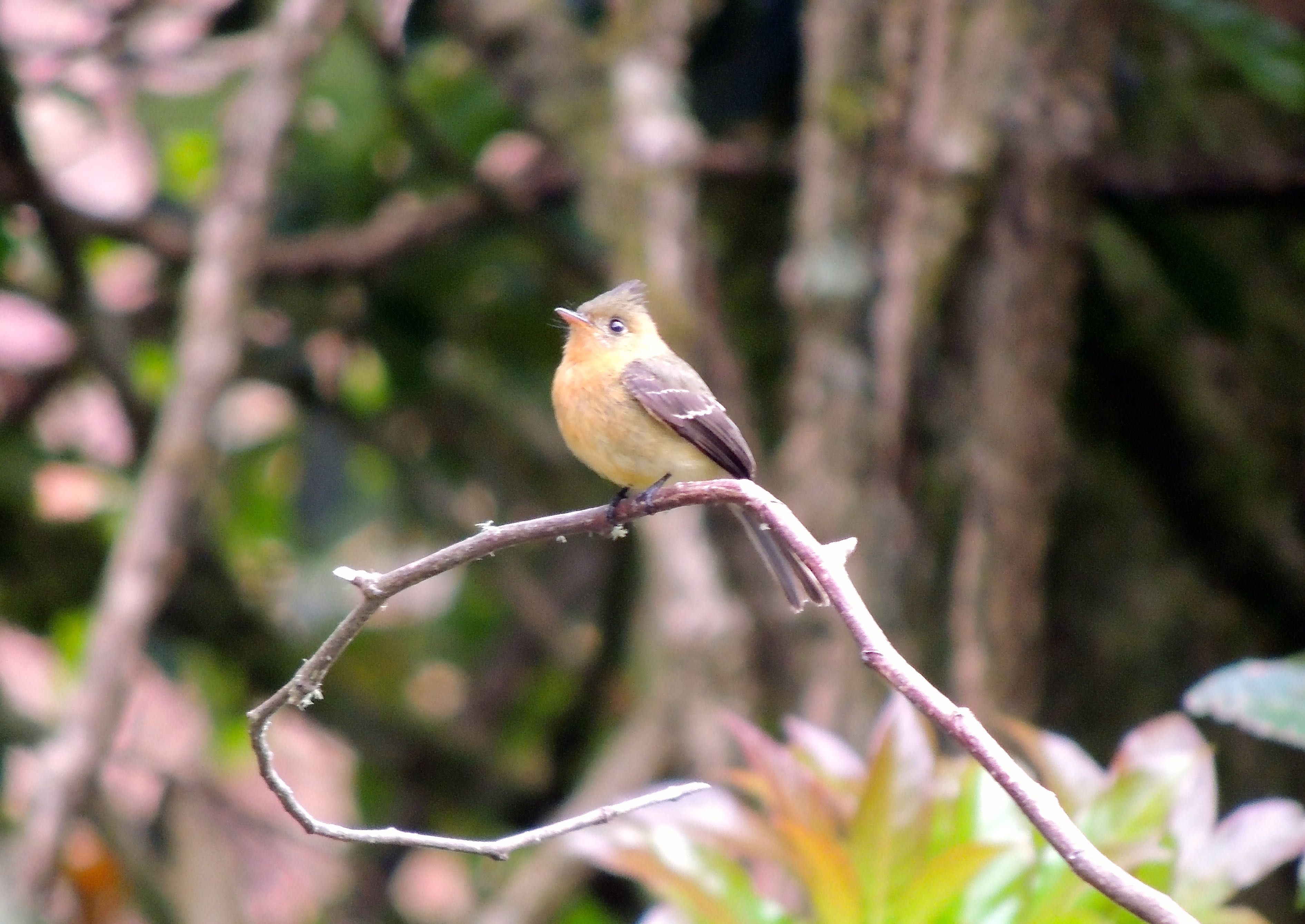 Tufted Flycatcher - Photo by William Young
Tufted Flycatcher - Photo by William Young
March 13
We met Grievin at 5:30 for a bird walk before breakfast. We drove up the hill to see the quetzals, and we had nice looks at two pairs of them. An immature Broad-winged Hawk was perched on a nearby branch and did not seem bothered by our close approach. In the trees were a pair of Long-tailed Silky-Flycatchers. A short way down the hill was a pair of Emerald Toucanets menacing a pair of Acorn Woodpeckers at a nest. This toucanet is on the cover of the first edition of the Garrigues and Dean field guide to Costa Rican birds. In the same area, we saw a Flame-colored Tanager, whose body is the color of a Blackburnian's throat, and we heard a Rufous-browed Peppershrike, who is in the vireo family.
 Acorn Woodpecker - Photo by William Young
Acorn Woodpecker - Photo by William Young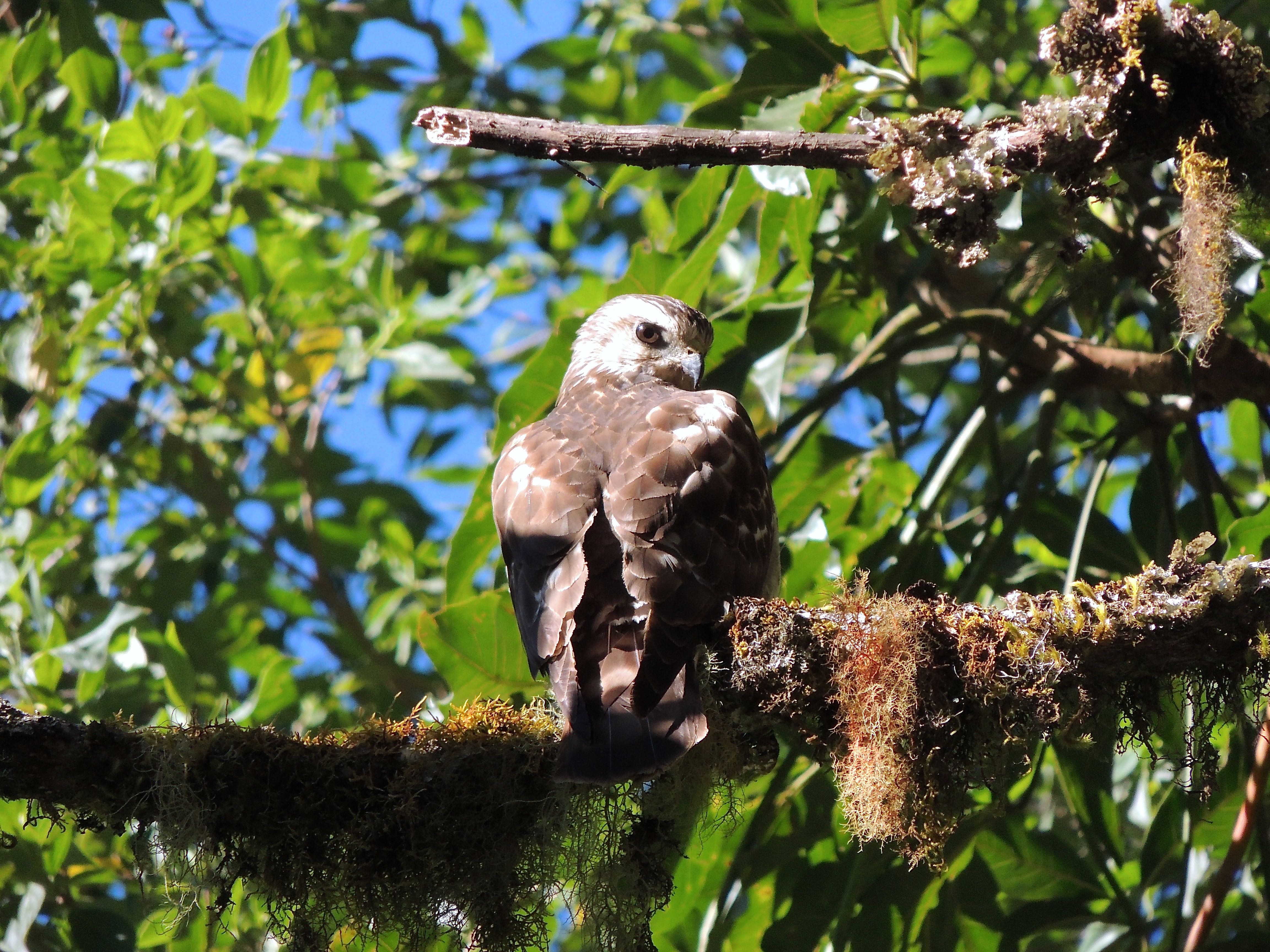 Broad-winged Hawk - Photo by William Young
Broad-winged Hawk - Photo by William YoungAs our van turned into the entrance to the lodge, we saw a couple of Torrent Tyrannulets hopping on the rocks by the road instead of being in their normal habitat in the river. When Ashley later looked at photos she took, she saw that one of the tyrannulets had a fairly large spider clinging to its breast. We had close looks at a Black-capped Flycatcher, a 4-inch flycatcher whose blackish crown contrasts with its olive back. A lot of Slaty Flowerpiercers were working the flowers near our room. They are tiny birds who use their hooked beak to pierce the base of flowers and steal nectar rather than entering by the conventional route and assisting with pollination. I noticed that Blue-and-white Swallows had built a nest near the front window to our room.
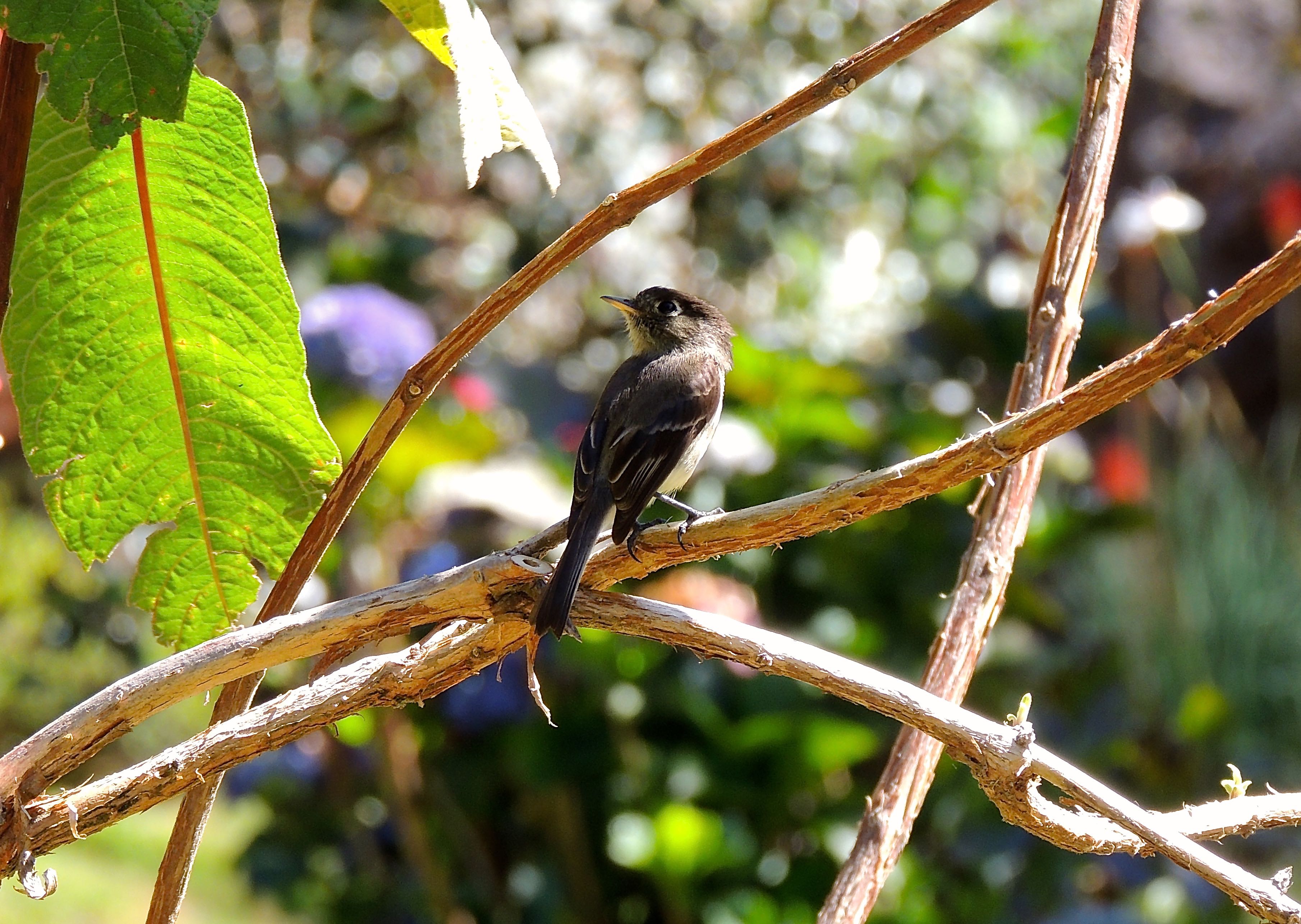 Black-capped Flycatcher - Photo by William Young
Black-capped Flycatcher - Photo by William YoungAfter breakfast, we took another walk with Agniel. We drove with a nice couple from Austria named Theresa and Georg to meet Agniel at the trailhead for the trail that went along the Savegre River toward the hatchery. Agniel saw a pair of Spotted Wood-Quails ahead of us in the path. The female stayed out in the open longer than the male, who is a little more rufous underneath. We had been hearing Black-faced Solitaires a lot, and we finally saw a pair of them. This species has been persecuted, because people trap them for the cage-bird trade. In the same area was a Spangle-cheeked Tanager. The bird was backlit, so I did not have a good look. A Ruddy-capped Nightingale Thrush was on the ground, giving us close looks. In the woods, a Streaked Xenops hung on branches and an Olive-striped Flycatcher perched on a branch. We had a close look at a couple of Black-thighed Grosbeaks, and we saw the back of a female Collared Trogon.
 Spotted Wood-Quail - Photo by William Young
Spotted Wood-Quail - Photo by William YoungWhen we returned to the road on our way back to our car, a Philadelphia Vireo was hopping in a bush in front of us. An Osprey was perched in a distant tree. I had a better look at a Stripe-tailed Hummingbird — because hummingbirds move so quickly, seeing fieldmarks on them is sometimes difficult. I spotted a Yellow-faced Grassquit on a wire.
We brought our suitcases to the registration area and had our final lunch at the Trogon Lodge. We said good-bye to Grievin and headed north toward Quetzal's Paradise, a lodge which was a short drive up Highway 2. I visited there last year, and the hummingbird feeders allow people to get close to some of the highland hummers. Ashley had not yet seen Fiery-throated Hummingbirds, and we had close looks at some. We saw Talamanca and Volcano Hummingbirds, who are at the two ends of the size range. A Lesser Violetear had pollen on its head. From the veranda, we had an eye-level look at a Long-tailed Silky-Flycatcher, and we saw a couple of Acorn Woodpeckers in the distance. We heard a quetzal but did not see it.
We then headed back toward the airport to spend the night in Heredia. Afternoon traffic in San Jose is really bad, and the directions we were getting from Google Maps sometimes had us going in circles. The drive took much longer than we anticipated, but we finally reached the City Express Hotel. We dropped off our luggage, had dinner at a Peruvian restaurant in a nearby shopping center, and then drove to drop off our rental car with Budget. It would have been easier had we been able to return the rental car somewhere near Cartago rather than driving all the way into San Jose and then coming back the same way for the next leg of our trip. But there are not many places in Costa Rica to return rental cars.
March 14
We ate breakfast and finished packing before our ride to Rancho Bajo arrived at 8. We were picked up by Eduardo, who married into the family who owns Rancho Naturalista. On the ride, we were caught in traffic a few times around San Jose. While we were stopped, I spotted a Crimson-fronted Parakeet, which was a new bird for Ashley. We also saw a Baltimore Oriole in a tree. As we drove toward Rancho Bajo, I saw a few White-winged Doves on wires. Ashley did not see any of them and had to wait another week before she had a good look at one. As we drove on, we passed a facility that processed sugar cane. In one of the structures, I saw a pair of Gray-breasted Martins building a nest.
Rancho Bajo is the home of John and Kathy Erb, who started Rancho Naturalista in the mid-1980s. Their daughter Lisa now manages Rancho Naturalista, and John and Kathy live in Rancho Bajo, which is just down the road. We arrived a little before lunch. A short time later, Lisa showed up with Mercedes Alpizar, whom we were hiring as our guide. Mercedes, whose nickname is Meche, had been my guide for the last five days of my trip last year.
The grounds around Rancho Bajo are lovely. Verbena bushes are next to the house, and some guests from Rancho Naturalista come to see the hummingbirds flitting among the flowers. The symbol of Rancho Naturalista is a tiny hummingbird called a Snowcap, one of the most sought after species. The male is the color of port wine, with a flat white head. Snowcaps are usually difficult to find, except at Rancho Bajo, where they regularly come to the verbena. Rancho Bajo has hummingbird feeders that attract White-necked Jacobins, Green-breasted Mangos, and Rufous-tailed Hummingbirds. The Rufous-tailed Hummingbirds frequently chase the Snowcaps. Blue-and-white Swallows nest under the eaves. Great Kiskadees can be heard calling, and Common Tody-Flycatchers are often in the verbena with the hummingbirds, Tennessee Warblers, and Variable Seedeaters. One sees and hears Brown Jays and Gray-headed Chachalacas. The fruit feeders are visited by tanagers, including Blue-gray, Palm, and Passerini's. The Passerini's are the most numerous; they used to be lumped with the Cherrie's Tanagers we saw in San Isidro, and they occupy a similar niche near Rancho. Many displaying Montezuma Oropendolas can be heard, along with the cricket-like call of Keel-billed Toucans.
Right before lunch, we saw a female Black-crested Coquette. The female has a white band across her rump and spots on her belly. We did not see any male coquettes during the trip. After lunch, Ashley and I saw a Black-cowled Oriole in one of the trees by the house. We walked down the drive to get to the road leading to Rancho Naturalista. Along the road is a tree where a Roadside Hawk frequently perches, and it was there. In the trees, we saw a pair of Black-headed Saltators, whose distinctive call sounds like a squeaky kiss. On the way up the hill, we saw a Pale-billed Woodpecker, who looks like a Pileated with a red head. We saw Social Flycatchers, who are common along the road as well as at Rancho Bajo. Yellow-bellied Elaenias are also common — they often appear to have a ruffled crest which sometimes looks split.
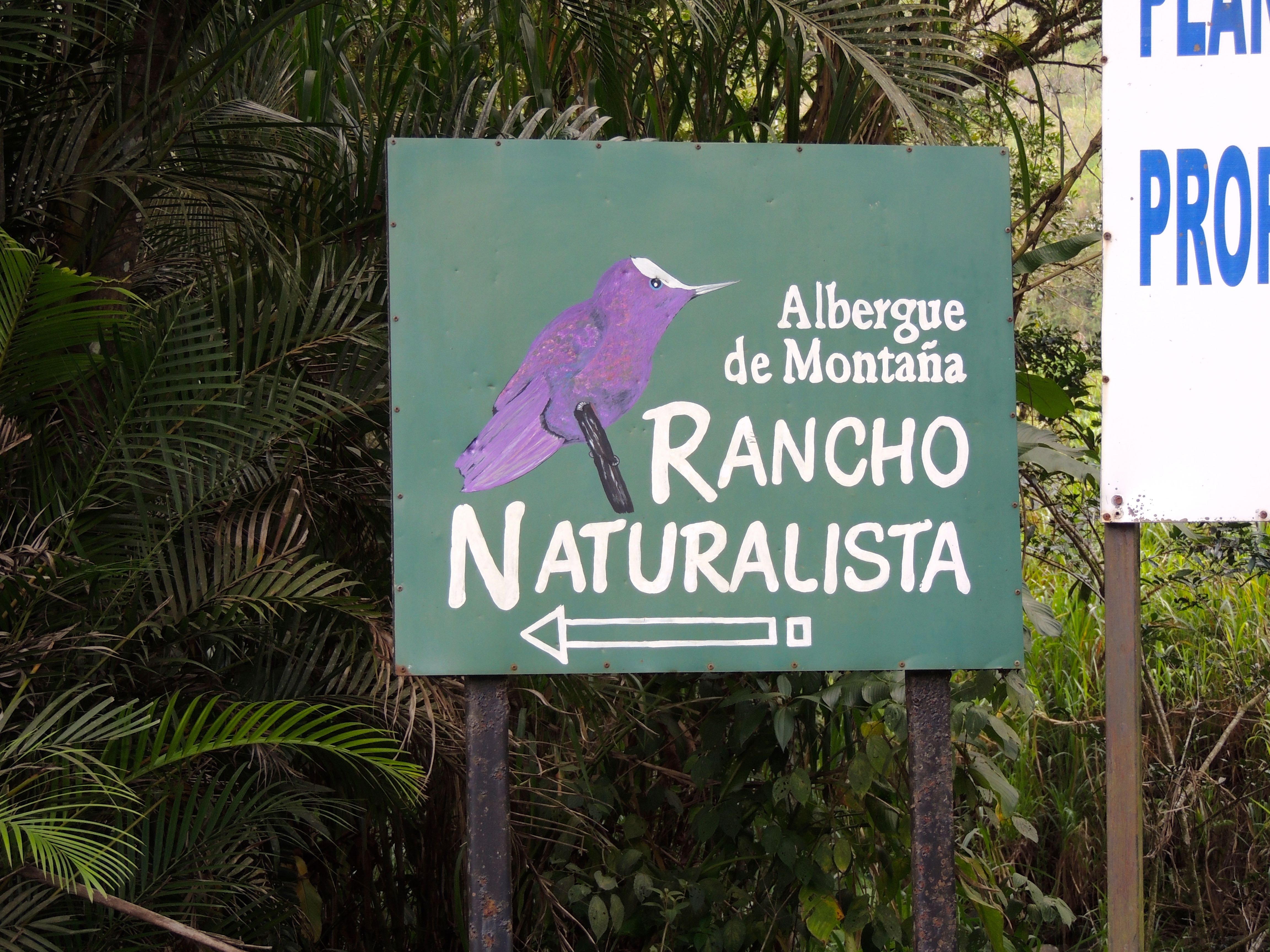 Rancho Naturalista Sign - Photo by William Young
Rancho Naturalista Sign - Photo by William YoungOn the way to Rancho Naturalista, we stopped at the home of Wayne Easley, who is a photographer and guide. His daughter was visiting, so we could not hire him to guide us, but we went to his house so that Ashley could see some of the activity around his feeders. On the road to his house, we walked past a White-collared Manakin lek. We heard the joy-buzzer sound that they make with their wings, but we did not see any manakins until we got near to the house. In the trees near the house is a Montezuma Oropendola colony, which has a cluster of long, hanging nests. Numerous males were displaying, making their distinctive sound while appearing to fall off a branch. A Giant Cowbird was near the feeders — this species often parasitizes the oropendolas. Wayne has an oropendola nest hanging next to his house, and a pair of Olive-backed Euphonias were flying into the entry hole, either because they were using it to nest or were considering using it. White-tipped Doves fed at some of the ground feeders. In the trees next to the house was a male Thick-billed Seed Finch — an all black bird with a small white wing patch and a very large bill.
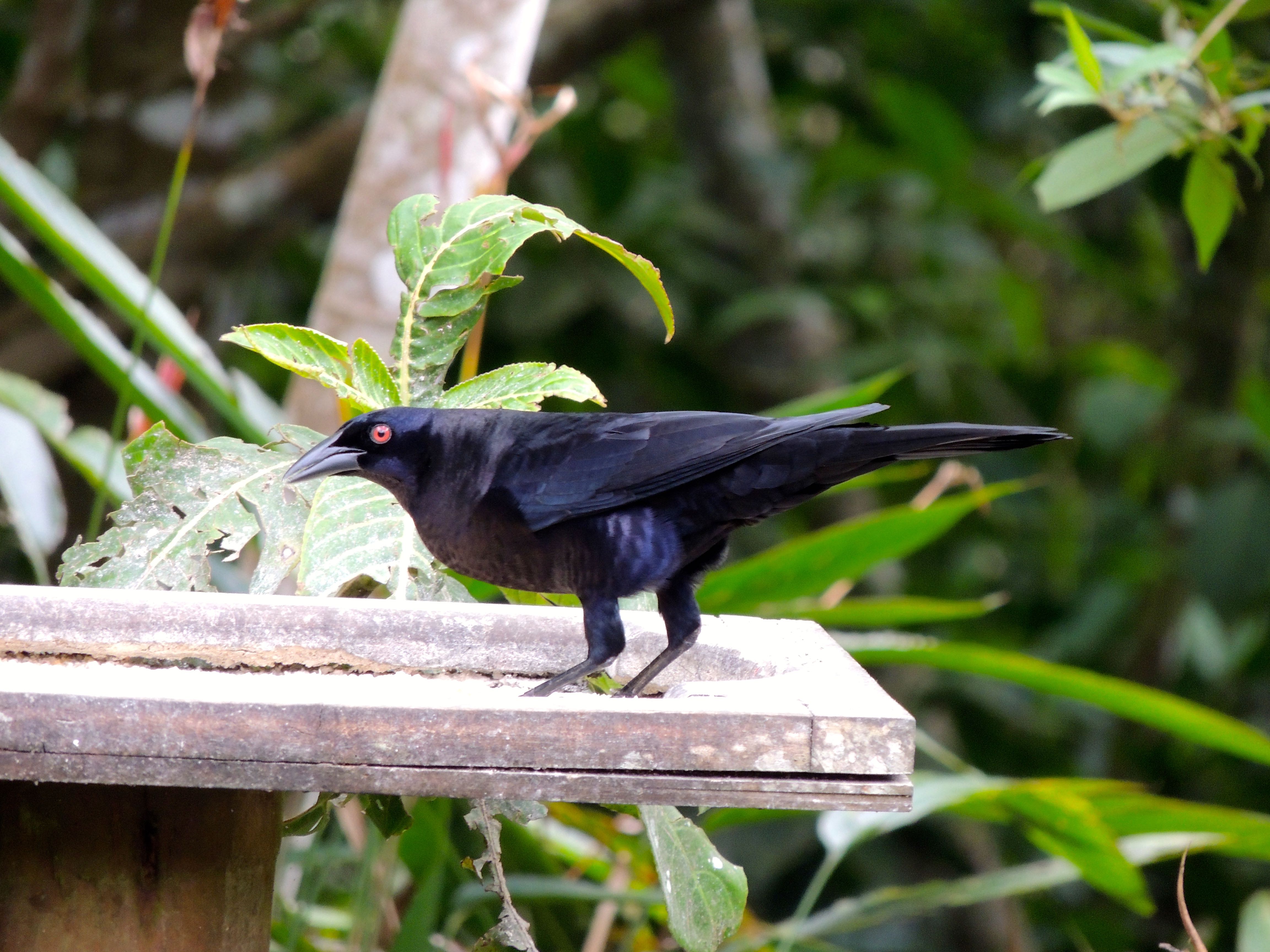 Giant Cowbird - Photo by William Young
Giant Cowbird - Photo by William Young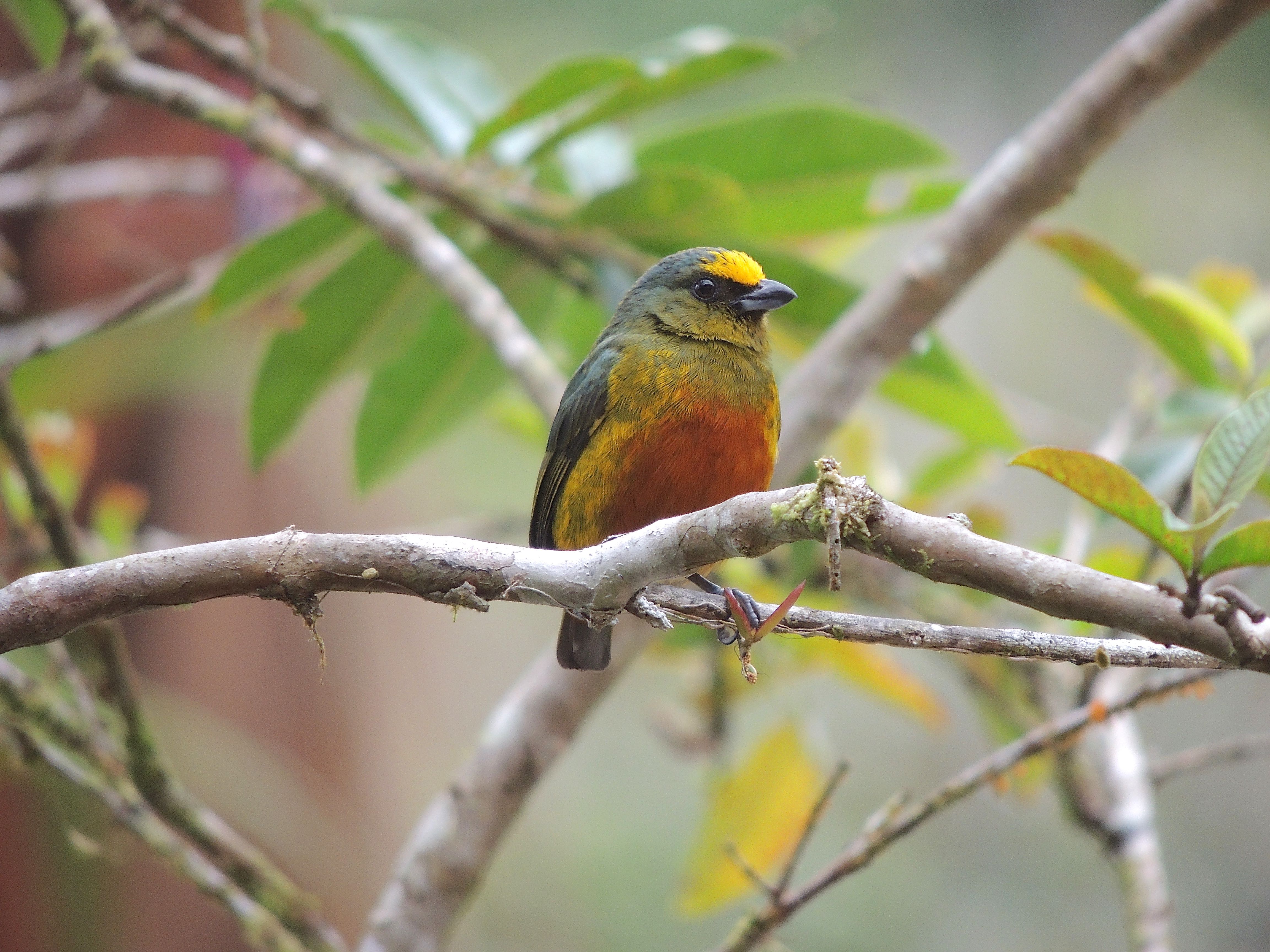 Olive-backed Euphonia - Photo by William Young
Olive-backed Euphonia - Photo by William YoungAt Rancho Naturalista, we walked to the hummingbird pools, which are in the forest. The area has some good birds, but there is not much light during the late afternoon, making it difficult to see detail or to take good photos or video of them. We saw a Purple-crowned Fairy, who came to bathe. It has an elongated body which is green on the back and white below, with a purple crown. We looked almost straight down on one who appeared to be doing ballet on the water.
March 15
Throughout the night, we heard Common Potoos calling in the distance. We heard them on most evenings, but we did not see any during the trip. We met Meche at the deck at Rancho Naturalista at 5:45. The deck has hummingbird feeders, and we saw White-necked Jacobins, Green-breasted Mangos, and Crowned Woodnymphs — all are common. The woodnymph used to be called the Purple-crowned Woodnymph. We saw a young Green-crowned Brilliant, who has a buffy mark next to its bill. We saw a Green Hermit, who is large with a very long bill. Despite its size, it sometimes is bullied by smaller hummingbirds. An Orange-billed Sparrow was on the ground; some Costa Rican sparrows seem prettier than the northern sparrows, although some of our more attractive sparrows are given other names, such as longspur or towhee. Yellow-faced Grassquits were hopping around. The most common warbler was the Chestnut-sided, which was the case throughout our trip.
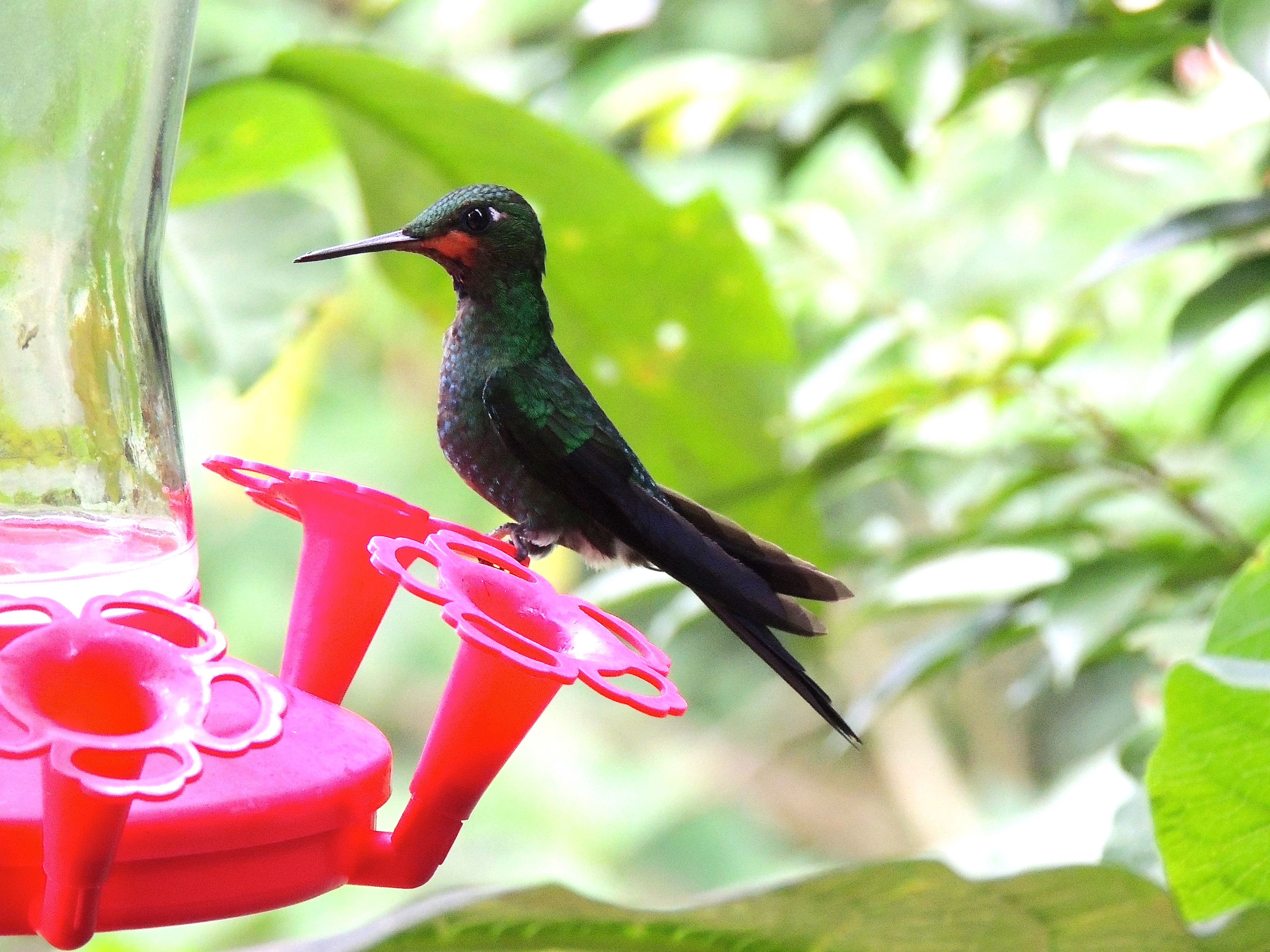 Green-crowned Brilliant - Photo by William Young
Green-crowned Brilliant - Photo by William YoungWe went to the moth sheet, which sometimes attracts songbirds. During the trip, we heard a lot of White-breasted Wood-Wrens, and the moth sheet is a good place to see them. Red-throated Ant-Tanagers hopped on the ground, and a Dusky-capped Flycatcher lurked nearby. The Dusky-capped is one of the Myiarchus flycatchers. Later in the morning, we saw a Great Crested Flycatcher, who is a larger Myiarchus. We also saw a Yellow-bellied Flycatcher, who is the most common Empidonax flycatcher here. We could hear a Rufous Motmot. Two species of Woodcreepers worked the trees near the light — the Plain Brown and the Streak-headed.
We headed back toward Rancho Bajo for breakfast. Near the bridge at the base of the road leading to the house was a pair of Tawny-chested Flycatchers. The light was bad, so I did not get a good look at them. The call sounds a bit like the Woody Woodpecker song. The Tawny-chested is endemic to Costa Rica and Nicaragua, and it is one the species some birders seek because of its uncommonness. A Cinnamon Becard was in the trees by the house. We heard the single-note whistle of the Piratic Flycatcher, as we did through much of our stay.
After breakfast, John drove Meche, Ashley, and me to Turrialba to visit an agricultural research center called CATIE, which stands for Centro Agronómico Tropical de Investigación y Enseñanza, which loosely translated means "Research and Education Center for Tropical Agricultural". On the way, we stopped at a bridge in La Suiza to look for Sunbitterns. We saw a pair, and one flew by us, showing off the beautiful sunburst pattern on its wings. In the water were a Little Blue Heron and a Snowy Egret.
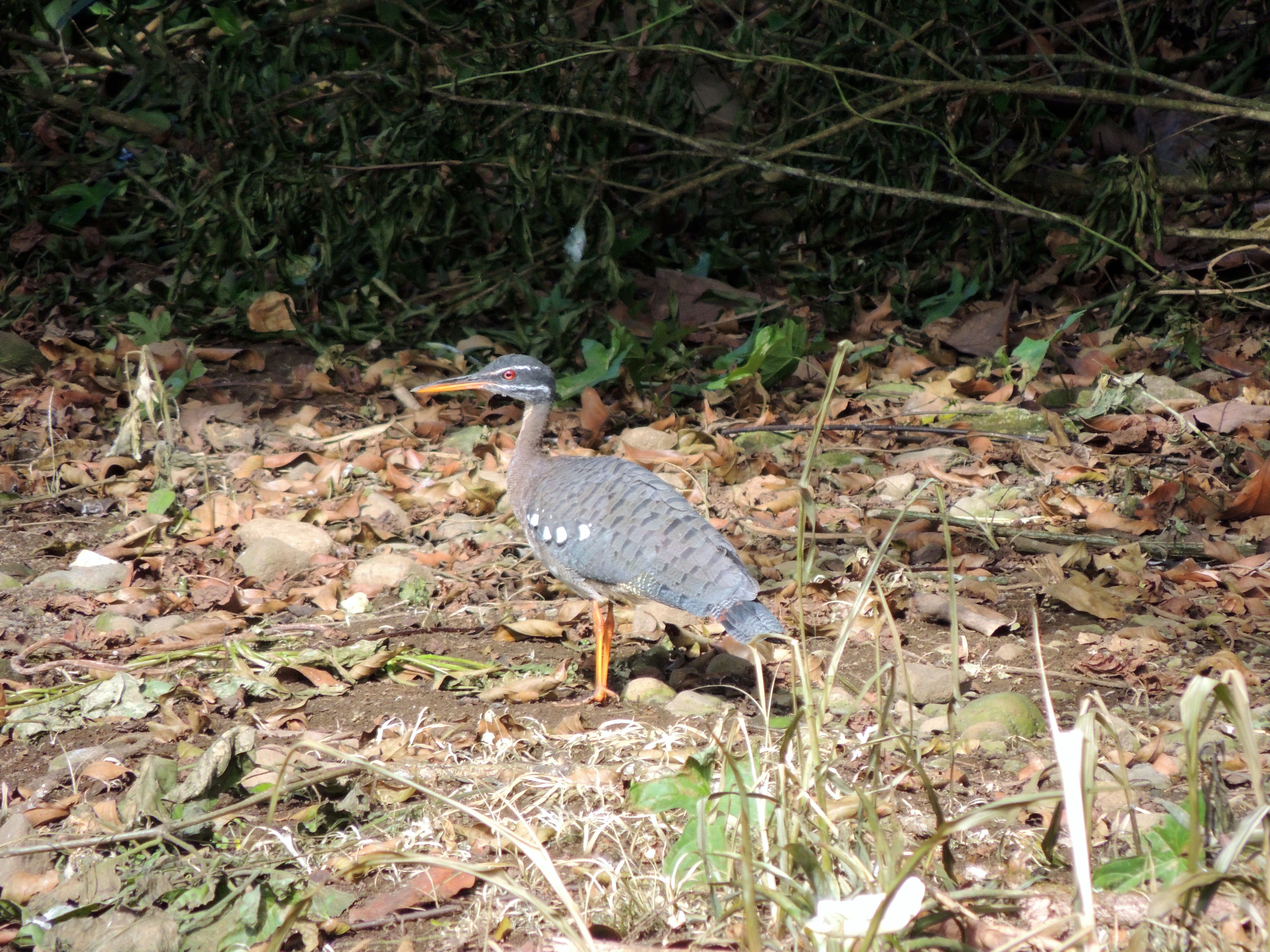 Sunbittern - Photo by William Young
Sunbittern - Photo by William YoungWe parked near the lake, which has a large mixed breeding colony of waders and other species. One tree had more than a hundred Cattle Egrets. We saw a lot of Cattle Egrets in fields throughout the trip, but the ones at CATIE were in full breeding plumage, with plumes and a brilliant red bill that is yellow at the tip and purple at the base. A few pairs of Great Egrets nested in the trees along with Black-crowned Night-Herons. I had closer looks at Boat-billed Herons than I have ever had; I usually have seen them through a telescope sleeping in a distant nest, but the ones at CATIE were awake and in a relatively close tree. They have a long black crest that blows in the wind. A couple pairs of Anhingas also nested in the area; the breeding males have bright blue facial skin. A Great Blue Heron stood on the shore. Quite a few Purple Gallinules of various ages were around the edge of the lake. A lot of Northern Jacanas, adult and young, walked on the lily pads with their long spindly toes. They show a lot of aggression toward one another. Spectacled Caimans were in the water, and some looked very young.
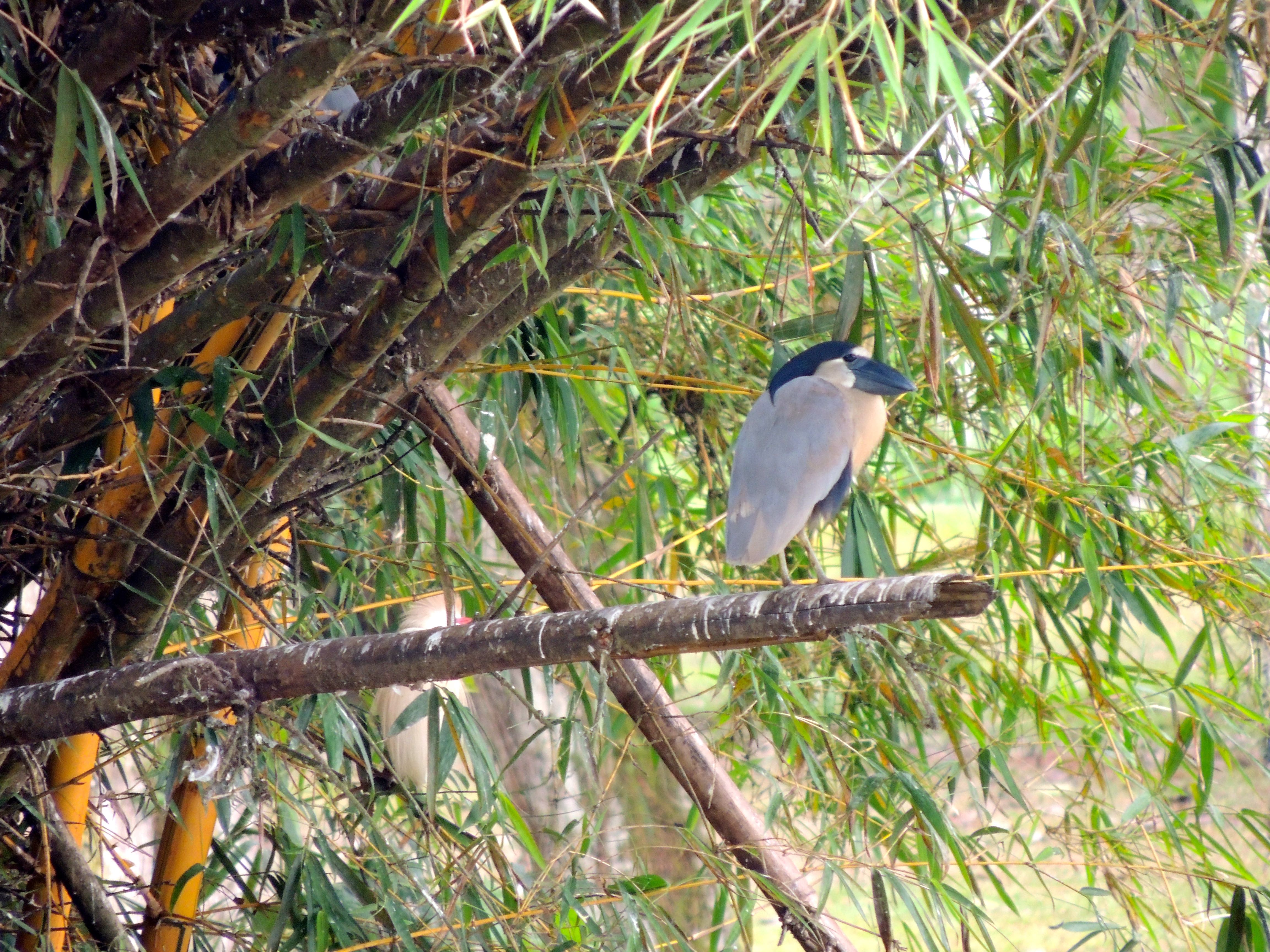 Boat-billed Heron - Photo by William Young
Boat-billed Heron - Photo by William Young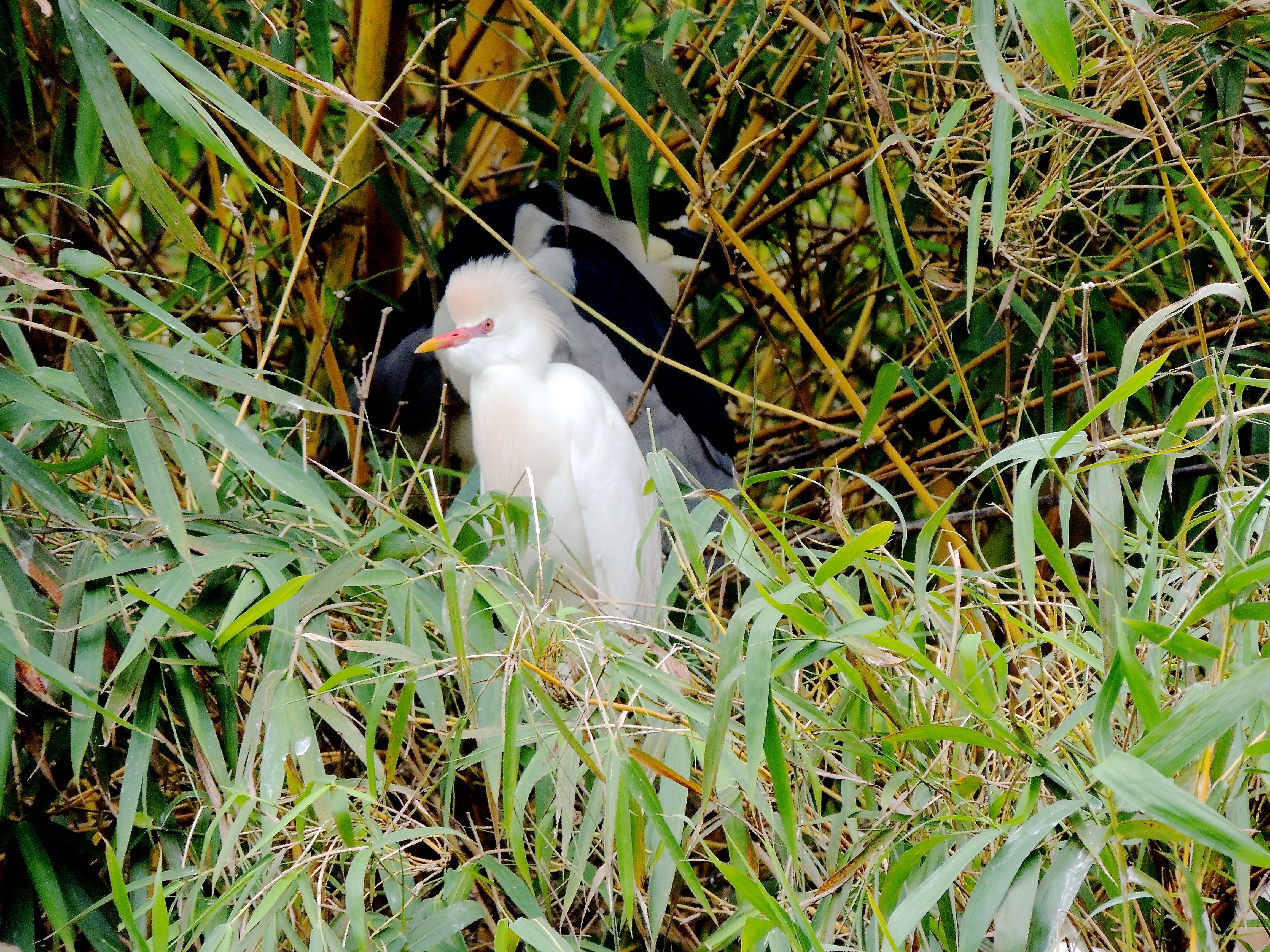 Cattle Egret and Black-crowned Night-Herons - Photo by William Young
Cattle Egret and Black-crowned Night-Herons - Photo by William Young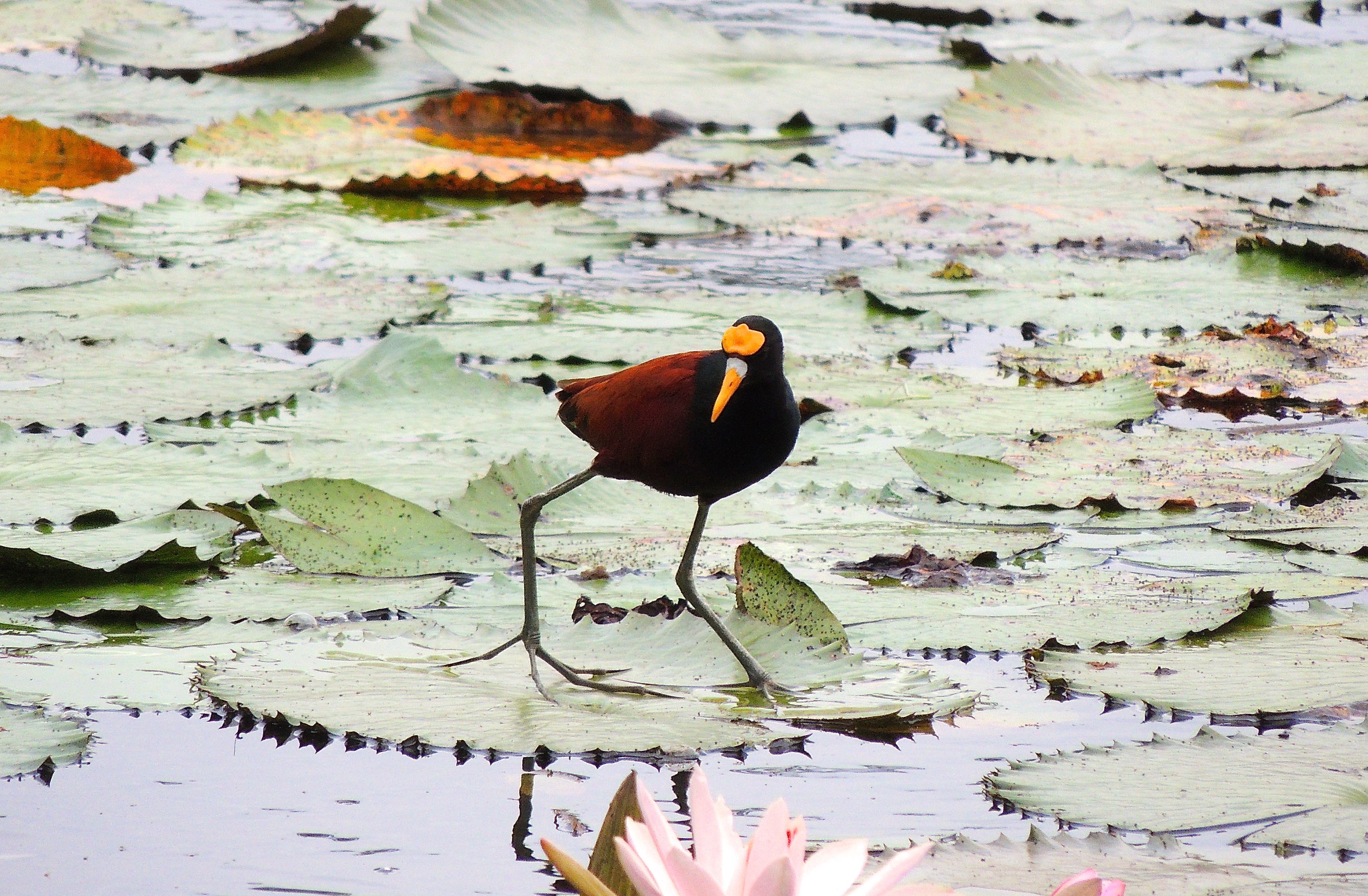 Northern Jacana - Photo by William Young
Northern Jacana - Photo by William YoungThe area around the lake was also productive. We saw a couple of Collared Aracaris, who were on the ground before flying into a tree. A few Spot-fronted Swifts flew over; I could not have identified them on my own. In one area, we ran into a fairly large feeder flock that had a lot of variety. It included Chestnut-sided, Golden-winged, Yellow, and Prothonotary Warblers. Meche found the Prothonotary — when I visited CATIE last year around the same time, she had not yet ever seen one. A Plain-colored Tanager was mixed in with the Blue-gray, Palm, and Golden-hooded Tanagers; this was the only Plain-colored I saw on the trip. In the flock was a Black-cowled Oriole, a Yellow-throated Vireo, and a female Scarlet-thighed Dacnis, along with a couple Common Tody-Flycatcher. A Cocoa Woodcreeper was in a nearby tree.
In a tree farther away was a Boat-billed Flycatcher. One way to tell it from the more common Great Kiskadee is that the kiskadee has rufous on its wings, while the Boat-billed does not. In the trees were Red-billed Pigeons, who are wine-colored. And near where we parked, a flock of Crimson-fronted Parakeets landed in a tree, and Meche got some in the scope.
We headed to the botanical gardens. We saw a couple of perched Roadside Hawks, who were the most common raptor on the trip. A Broad-winged Hawk flew over. A second-year male American Redstart was in the trees, along with a Chestnut-sided Warbler, Yellow-throated Vireo, and Great Crested Flycatcher. A House Wren hopped around at eye level near where we walked. We had nice looks at Melodious Blackbirds and heard them vocalizing. Cannonball Trees were in the area where we walked; they are so named because their fruit looks like cannonballs.
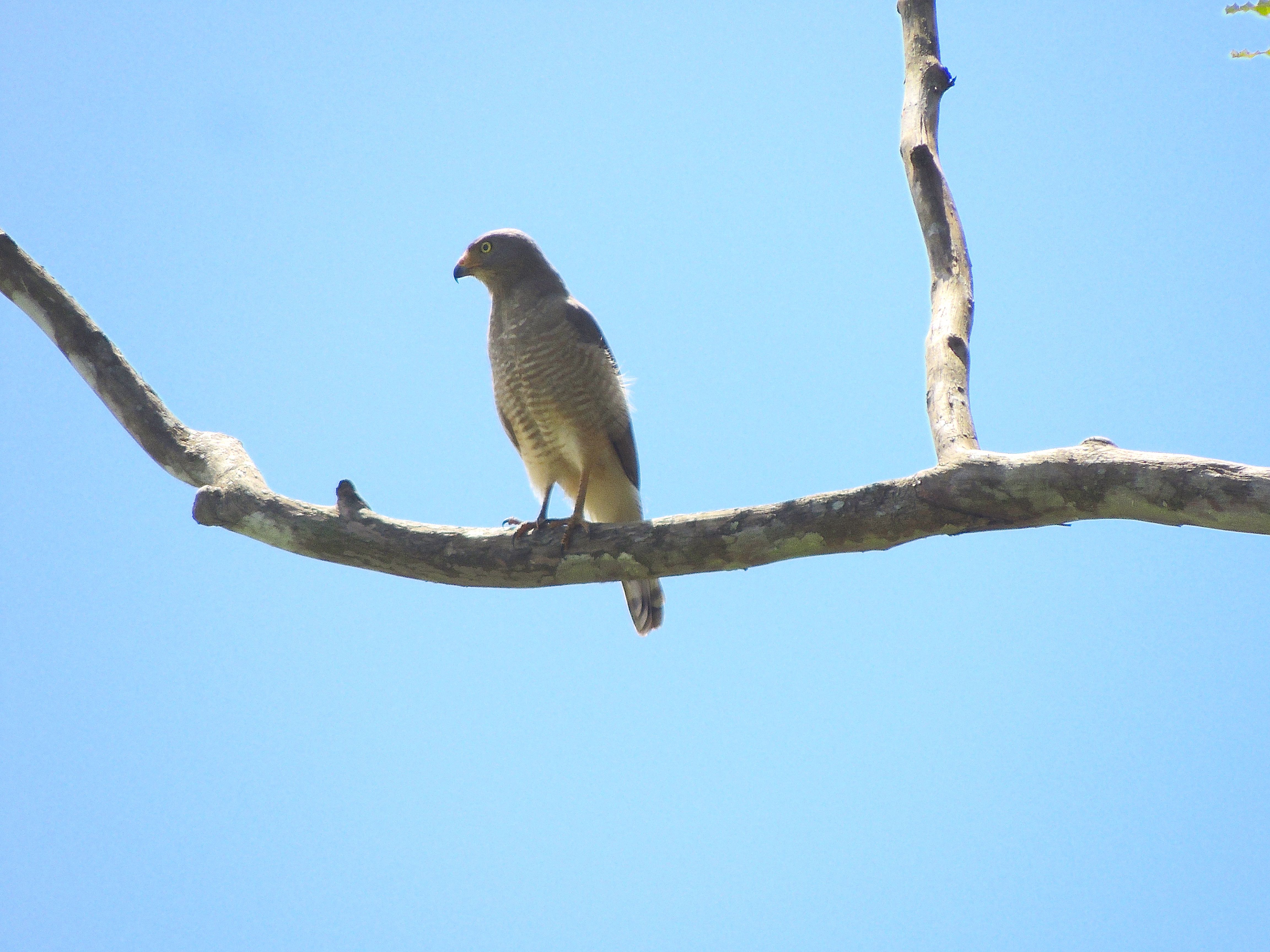 Roadside Hawk - Photo by William Young
Roadside Hawk - Photo by William Young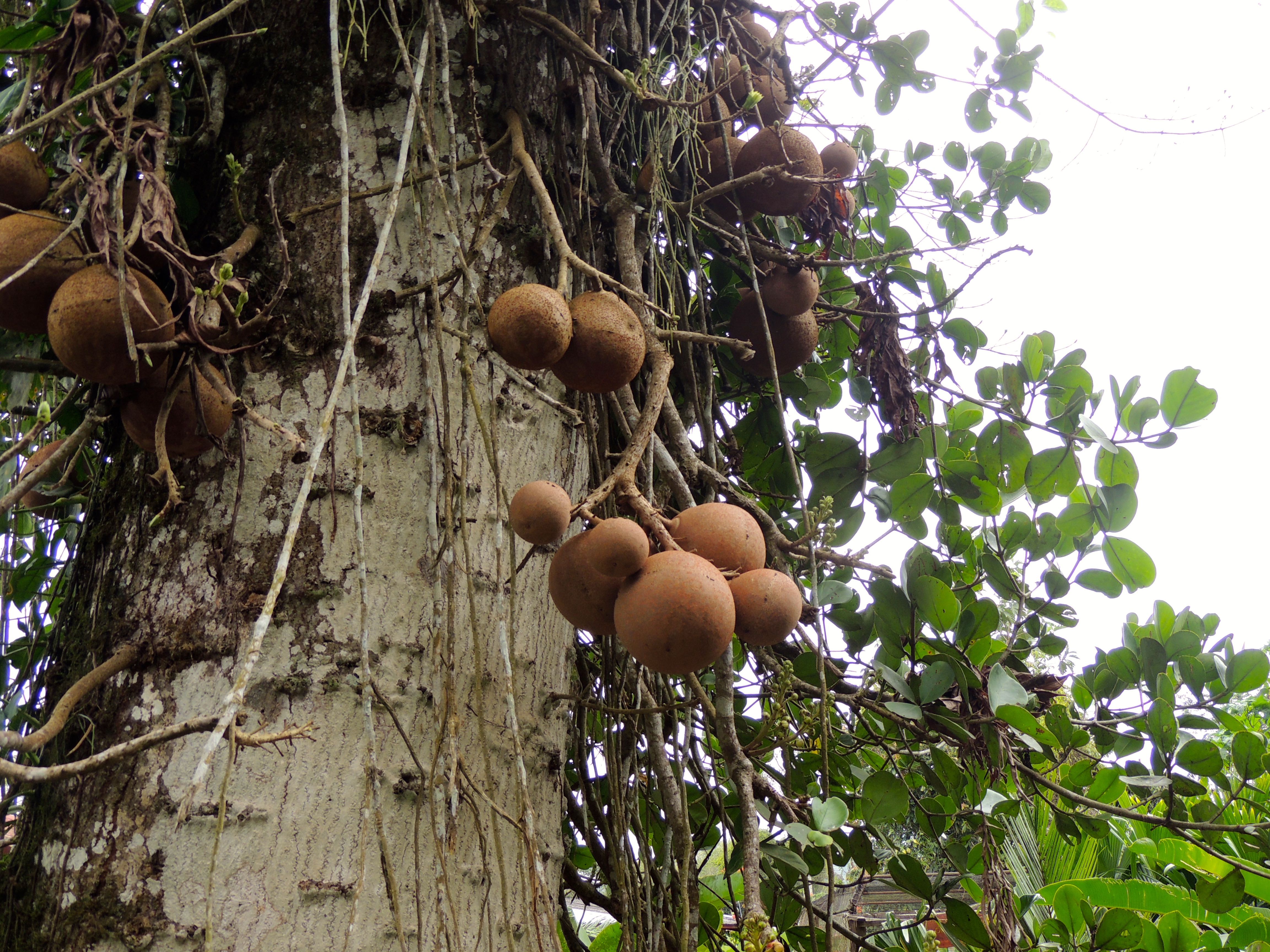 Cannonball Tree - Photo by William Young
Cannonball Tree - Photo by William YoungOn the way back to Rancho Bajo, we stopped along the road to look at a Crimson-collared Tanager. The colors seem more saturated than on a Scarlet Tanager. We had lunch and took a walk toward Rancho Naturalista, stopping near the entrance road to Wayne Easley's house. We heard a lot of displaying White-collared Manakins. In one tree, we saw both a White-winged and a Cinnamon Becard. We had nice looks at a male Yellow-throated Euphonia. With euphonias, you can separate the species by looking at the throat, crown, and vent. A Golden-olive Woodpecker was in one of the trees. At Rancho Naturalista, two Bananaquits foraged in the bushes. A Wood Thrush came to bathe and drink from the pond in front of the dining area.
March 16
A door in our room led to a veranda which overlooked gardens and feeders. Directly outside the door, a species of short-tailed long-nosed bat hung from the ceiling. Keeping the light on outside during the night attracted insects and made the bat less willing to leave. On the outdoor stairs leading up to our room was a Monarch who was about to emerge from its chrysalis.
 Short-tailed Long-nosed Bat - Photo by William Young
Short-tailed Long-nosed Bat - Photo by William YoungAshley and I went out early to look at the verbena bushes. Among the hummingbirds were a pair of Green Thorntails, who have a white band on the rump like the Black-crested Coquette. The male has a long pointed tail that has a thorny appearance. As we were leaving the Rancho Bajo property, we heard both Bay Wrens and Black-throated Wrens. We also heard the orgasmic call of the Bright-rumped Attila. Black-striped Sparrows were singing. Their loud song starts slowly and builds until it eventually seems to erupt. We heard the song a lot as part of the dawn chorus each morning.
We met Meche and walked to Wayne Easley's house. A highlight was seeing two Rufous Motmots, including one who came to the feeders. In photos, Ashley later noticed that they have a slight serration on their bill, which is not needed when they eat bananas. A Red-billed Pigeon fed at one of the feeding areas on the ground. A Keel-billed Toucan perched nicely in a tree near the Oropendola nests. We had good looks at a Yellow-olive Flycatcher, who has yellow wingbars, a gray head, and a light eye. A Tropical Parula was in the trees behind the feeders. It looks similar to the Northern Parula, but it has a dark patch over the eye.
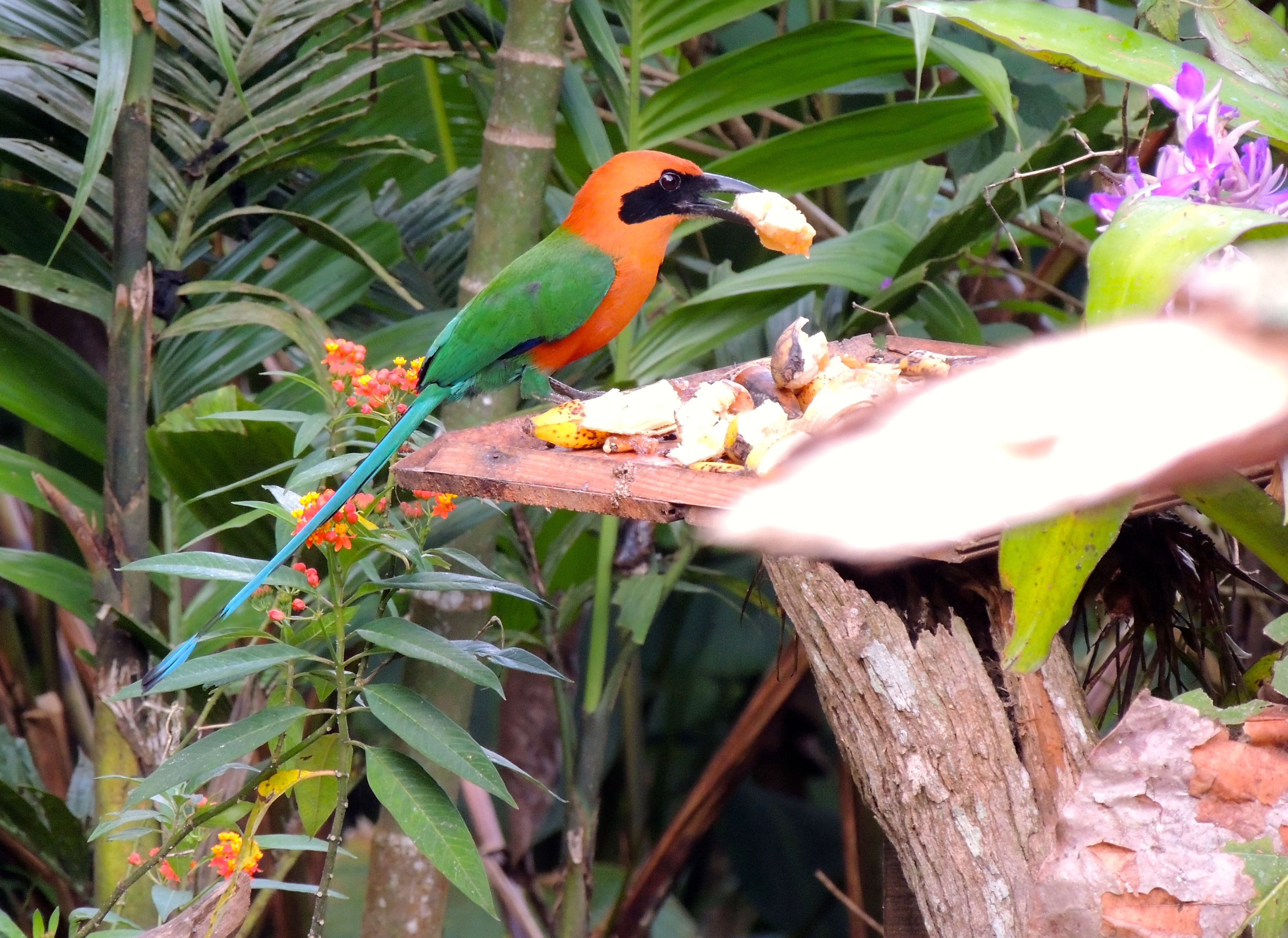 Rufous Motmot - Photo by William Young
Rufous Motmot - Photo by William Young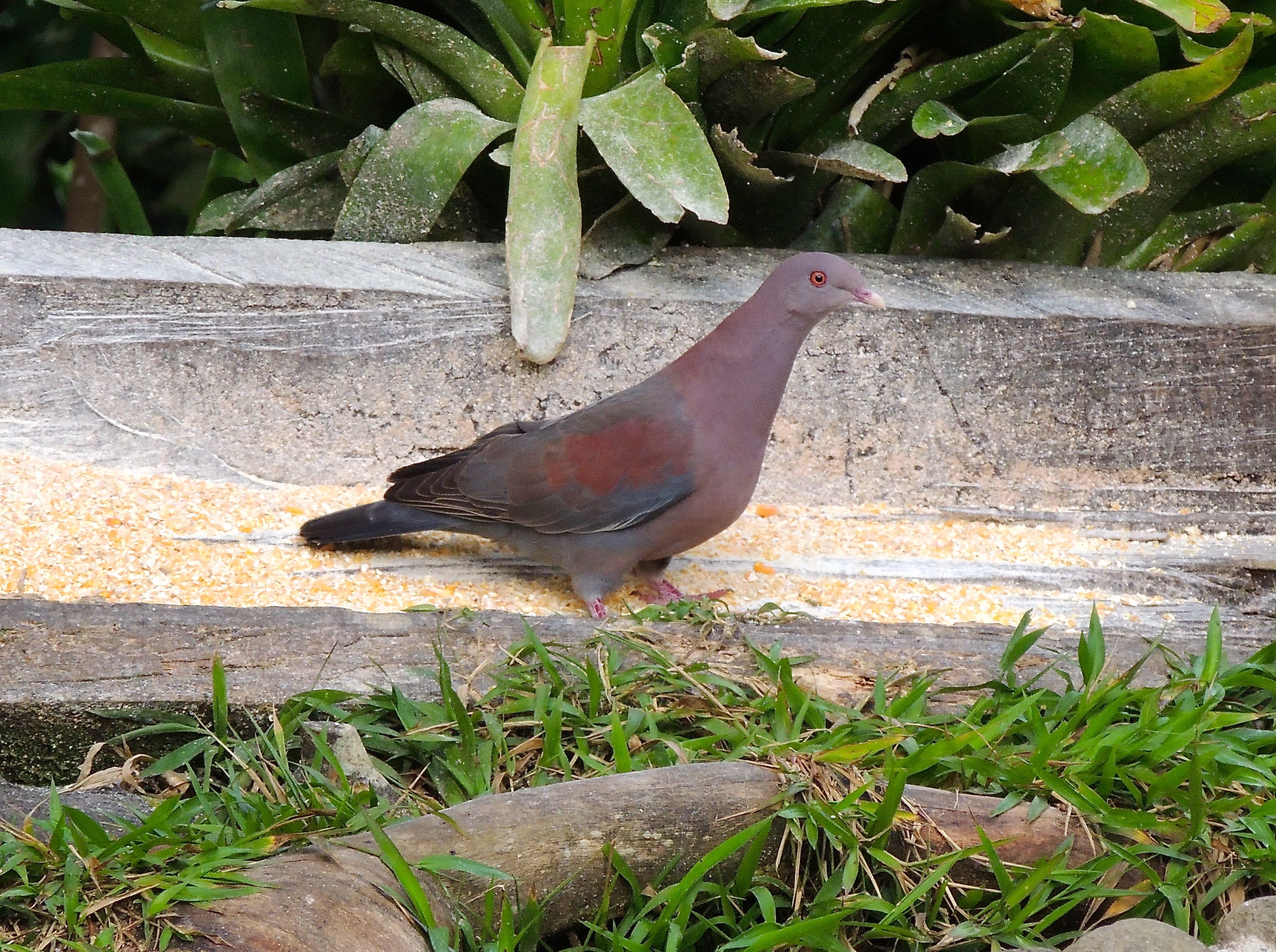 Red-billed Pigeon - Photo by William Young
Red-billed Pigeon - Photo by William YoungAfter breakfast, we took a short drive from Rancho Bajo to the base of Cerro Silencio in the Rio Tuis valley. We walked along the river and saw a lot of good birds. Near the beginning were a Sunbittern and a Black Phoebe, both of whom like to be in the water. We heard a male Gartered Trogon and eventually found him perched in a tree. A distant tree had a Collared Aracari and some Keel-billed Toucans.
The area has many tanagers. In addition to Passerini's, Blue-gray, Palm, and Golden-hooded, we saw Bay-headed and Black-and-yellow Tanagers and a male and female Green Honeycreeper. The Black-and-yellow is endemic to Panama and Costa Rica. It is about the size of a warbler, and it moves like one. I think the Bay-headed is one of the prettiest tanagers, with its blue and green body and brown head. We also saw a lot of warblers. Even though there were tanagers around, I focused on a male Blackburnian Warbler who was flitting in the same tree. I get a thrill every time I see their bright orange throat, and I would rather look at a Blackburnian than almost any other bird species. Rio Tuis was the only place I saw Slate-throated Redstarts last year, and I saw some this year. The species has a rufous cap and white outer tail feathers like the Collared Redstart, but it has a dark face — it can more easily be confused with a Tropical Parula, who was also present. We also saw a Yellow-throated Vireo.
A lot of Chestnut-headed Oropendolas flew back and forth. They are smaller than the Montezuma, have a pale bill, and no face markings. Montezuma Oropendolas were present in smaller numbers. We saw both Shiny and Bronzed Cowbirds. They are about the same size, with the Shiny having a red eye and the Bronzed having a dark eye. The Bronzed has moved into Costa Rica in recent years — in the first edition of the Garrigues and Dean guide, it is included in a plate at the back of the book with additional species. We saw a Melodious Blackbird, who is larger and leaner than either of the cowbirds. Some Groove-billed Anis were in the fields — they look more elongated than other black species of birds, and their tail is longer.
We saw a number of flycatchers. A few Tropical Kingbirds, who were common throughout our trip, perched on branches and wires. The area had both Social and the Gray-capped Flycatchers, who can be difficult to tell apart. The Gray-capped has gray rather than brown on its head, which is sometimes difficult to see in the field. Both species nest around Rancho Bajo. Kiskadees were calling all over the place. We saw a Piratic Flycatcher (aka Anti-social Flycatcher, because it steals the nests of other species), who has a striped head and a streaked breast. We saw a Sulphur-bellied Flycatcher, who looks similar to the Piratic but has a rufous tail, a streakier back, and a yellowish rather than a whitish streaked breast. We saw an Olive-striped Flycatcher — we had seen one previously in the highlands. It is a small olive flycatcher with a streaked breast and a white spot behind the eye. We saw our first Ochre-bellied Flycatcher of the trip. One often sees them bathing in streams; they bathe in the hummingbird pools at Rancho Naturalista, and I saw them bathing at Canopy Camp in the Darien in Panama. They are dirty brown and do not look like many other flycatchers. Both a Yellow-bellied Flycatcher and a Yellow-bellied Elaenia were in the area. We saw a Paltry Tyrannulet; it eats mistletoe berries, and when it defecates, the seeds from the berries stick to the bird's rear end. When wiping them off against a leaf or branch, it spreads mistletoe. A species in Australia called the Mistletoebird does the same thing. The Paltry Tyrannulet used to be considered part of the same species as the Mistletoe Tyrannulet before being split and given the new insulting name.
We saw both Northern and Southern Rough-winged Swallows. The Southern has a light rump, and the throat is peach colored. The rump is difficult to see unless the bird banks. A couple of Tropical Gnatcatchers flitted around; they have a black cap but otherwise look and act like Blue-gray Gnatcatchers. The female Thick-billed Seed Finch is brown, unlike the male who is black. An Osprey flew over. Tawny-capped Euphonias look much darker than the other euphonias and do not have as much yellow. We saw quite a few Rufous-collared Sparrows. They do not seem common around Rancho Bajo and seem to prefer either agricultural areas or more populated areas. I saw one of my first Ruddy Ground Doves since I left San Isidro.
One of the oddest things we saw was a Sunbittern who followed around a farmer doing work. This probably was an example of commensalism, with the Sunbittern hoping that the farmer's movements would flush insects. It seemed strange see one of these birds so tame and at close range. Meche knew the farmer and said the Sunbittern hangs around there a lot. She showed us some large rocks with white spots, which are the eggs of Dobsonflies. Sunbittern wings have white spots, and between the eggs and the lichens on the rocks, the white spots help Sunbitterns to blend in with their surroundings. A lot of Clay-colored Thrushes were about. Meche pointed out that they rapidly flick their tail a few times before landing on a branch. On our way out of the area, we saw a Grayish Saltator, although it was moving quickly and the light was not good.
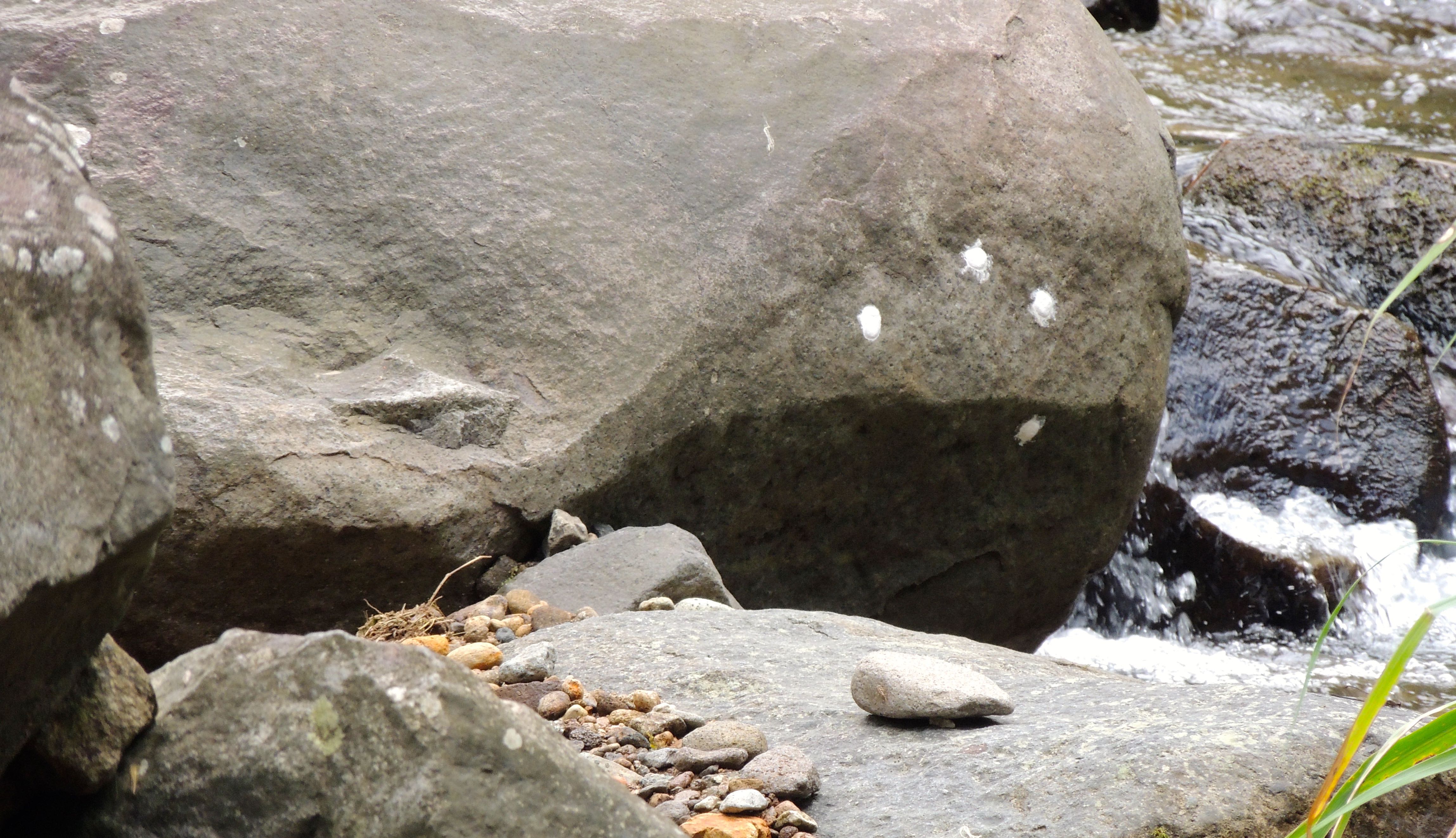 Dobsonfly Eggs - Photo by William Young
Dobsonfly Eggs - Photo by William YoungWhen we arrived back to Rancho Bajo, we saw that the Monarch had emerged from its chrysalis. After lunch, Ashley and I went to the road leading to Rancho Naturalista, but instead of going up the hill, we walked down to the main road. A few days earlier, Ashley had seen a flowering plant on the main road that she wanted to photograph. I had ridden on this stretch of road a lot of times, but I had never walked it. Because it was the afternoon, a lot of Turkey and Black Vultures were in the air. When Ashley was photographing something about fifty yards from me, I noticed a King Vulture flying low and gradually rising into the thermals. I saw the unmistakable white wings and underparts and the thick black trailing edge to the wings. Ashley was able to get on it briefly and take photos that were good enough for ID purposes, but the bird was too far up into the air for her to get a good view. She later discovered from her photos that there were two King Vultures.
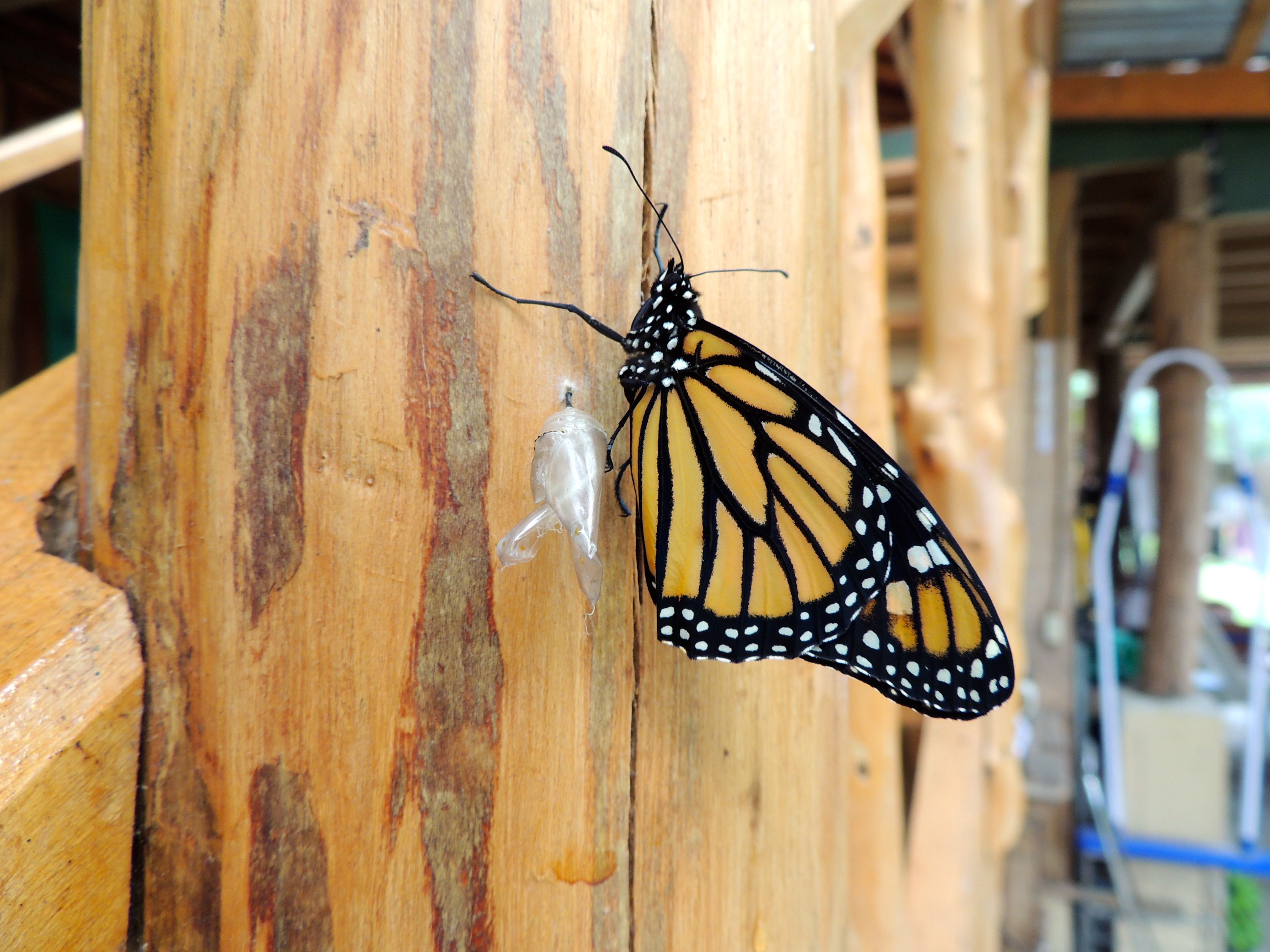 Monarch After Emerging from Chrysalis - Photo by William Young
Monarch After Emerging from Chrysalis - Photo by William YoungWe found a pair of Gartered Trogons. We heard a male calling, and he was sitting on a wire over the road. The female perched in a nearby tree. They moved around a bit, but they mostly perched in the open. The female has a gray back rather than one that is violet and green like the male. A lot of parrots and parakeets flew over, screeching as they went. I spotted a Squirrel Cuckoo, which was a new bird for Ashley. They are elongated birds who seem to have a lot of personality. One area had a nice feeding flock which included a Baltimore Oriole, Tennessee and Chestnut-sided Warblers, and a number of tanager species.
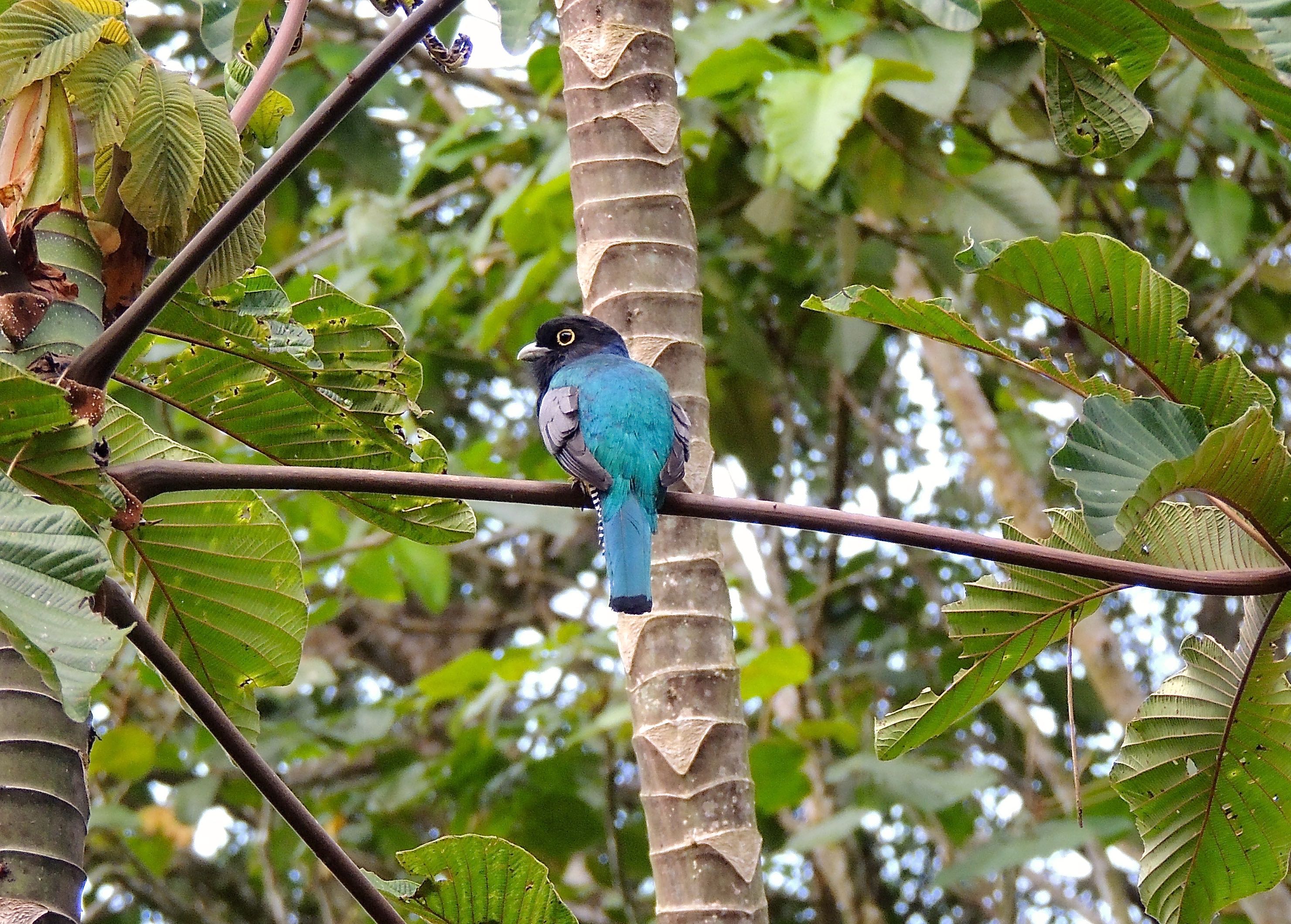 Gartered Trogon Male - Photo by William Young
Gartered Trogon Male - Photo by William YoungMarch 17
We met Meche before 6 and birded before breakfast around Rancho Bajo. A Stripe-throated Hermit was in the verbena near the house. This species used to be called the Little Hermit, and it is considerably smaller than the Green and Long-billed Hermits. It is brown, which is unusual for a hummingbird. We finally saw a Bright-rumped Attila, a species commonly heard but not easy to see. It is larger than a lot of flycatchers and has a yellow rump, a brownish back and breast, and a grayish belly. We revisited the area with the Tawny-chested Flycatcher nest and had a better look at them, even though the light was still not great. A couple of Bay Wrens hopped in the bushes and occasionally gave us a look; I saw the black head, the black-and-white face, and the white throat. They are loud and vocal. We saw a couple of Yellow-throated Euphonias, who look like a Lesser Goldfinch with a yellow spot over the bill.
After breakfast, we hiked around Rancho Naturalista with a couple named Deb and Billy from Arizona. While we waited for everyone to get organized, I stood with some people near the area around the room where I stayed last year at Rancho Naturalista and saw Collared Aracaris foraging in the trees. When we started to walk, we reached an area where Rufous-tailed Jacamars were calling, and we saw one in the trees. They look like large hummingbirds, and their call is a series of loud whistles that descend into a trill. We heard a pair of Ruddy Pigeons, but I did not get a great look at them. Meche found a couple of Long-billed Gnatwrens, but I never got on them. Chestnut-sided Warblers were common, and we saw one female Blackburnian Warbler. A White-shouldered Tanager was new for the trip. The male is all black with a white wing patch.
Ashley and I had been keeping a hectic schedule. Most mornings, we were in the field by 5:30 and birded until breakfast. We would bird between breakfast and lunch and between lunch and dinner. And after dinner, we either wrote field notes and processed photos, or we went back outside to look for things at night. The hiking typically involved a lot of hills, which is tiring. Because we never wanted to rest, we decided to spend the afternoon watching birds from the veranda at Rancho Naturalista.
If you stay still, you can observe a lot of the hummingbirds from a couple of feet away. I was that close to White-necked Jacobins, Green-breasted Mangos, and Crowned Woodnymphs. Male and female mangos both have a thick dark jagged line going down their breast, but because the female is white underneath and the male is green, the line stands out much more on her breast. The male mango has a rufous tail and can be confused with a Rufous-tailed Hummingbird. The mango's bill is longer and decurved, and it is not red. The female has rufous in her tail, but not as much as the male. The male woodnymph is distinctive, but the female is plainer. Her throat is whitish, and when the light hits her a certain way, some of her feathering looks bluish. Both the male and female have black wings. Female Jacobins are green on back and speckled on the throat and breast. I was entranced by a female Snowcap who came to the feeders. She was tiny and plain, but if you looked at her closely, you could see the same flat-headed shape as the male. The various hummingbirds seem to have preferred feeders to visit. A Violet Sabrewing visited a feeder to the left of the downstairs dining tables. It is a large purple hummer with white tips on its tail feathers.
There is a small pond in front of the dining area where birds come to drink and bathe. It is often patrolled by Clay-colored Thrushes, who sometimes chase away other species. Among the visitors to the pond was a male Mourning Warbler, the only one we saw on the trip. I don't get to see many in Virginia, and it was good to be able to get such a long look. A Wilson's Warbler came in to bathe, as did a Black-and-white and a few Chestnut sided. Summer Tanagers came to the fruit feeders. The feeders were also visited by Stanley the Central American Long-nosed Coati, an Azara's Agouti, and Red-tailed Squirrels. The mammals do not peck at the bananas and other fruit, but try to take a whole banana to an area where they can nibble on it.
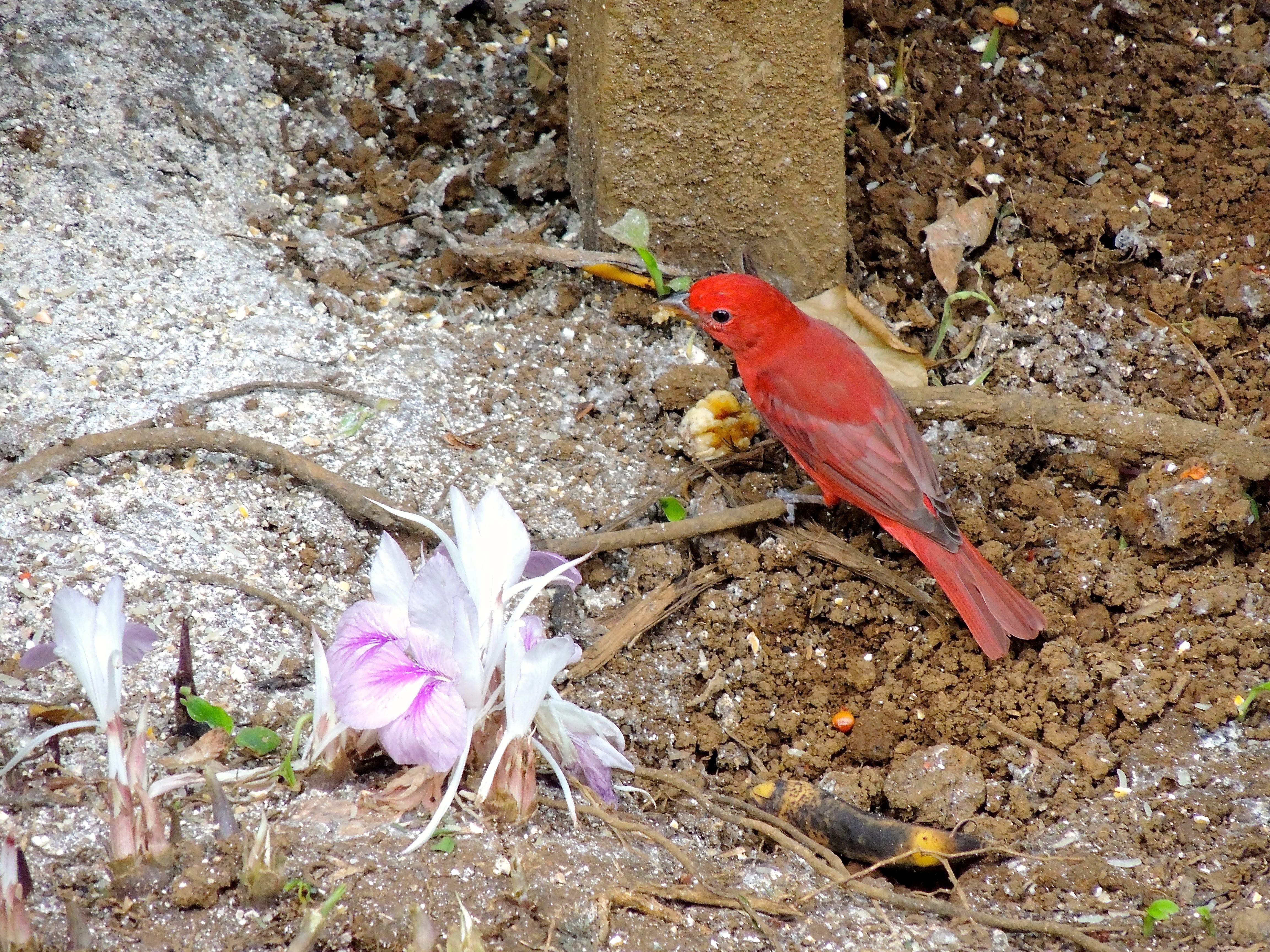 Summer Tanager - Photo by William Young
Summer Tanager - Photo by William Young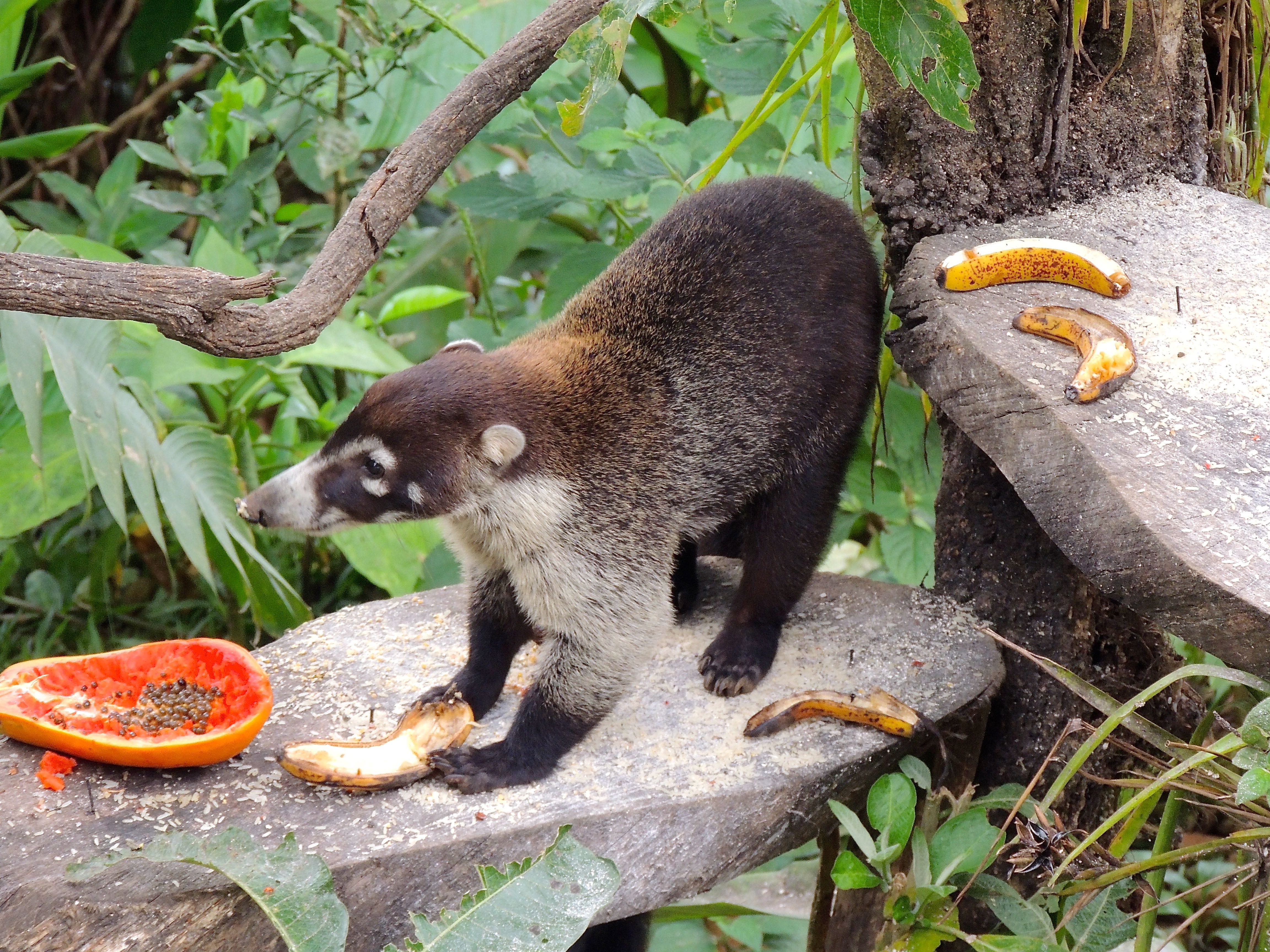 Central American Long-nosed Coati - Photo by William Young
Central American Long-nosed Coati - Photo by William YoungMarch 18
We had another long and full day, with some unexpected twists. We went with Meche to Wayne Easley's house. Wayne showed us a lot of insects he had found and let us photograph them. We saw quite a few birds. A Slaty-capped Flycatcher perched near the house. It is olive on the back and yellowish below, with a gray cap and a black mark behind the eye. We saw quite a few warblers, including Blackburnian, Tropical Parula, Chestnut-sided, Rufous-capped, American Redstart, Black-and-white, and Tennessee. A Rufous Motmot was in the trees next to the house, and I had good looks at a Cocoa Woodcreeper. Wayne has hummingbird feeders which attract more Rufous-tailed Hummingbirds than the ones at Rancho Naturalista. A Bronze-tailed Plumeleteer appeared briefly, but I did not see it.
We ate breakfast at Rancho Naturalista and prepared to explore some of the higher elevation trails on the grounds near the lodge. Before we left, a Chiriqui Quail-Dove landed on the ground near the dining area. This species is endemic to Costa Rica and western Panama and can be very difficult to find; Meche did a big year last year and saw more than 700 species of birds in Costa Rica, but the Chiriqui Quail-Dove was not one of them. This bird showed up at the lodge early this year, and it comes to the feeding area fairly regularly. It stayed around for at least 20 minutes, and I took a lot of photos and some video.
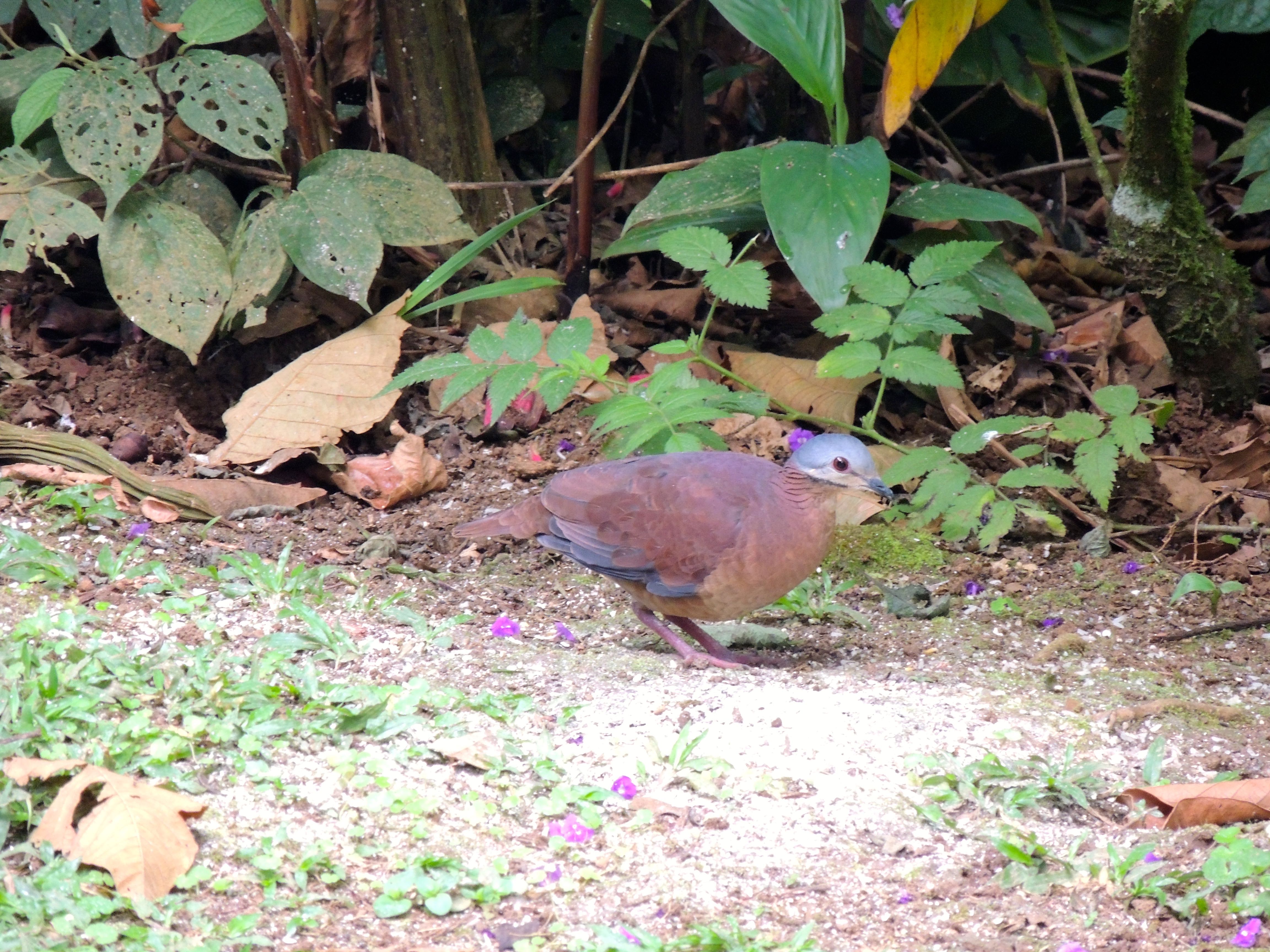 Chiriqui Quail-Dove - Photo by William Young
Chiriqui Quail-Dove - Photo by William YoungWe walked along the Quail Dove Trail, Pepper Trail, and Manakin Trail. We found both White-ruffed and White-crowned Manakins. The White-ruffed is an all black bird with a white throat, while the White-crowned is all black with a white head. Both are tiny birds. Their bodies are about the size of a warbler (a chunky one), but they have a short tail. All manakins seem nervous, and they move at warp speed. We heard a Barred Forest Falcon vocalizing. A couple of times, we had fleeting glimpses of it as it flew over, but we never had a good look. Locating birds in trees from a narrow forest trail can be difficult. We saw a Short-tailed Hawk fly over. We heard a Broad-billed Motmot, and while we were looking for it, we saw a Rufous Motmot.
We had nice looks at some ovenbirds. The Wedge-billed Woodcreeper is smaller and easier to identify than most of the other woodcreepers. We saw a Plain Xenops, who looks similar to the Wedge-billed Woodcreeper but is more likely to hang on branches than to climb on trunks. The Plain Brown Woodcreeper has few distinguishing fieldmarks and is identified by comparing it to woodcreepers with more clearly defined markings. The Streak-headed Woodcreeper looks like a Cocoa, but it is a little smaller. We saw a pair of Smoky Brown Woodpeckers, who are not related to the Woodcreepers but forage in a similar manner. We saw a foraging pair of Zeledon's Antbirds, who used to be called Immaculate Antbirds. The male is dark with blue skin around the eye. Birds who live in hot climates often have bare facial skin as a way of dissipating heat. A Scale-crested Pygmy-Tyrant was foraging among the leaves, but I did not get on it. We had nice looks at Golden-crowned Warblers; I could see the black lines on the head and the gold on top. While we were looking in vain for a Crested Owl, we saw a Speckled Tanager. Lesser Greenlets were in the trees.
There are two ways to get back to Rancho Bajo from the Rancho Naturalista trails. One is to return to the lodge and walk down the main road as we usually do. The other is to take back trails through the woods. I had never taken the back trails, and we decided to use that route. When we were within a couple hundred yards of Rancho Bajo, our path was blocked by a female cow with horns. When we tried to tiptoe past her, she raised her head in a threatening manner. We waited awhile and eventually decided to be a bit less cowardly and try to slowly sneak past the cow. I was right behind Meche. We managed to get past without incident and went to Rancho Bajo for lunch.
We did not feel like doing much in the afternoon, so we explored near Rancho Bajo. The following day involved a long car trip, so it was probably not a bad idea to stay around and rest.
March 19
During the night, we continued to hear the potoo calling. We also heard a Mottled Owl, who makes short, distinctive WHOO sounds. We got up before 5 to go to the cloud forest in Tapanti National Park, which is about a two-hour drive, and Meche wanted to make a few stops along the way. Our first stop was at some agricultural fields at Oriente. We had close looks at both Red-breasted and Eastern Meadowlarks sitting on fenceposts. A Bronzed Cowbird perched on a wire. Among the numerous Variable Seedeaters were some Blue-black Grassquits, but none were doing their "Johnny Jump-up" behavior. Ruddy Ground-Doves were on the ground. A group of Groove-billed Anis flew about, and some landed relatively close to us. A White-tailed Kite flew over the fields, sometimes stopping to hover. We saw a couple Southern Lapwings at the far end of a field, and they displayed their colorful wing pattern in flight. Among some Northern Rough-winged Swallows was one Mangrove Swallow, who has a white rump. One tree had a Yellow Warbler and two Tropical Mockingbirds, who look like a washed out Northern Mockingbird. A Great Egret was in the fields along with a Bare-throated Tiger-Heron. The Tiger-Heron appeared to be resting.
Our next stop was unscheduled. Ashley had not seen a White-winged Dove. I had seen a lot of them as we had been driving, but usually by the time I said something, we were past them. Meche saw some on the wires as we drove through a town, so we pulled over and Ashley had a good look. Nearby, a Green Heron was perched on the wires. A bit further on, we stopped at a dam. The best bird was a Laughing Falcon, who was flying over. We heard and saw a couple of Keel-billed Toucans in the trees. Down in the water was a Muscovy Duck who was probably domestic. We drove through an area along Rio Macho and saw an Amazon Kingfisher perched on a cable.
 Green Heron - Photo by William Young
Green Heron - Photo by William YoungOur final stop before Tapanti was a road where we got out and birded. The highlight for me was getting a long look at a Golden-winged Warbler. Just as Ashley had been missing the White-winged Doves, I somehow managed to not see any of the Golden-wings on the trip. Yellow-green Vireos were calling and flitting in the trees. A couple of White-naped Brushfinches were skulking in the underbrush, but I never saw them. We saw a Grayish Saltator in the same area.
As we drove toward the registration area at Tapanti, we stopped to look at the nest of a Green-fronted Lancebill. The female sat on the nest. A short distance past the registration area, we saw a White-bellied Mountain-Gem, who looks stocky and very white underneath. Meche saw a Bicolored Hawk, but it flew before she could alert either Ashley or me. We heard a Silvery-fronted Tapaculo, but I never saw this extreme skulker in the dense underbrush. A couple of Gray-breasted Wood-Wrens sang while moving around in a bush, giving us a look. We heard Prong-billed Barbets but did not see any. I would rather hear them than see them, because they sound like part of a laugh track on a television show. We saw a Mountain Thrush and a Clay-colored Thrush, and there were both Orange-billed and Slaty-backed Nightingale-Thrushes.
We saw some forest species. There were more Zeledon's Antbirds. The Spotted Barbtail is like a xenops with more spots. We saw a Spotted Woodcreeper, who has similar spots on its underparts. We heard a Scale-crested Pygmy-Tyrant and a Slaty Antwren, but I did not see either. Nor did we see the Golden-browed Chlorophonia who was singing. We had some luck with tanagers. We had great looks at Spangle-cheeked Tanagers at eye level. We saw Bay-headed and Silver-throated Tanagers, as well as a Common Chlorospingus. We saw a male Scarlet-thighed Dacnis, but the light was not great. Near the overlook where we saw the Spangle-cheeked Tanagers were about 100 White-collared Swifts, some of whom were flying low. Because they are big and have a collar, they are one of the easier swift species to identify. Earlier in the day, we had seen four Swallow-tailed Kites, who appeared to be migrating. One of the last new birds we saw was a Barred Becard. Ashley took photos which show the barred underparts, but the barring is difficult to see in the field.
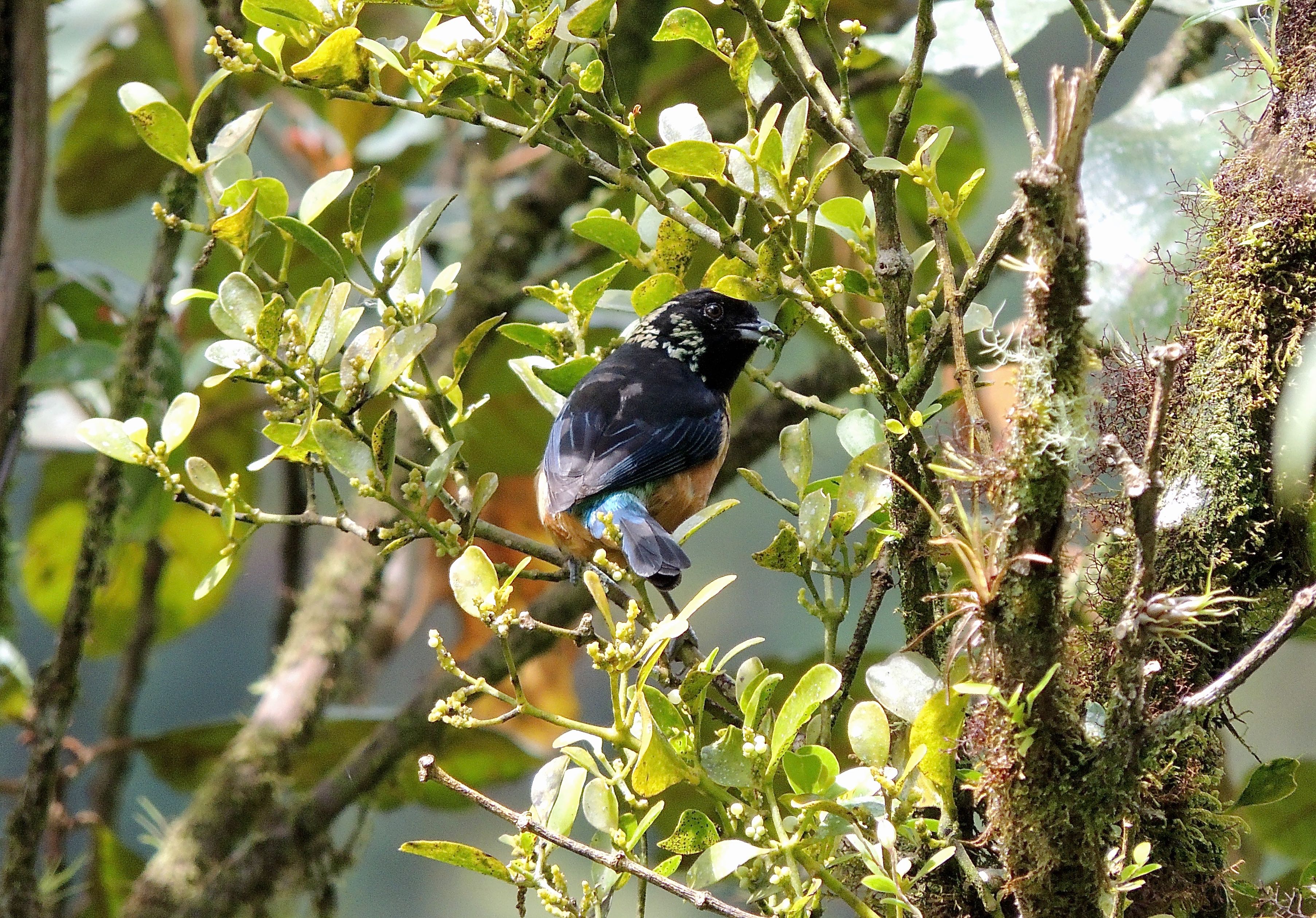 Spangle-cheeked Tanager - Photo by William Young
Spangle-cheeked Tanager - Photo by William YoungOn our way back, we stopped at a bridge again to look for Red-headed Barbets. I wanted Ashley to see this species, because she had drawn an icon with one, but the barbets did not cooperate today. We saw a Torrent Tyrannulet and a Black Phoebe foraging in the water. We made another stop later at a dam and saw a male Ringed Kingfisher on a wire. The male has a rufous breast, while the female's breast is blue. A Baltimore Oriole foraged in a nearby tree, and a Gray Hawk soared in the distance.
March 20
Meche met us at 5:30, and we birded at Rancho Bajo until breakfast. Near the verbena, we saw a Green Thorntail get into a confrontation with a Black-crested Coquette. Both species have a white band across the rump. Along with the Snowcap, who also made trips to the verbena, these are two of the most sought after hummingbird species at Rancho Bajo, and both are tiny — about the size of a Snowcap. The male thorntail has a long tail that appears to come to a point when folded. Meche was excited to see a male Scarlet Tanager. Summer Tanagers are relatively common, but the Scarlet is not. Perhaps I am getting jaded, but the colors on the male Scarlet, which cause so much excitement when the birds come to Virginia, do not seem as bright or saturated as the similar colors on a Passerini's or Crimson-collared.
A tree well behind the verbena bushes had a Hoffman's Woodpecker, and we heard a Smoky Brown Woodpecker. The tree had a couple of Blackburnian Warblers, as well as a Black-and-white, Chestnut-sided, and an American Redstart. We saw a female Yellow-throated Euphonia, who is a small olive bird, and both Black-headed and Buff-throated Saltators. A lot of flycatchers were around, including a Yellow-bellied Elaenia, Great Kiskadee, and a Boat-billed Flycatcher. A Social Flycatcher was gathering nesting material, as was a Clay-colored Thrush.
After breakfast, we went to a section of the Rio Tuis which has a path along the river. The jinx bird for Meche is the Lanceolated Monklet. A framed photo of one is upstairs at Rancho Naturalista, and people have seen them in the area where we were going, but we had no luck today. A highlight was seeing two Collared Trogons. We had much better looks than we had along the Rio Savegre in the highlands. We also saw a Lesson's Motmot. This species was the "gateway bird" that caused Meche to become interested in birds, and she has a large tattoo of one on her right shoulder. It used to be part of the same species as the Blue-crowned Motmot.
A couple of Sunbitterns were in the river. We saw a lot of warblers. A Louisiana Waterthrush foraged in the stream. We looked for both Buff-rumped Warblers and American Dippers, but we did not see any. I had another long look at a Golden-winged Warbler. We found a Blackburnian, Golden-crowned, and Tropical Parula. We saw all three of the common species of euphonias — Olive-backed, Tawny-capped, and Yellow-throated. Keel-billed Toucans were in some of the trees, as were both species of oropendola. Red-throated Ant-Tanagers foraged in the vegetation. We saw a Squirrel Cuckoo, Cinnamon Becard, Plain Xenops, and a couple of skulking Buff-throated Foliage-Gleaners. Among the flycatchers were a couple of Slaty-capped, a Piratic, a Yellow-olive, and a Paltry Tyrannulet.
We went back to Rancho Bajo for lunch and then headed back to Wayne Easley's house. He and his family were away. We spent time on a side path where we had multiple looks at displaying White-collared Manakins at a lek. A few times, I saw them raise their wings to make the distinctive "joy buzzer" noise. The path led down to an area with an enclosure for pigs. Some of the manakin vocalizations were high-pitched, but others sounded like pig grunts. Standing and watching the manakins was one of my favorite parts of the trip. A few Keel-billed Toucans were in the trees, and one offered a piece of fruit to another. Some White-crowned Parrots landed in a tree, and we finally had a chance to observe them perched. A female American Redstart flitted around, and we saw Rufous-capped Warblers.
We stopped briefly at Rancho Naturalista, and while we were there, a black mammal called a Tayra came to the feeders. It is in the weasel family, and I had never seen one. On our walk back to Rancho Bajo, I saw two others on the road.
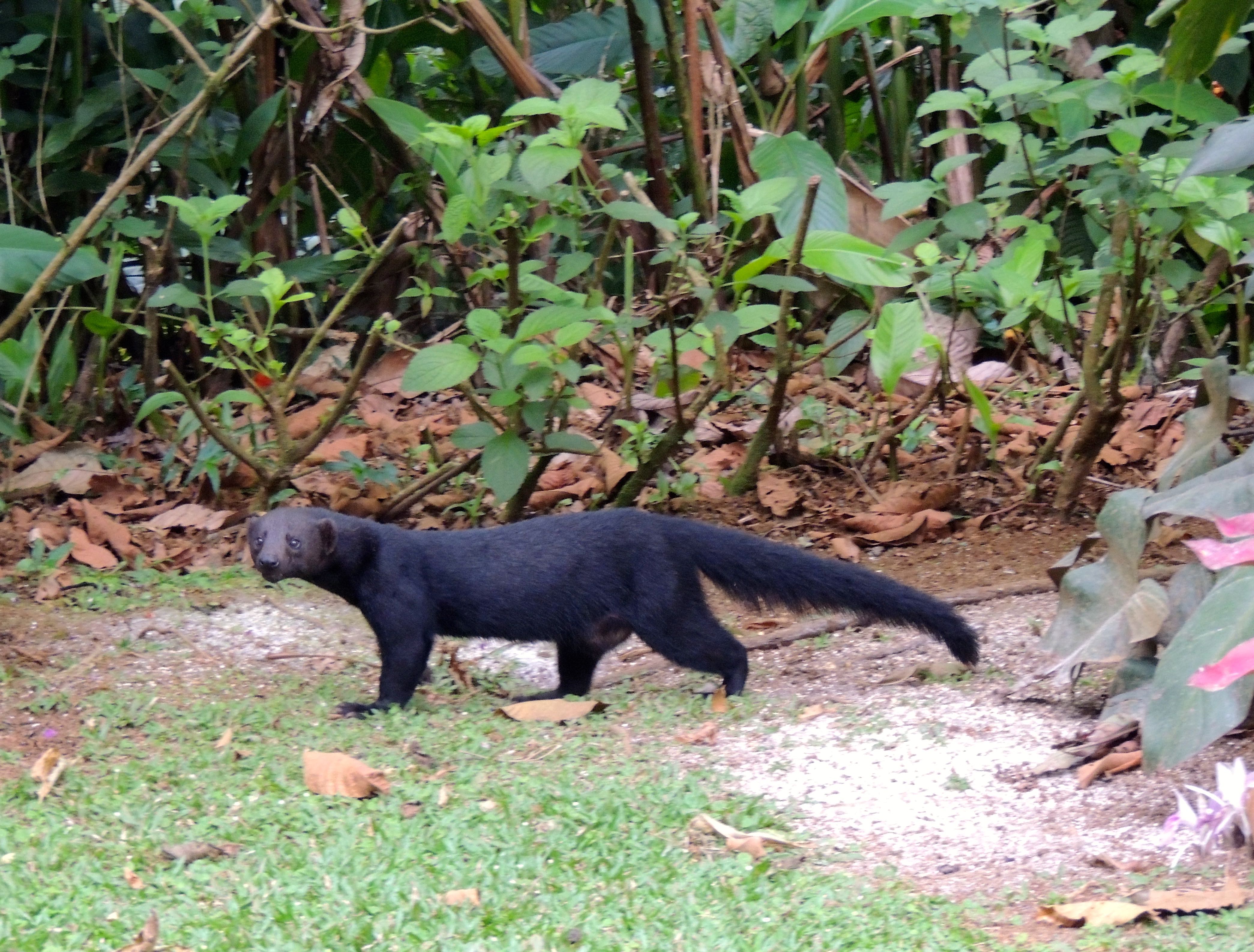 Tayra - Photo by William Young
Tayra - Photo by William YoungMarch 21
Today was my favorite day of the trip. Meche, Ashley and I left early with Daniel our driver to go to La Unión and visit "Casa de Cope", which is the home of an artist named Jose Alberto Perez, aka Cope. (It is pronounced like the medical insurance term "co-pay".) He lives two hours from Rancho Bajo in an area where the Caribbean lowlands meet the foothills. We stopped at a bridge in La Suiza where about a dozen Blue-winged Teals were swimming. A Snowy Egret, Little Blue Heron, Green Heron, and two Rufous-naped Wood-Rails were also there. A Black-cheeked Woodpecker was in a tree over the water. A bit later in the drive, we saw a couple of Gray-breasted Martins.
When we had almost reached Casa de Cope, we pulled over in the town of La Union because Meche saw a Brown-throated Three-toed Sloth in one of the trees, which was a considerable distance away. We had nice looks at the sloth, and in the same tree were Olive-throated Parakeets who appeared to be copulating.
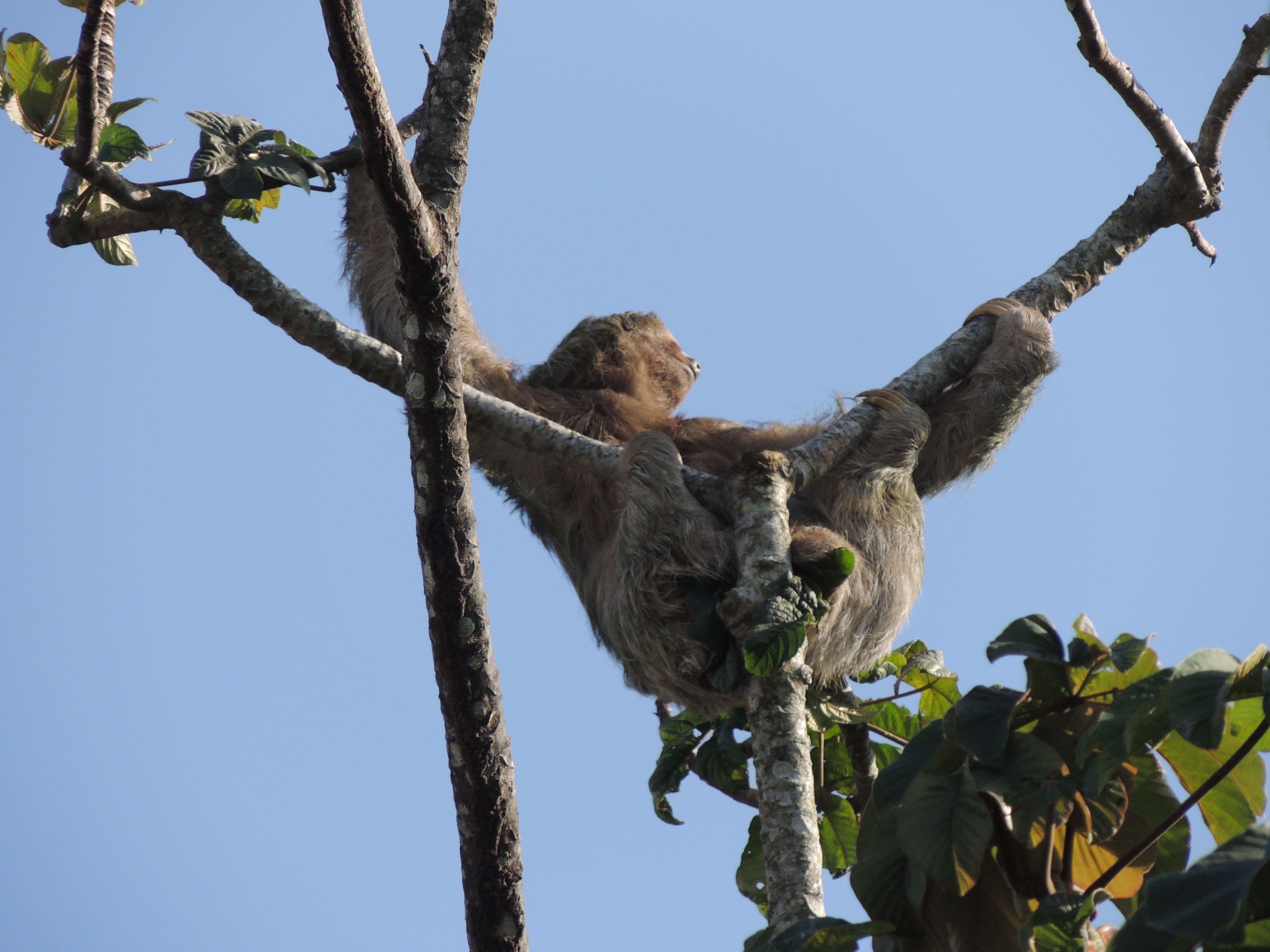 Brown-throated Three-toed Sloth - Photo by William Young
Brown-throated Three-toed Sloth - Photo by William YoungWe arrived at our destination and were greeted by Cope. His house is next to a wetland, and he has built a small area where people can sit and view wildlife. We had seen Pale-vented Pigeons on the ride there, and we had a chance to take long looks at them perched by the water. A Russet-naped Wood-Rail strutted around in front of us, and a Green Kingfisher perched in one of the trees next to the water. We could hear a Great Kiskadee, Piratic Flycatcher, and Melodious Blackbird vocalizing in the background. Cope has hummingbird feeders, and we saw a lot of hummers, including Long-billed Hermit, White-necked Jacobin, Rufous-tailed Hummingbird, Bronze-tailed Plumeleteer, and Violet-headed Hummingbird. The Violet-headed has a small white spot behind the eye. The plumeleteer has red feet. A Great-tailed Grackle perched a short distance away at eye level, and I could not believe how large it looked. This was one of the most common species we saw on the trip, yet the one at Cope's house seemed much bigger than any I had seen.
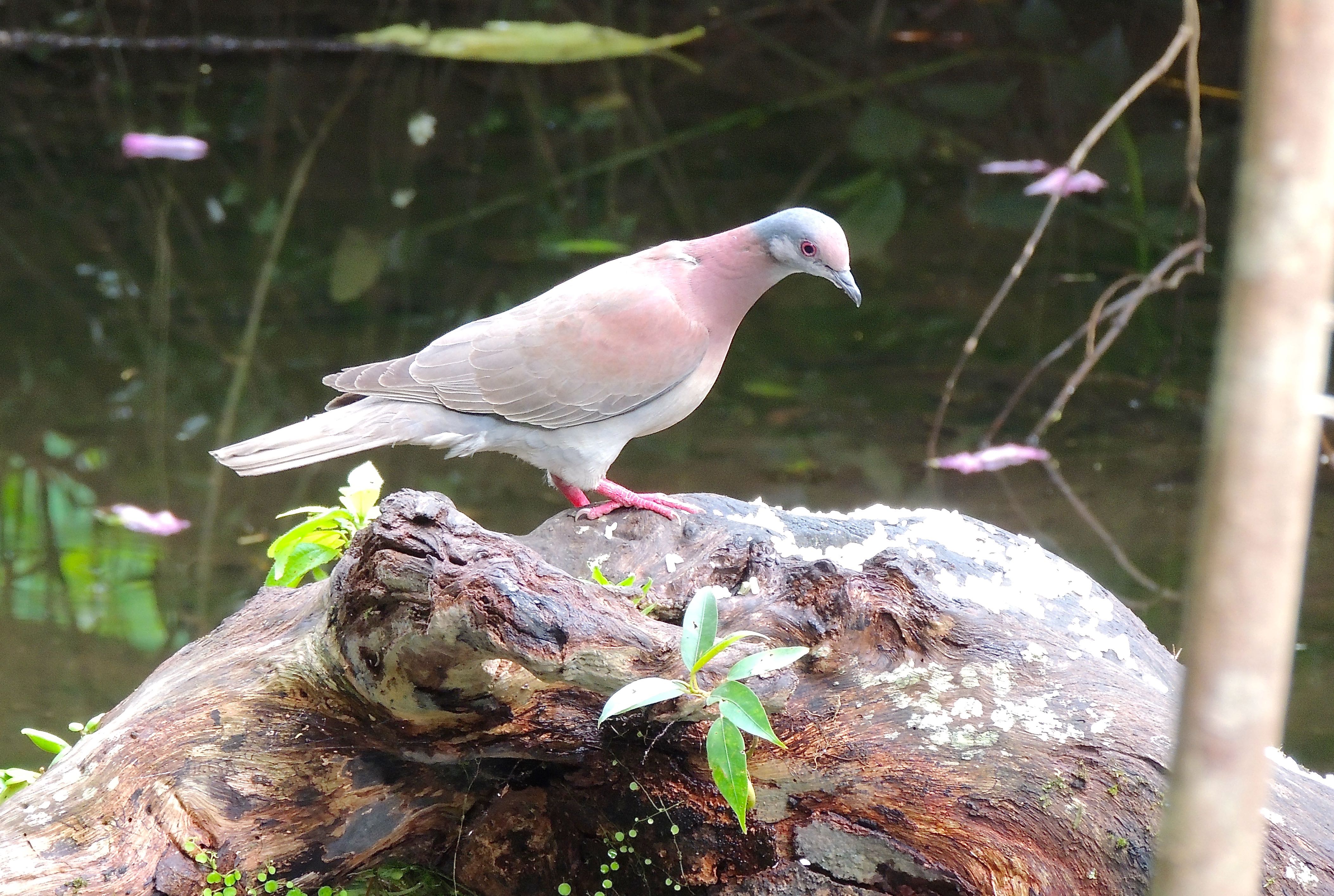 Pale-vented Pigeon - Photo by William Young
Pale-vented Pigeon - Photo by William Young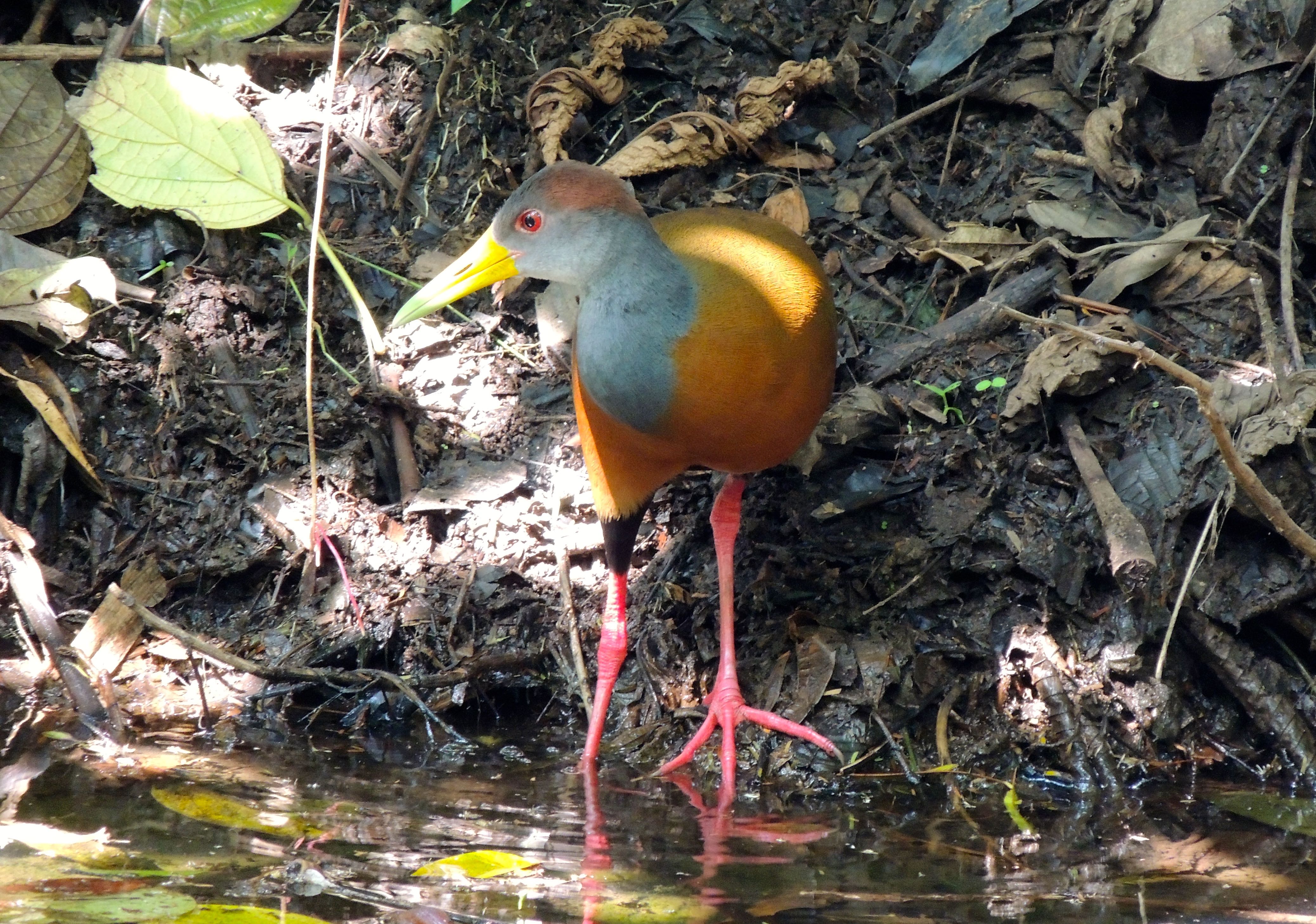 Russet-naped Wood-Rail - Photo by William Young
Russet-naped Wood-Rail - Photo by William Young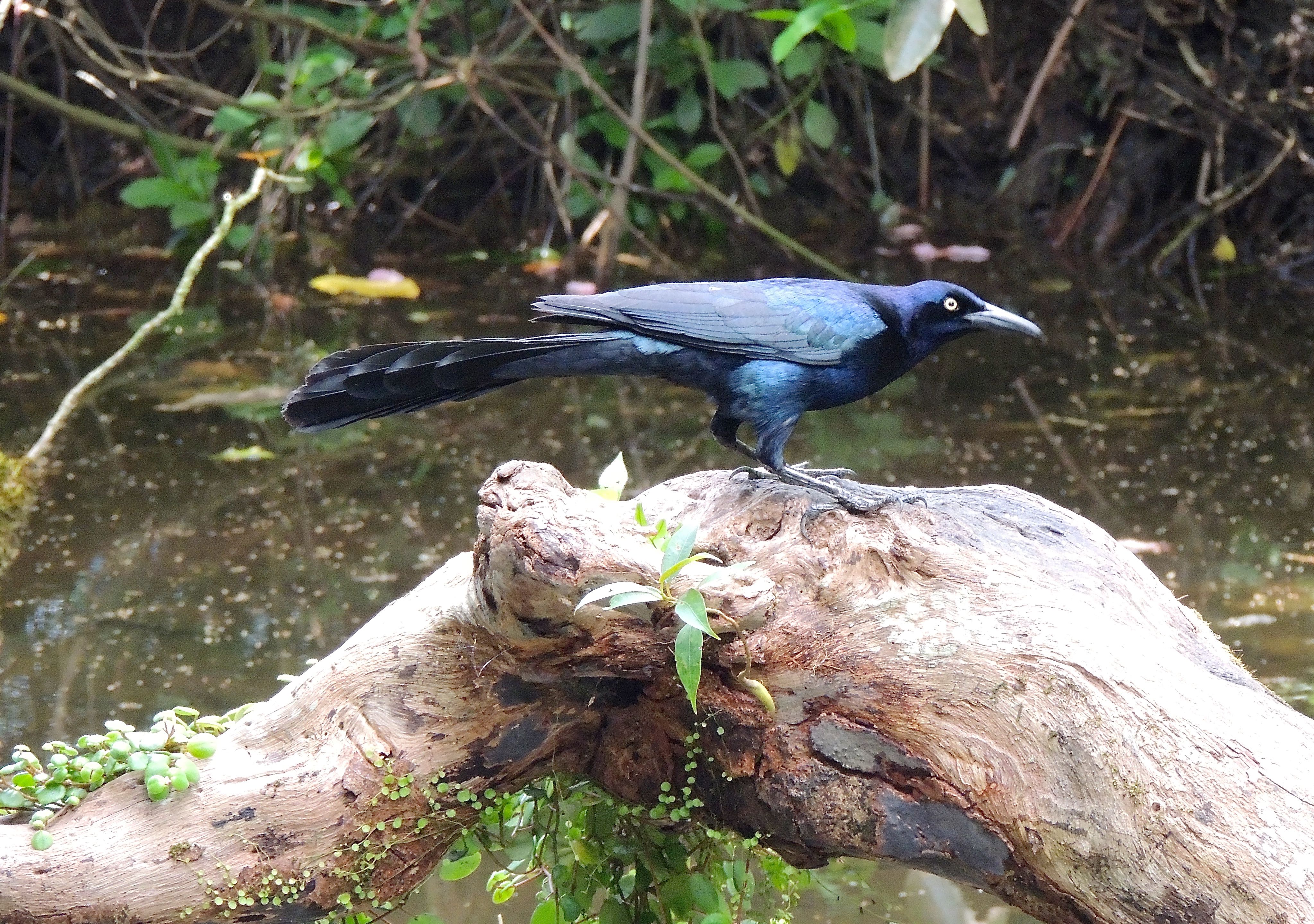 Great-tailed Grackle - Photo by William Young
Great-tailed Grackle - Photo by William YoungWe got back into the car to bird along the road and on a trail up the road from where Cope lives. Cope took us to see a pair of roosting Spectacled Owls, the largest owl species in Costa Rica. While we watched, one of them scratched its head with its foot. We also saw a pair of roosting Crested Owls. We did not see the Crested Owl who roosted on one of the Rancho Naturalista paths, but these two were in the open. One stood on one leg and tucked the other into its belly like a clenched fist. We photographed some Honduran White Bats, who were under a palm leaf. They look like little furry ping-pong balls with yellow ears and a yellow snout. We could hear Great Tinamous and the loud calls of Mantled Howler Monkeys. Cope showed us a Pauraque nest on the shoulder of the main road. It was very well camouflaged, and it was difficult to see, even though it was less than ten yards away. A Bright-rumped Attila called loudly in the background.
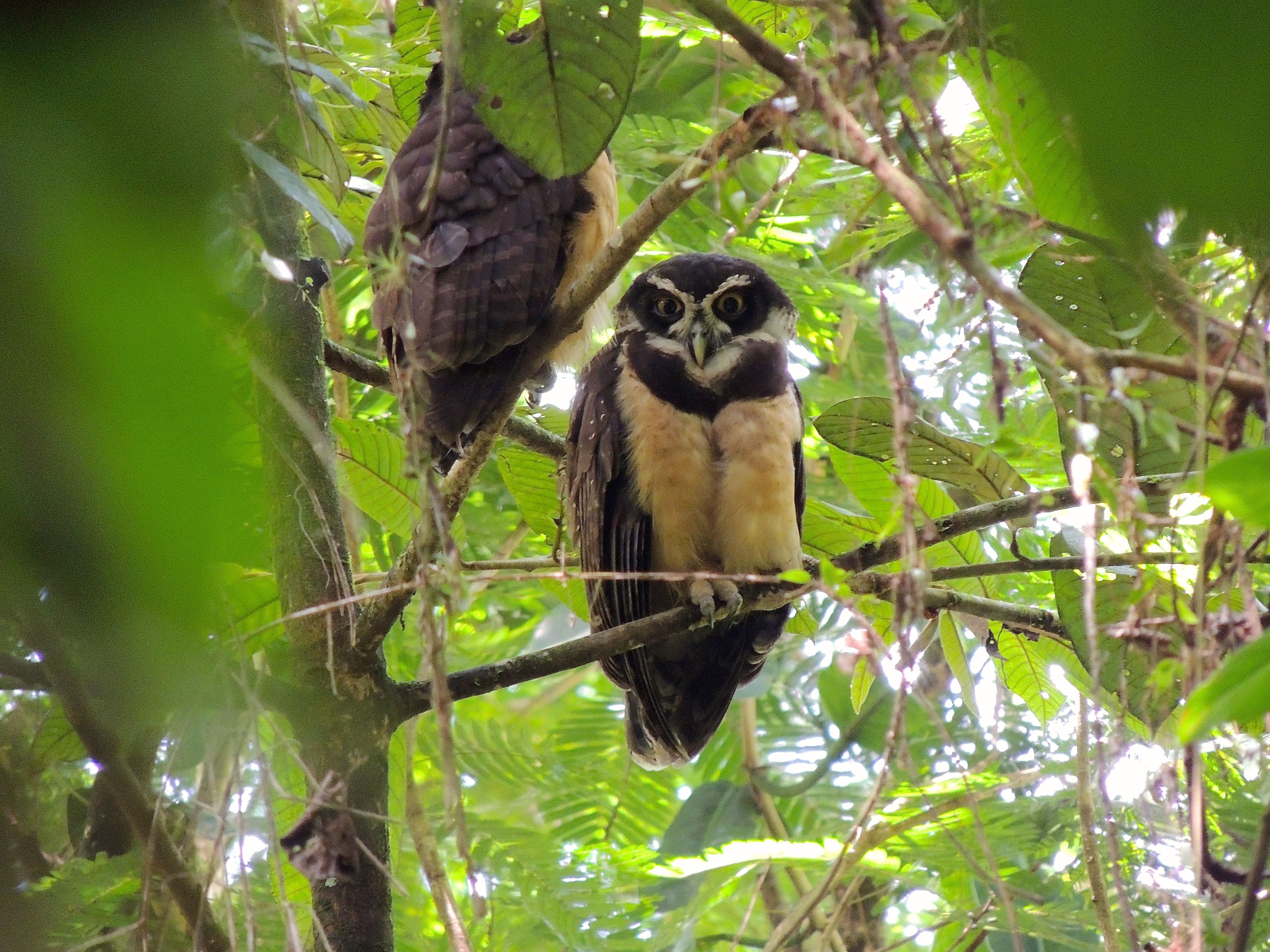 Spectacled Owls - Photo by William Young
Spectacled Owls - Photo by William Young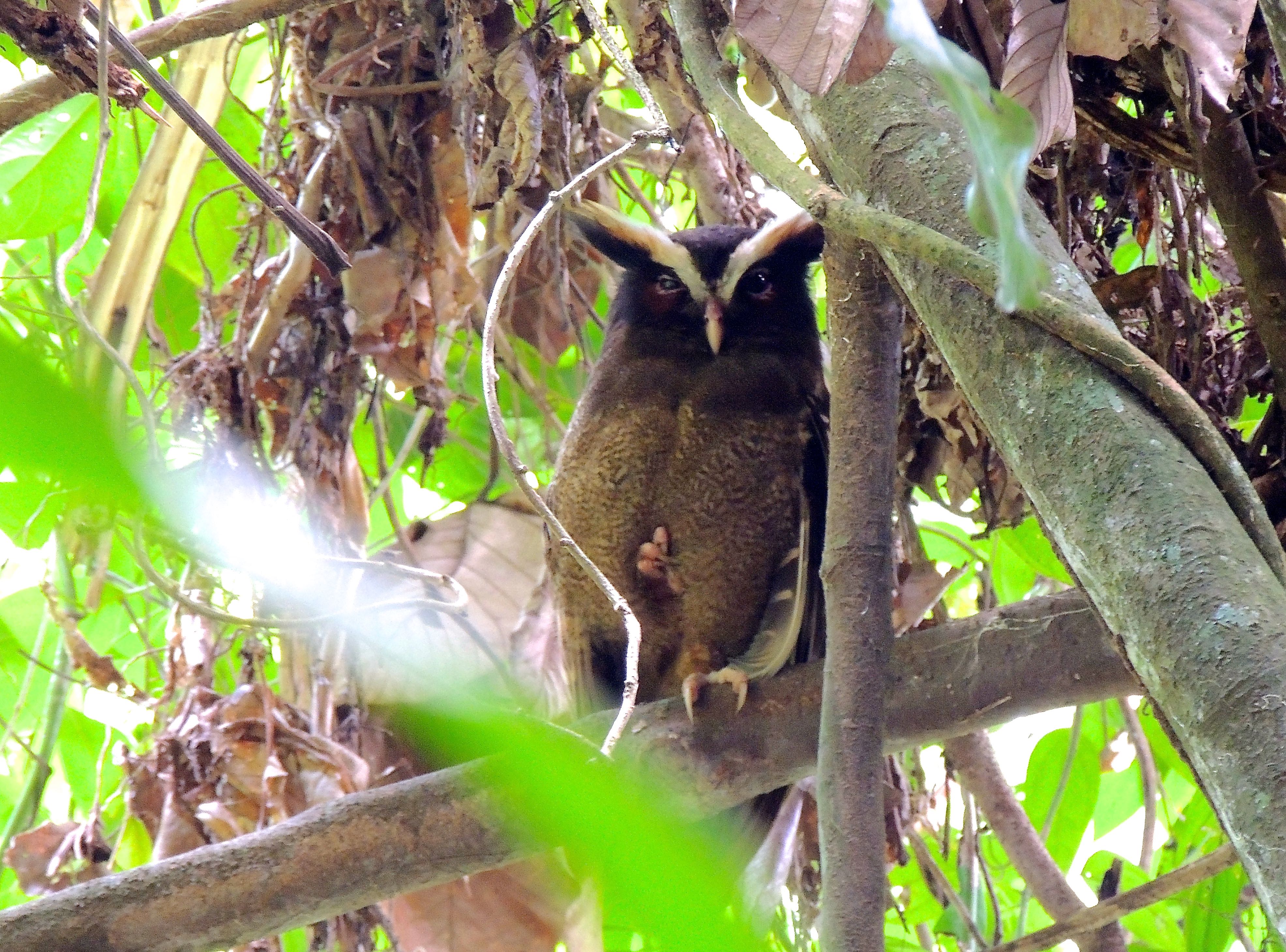 Crested Owl - Photo by William Young
Crested Owl - Photo by William Young Honduran White Bats - Photo by William Young
Honduran White Bats - Photo by William Young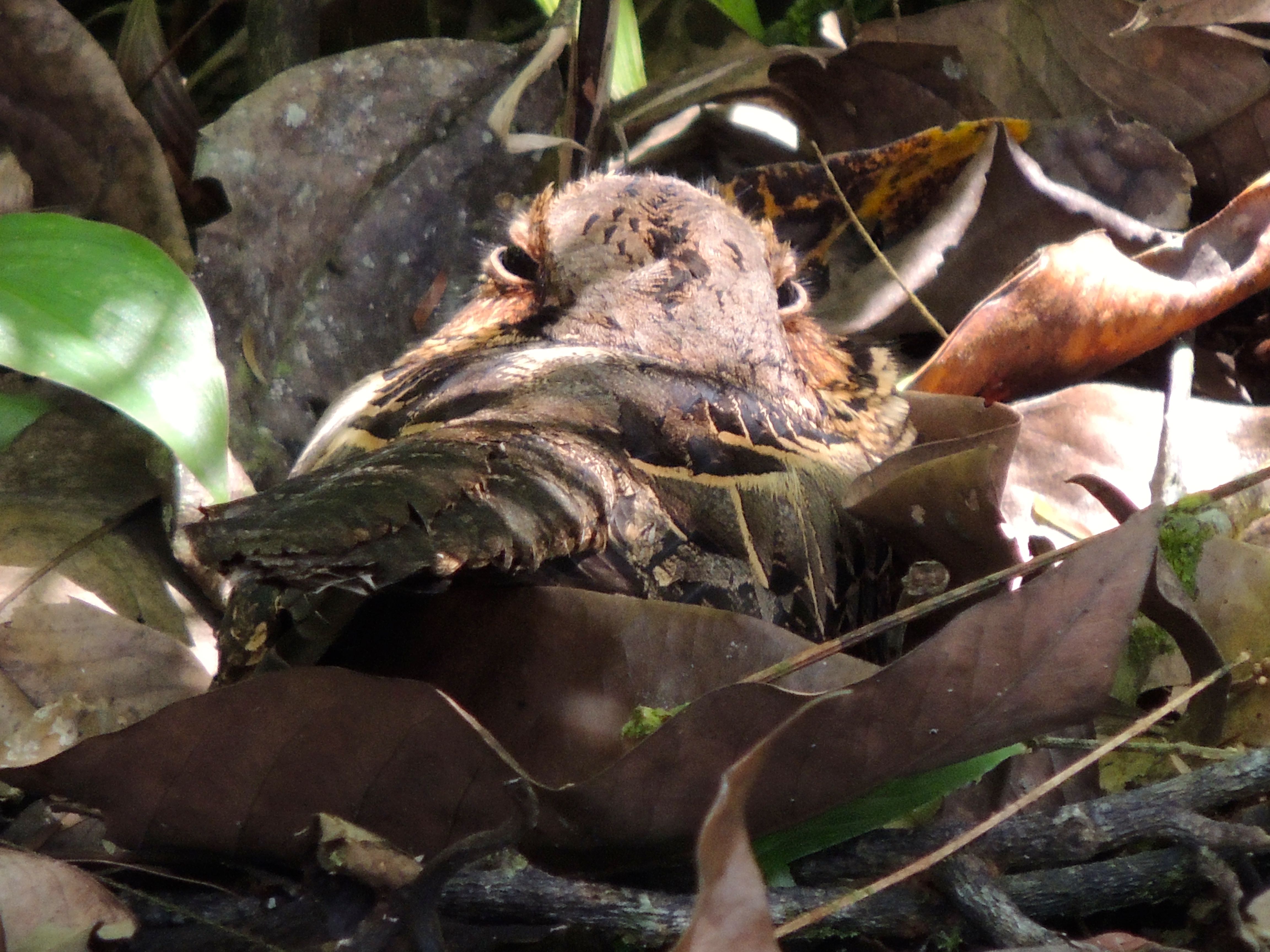 Common Pauraque - Photo by William Young
Common Pauraque - Photo by William YoungWe hit the trogon trifecta. Cope showed us a male Black-throated Trogon, who has a yellow belly, a green back, and a black mask and throat. The male Slaty-tailed Trogon has a green head and breast, a red belly, and a solid slaty tail. The red bill makes him appear to be wearing lipstick. It is one of the largest trogon species in Costa Rica; we also saw a female. In the same area was a Gartered Trogon. We came across a pair of Broad-billed Motmots, who look like a smaller version of the Rufous Motmot with a broader bill. In an open area, we saw a pair of Pied Puffbirds in a tree. They are black-and-white birds about the size of a sparrow and look puffed up. Nearby were some Long-tailed Tyrants, who are small flycatchers with two central tail feathers that appear to be almost as long as their body. They hawked insects, often returning to the same perch. The same area had nesting Chestnut-headed Oropendolas, and we had some of our closest views of this species.
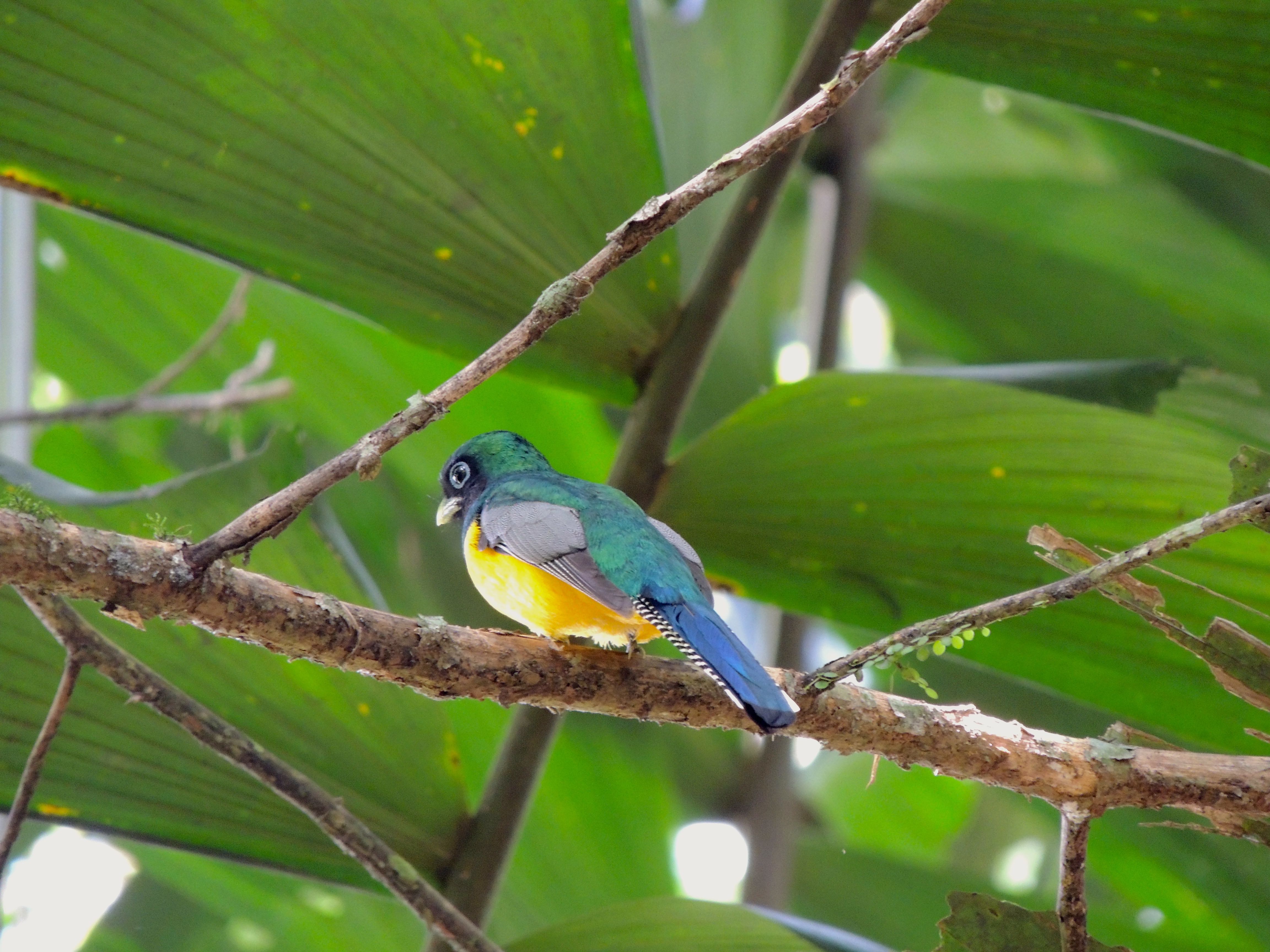 Black-throated Trogon - Photo by William Young
Black-throated Trogon - Photo by William Young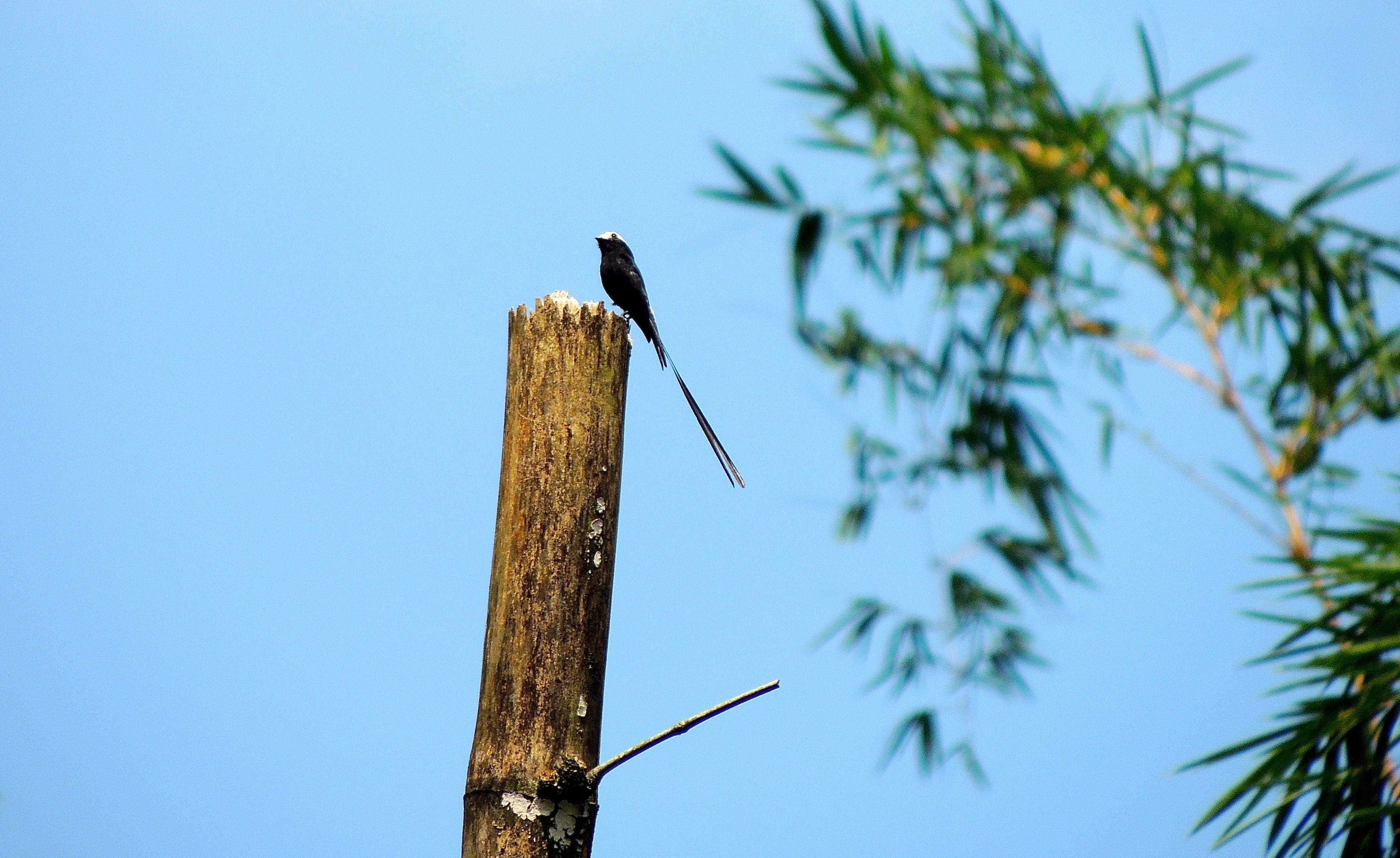 Long-tailed Tyrant - Photo by William Young
Long-tailed Tyrant - Photo by William YoungWe finally had a decent look at a Black-cheeked Woodpecker, who is usually a common species. We also saw a Lineated. A lot of toucans were around, and in the background, we heard the call of the Yellow-throated Toucan as we did when we arrived at Los Cusingos. We saw and heard Keel-billed Toucans in the forest. The Wedge-billed Woodcreeper is small compared to other woodcreepers. We saw a Black-crowned Antshrike, a species I saw a lot in Panama when it was called the Western Slaty Antshrike. A couple of Chestnut-backed Antbirds were working the trees. During the trip, we were not in areas that have a lot of antbirds. We saw a Wood Thrush, which made me feel at home. And we had good looks at a couple of Slate-colored Grosbeaks, who are gray birds with a white throat and a large bright red bill. In the same area, we saw the Blue Jeans color morph of the tiny Strawberry Poison-Dart Frogs.
We drove back to Rancho Bajo. When we were almost there, we stopped along the Rio Tuis because Meche saw a Fasciated Tiger-Heron standing among the rocks. After dinner, we went to Rancho Naturalista for a night walk. We mostly looked for insects and spiders, and we saw quite a few whip-scorpions. During the walk, we heard a Great Tinamou, a Common Potoo, and a Mottled Owl, but we did not see any of them.
At about 1:30 in the morning, the entire house began to shake severely from an earthquake measuring 4.7. Earthquakes in the area are fairly common. When I visited Rancho Naturalista in 1997, I was standing on the veranda one morning at 6:20 when a 2-point earthquake occurred. As in California, people who live here get used to it.
March 22
Meche joined us at about 6. After you have been in Costa Rica awhile, you become familiar with the appearance and vocalizations of the birds, and it can be pleasant to simply appreciate them without running around trying to find something new. We had nice looks at a Yellow-throated Vireo from the veranda. We have them in Virginia, but I usually do not see many.
After breakfast, we got into a van with a small tour group led by Harry Barnard, another Rancho Naturalista guide. He has great knowledge of birds throughout the world. We headed to Casa Turire, and on the way, stopped to look at Groove-billed Anis and Blue-black Grassquits. Casa Turire is a wetland area, and we stopped on one end to scan the water. As we were getting out of the van, Harry spotted two Barred Antshrikes in a tree. The prominent white eye on these birds reminds me of one of the Muppets from Sesame Street.
The scan of the water was productive. Harry spotted a Wattled Jacana, a very uncommon bird in this area. It is mostly black, with yellow on the wings. Northern Jacanas and a Purple Gallinule were also there, along with a couple of Limpkins. A large raft of Lesser Scaups was in the water. There was a good variety of long-legged waders. A Tricolored Heron flew by, showing its white belly. A couple of Great Egrets were mixed in with a larger number of Snowy Egrets. We saw Great and Little Blue Herons and some Green Herons. A Snail Kite flew across the water. Harry scoped a Neotropic Cormorant, who was very far away. He also scoped a couple of Least Bitterns, which I did not see.
We drove to a different part of the complex, and Meche, Ashley, and I split from Harry's group. Meche was coming down with a virus, but she managed to show us a lot of birds. As we walked toward a different viewing area to see the impoundments, we encountered a large group of Black Vultures on the ground. It was about 9:30 a.m., and the thermals might not have been strong enough to allow soaring.
We saw a lot of the same birds we had seen with Harry, but we had closer views of many of them and saw new ones as well. Meche found a couple of Olive-crowned Yellowthroats skulking in the reeds. They are yellower below than a Common Yellowthroat and do not have a gray border on top of the mask. Ashley and I got a quick look at a Least Bittern who flew about 20 yards in front of us before dropping into the vegetation. We had not seen a lot of waterfowl by this point on the trip, but today, we saw Lesser Scaups and Blue-winged Teals, and a flock of about 20 Black-bellied Whistling-Ducks perched by the shoreline. We had relatively close looks at Least Grebes swimming close to the shore. Snail Kites sailed leisurely over the water, and they sometimes made passes in areas where we had relatively close looks. An Osprey was flying in the area, and it landed in a tree over the water, not far from where an Anhinga was on the ground. While walking along a path, we saw a Roadside Hawk perched on a bare branch. It did not seem bothered when we walked near the tree. We saw both Ringed and Amazon Kingfishers and heard the static-like call of the White-throated Crake. We eventually needed to return to the van. While we waited, a Southern Lapwing was next to the road, looking for insects. We were able to get fairly close to it.
When we returned to Rancho Bajo, Ashley and I had lunch. We spent the afternoon at the Rancho Naturalista feeders, mostly observing the behavior of the various hummingbirds. We eventually walked back to Rancho Bajo. On the way, we saw a tree with both a Baltimore Oriole and a Summer Tanager — birds who might be coming to Virginia soon.
March 23
On our final morning in Costa Rica, we met Meche at Rancho Naturalista and went to the moth light. We saw three species of woodcreepers. The Plain-brown Woodcreeper perched in the kiosk with the light and was picking moths off the sheet. A Northern Barred and a Spotted Woodcreeper were in nearby trees. A Buff-throated Foliage-Gleaner worked the foliage closer to the ground, as did a pair of Red-throated Ant-Tanagers. Pairs of Plain Antvireos, White-breasted Wood-Wrens, and Golden-crowned Warblers were present. We saw an Orange-billed Sparrow, a Chestnut-sided Warbler, a female White-collared Manakin, and a pair of Dusky-capped Flycatchers. We heard a Bright-rumped Attila in the background, but we never saw it.
We went back to Rancho Bajo for our final breakfast and then headed back to Rancho Naturalista. We stopped at a lookout and saw both Black-crowned and Masked Tityras, who were working at nests. The bodies of the males look similar. The Masked has a white head, a black mask, a red bill, and red skin around the eye. The Black-crowned has a head that is much plainer — white, with a black crown and a black bill. The females of both species have brown on the head, but they have the same bill and eyering colors as the males. We had seen them on previous days. From the same vantage point, we saw a pair of flying Roadside Hawks and a House Wren working the foliage.
For our final walk with Meche, we went on some of the Rancho Naturalista trails and did a loop down to the road to head back to Rancho Bajo. It gave us one last chance to enjoy the sights and sounds of some of the birds with whom we had spent the past two weeks. I stopped at the office at Rancho Naturalista to say good-bye to a few people. A Bananaquit was foraging in one of the bushes by the front door, and a Slaty-capped Flycatcher was building a nest in front of the main entrance. When we were heading back to the main road, we ran into Daniel, who was with a calf who had just been born. He was trying to show it how to get milk from its mother.
We had lunch, and then devoted part of the afternoon to packing. We had to leave before dinner to get to the airport in San Jose. We said good-bye to Kathy and John and began our long trip home.
Bird Families
Tinamous — We heard Great Tinamous at Los Cusingos and Rancho Naturalista but never came close to seeing one.
Anhingas and Cormorants — An Anhinga was at CATIE and Casa Turire, and a Neotropic Cormorant was at Casa Turire.
Frigatebirds — I saw a Magnificent Frigatebird when we were driving along the Pacific coast.
Pelicans — We saw a flock of Brown Pelicans from a lookout over the Pacific the first day.
Herons and Egrets — Cattle Egrets were the most common heron. We saw them frequently in fields, and we saw a lot in breeding plumage at CATIE. Great Egrets were fairly common, and we saw them on many of the days when we left the grounds at Rancho Naturalista. Snowy Egrets were less common, but we saw some in a number of places, including the bridge at La Suiza, which was also a good spot for Little Blue Herons. A Great Blue Heron was at CATIE and Casa Turire, and a Tricolored Heron was at Casa Turire. Both Black-crowned and Boat-billed Herons were nesting at CATIE. Green Herons were at Casa Turire, and we saw one on a wire on the way to Tapanti. A Fasciated Tiger Heron was in the river about a mile from Rancho Naturalista, and a Bare-necked Tiger Heron was in the agricultural fields at Oriente, about a half an hour from Rancho Naturalista.
Ducks — Most of the ducks we saw were at Casa Turire. We saw Black-bellied Whistling-Ducks, Blue-winged Teals, and Lesser Scaups. We also saw teals at the bridge in La Suiza. A Muscovy Duck was next to the dam the day we went to Tapanti.
Grebes — A group of Little Grebes was at La Turire.
Vultures — Black and Turkey Vultures were among the most common birds on the trip, with the Blacks being more common. We saw them every day in greater numbers than the Turkeys, whom we saw all but one day. I saw one King Vulture from the entry road to Rancho Naturalista who started low and gradually went high into a kettle of Black Vultures. When Ashley later looked at her photos, she discovered two King Vultures in the kettle.
Hawks and Kites — Roadside Hawks were the most common raptor. We saw them on about half the days, but never in any numbers. A couple seemed to be on territory on the road to Rancho Naturalista. We saw migrating Broad-winged Hawks on about half the days, but only individuals; a young Broad-winged hung around the area where we viewed the quetzals. We saw a Short-tailed Hawk from the upper trails at Rancho Naturalista and a Gray Hawk over the dam on the way back from Tapanti. Meche saw a Bicolored Hawk at Tapanti. We saw a few Ospreys — along the Rio Savegre, along the Rio Tuis, and at Casa Turire. We found migrating Swallow-tailed Kites on three days — at the Trogon Lodge, Tapanti, and along the Rio Tuis. A White-tailed Kite was at Oriente, and Snail Kites were at Casa Turire.
Falcons — We did not have much luck with falcons. We saw a Laughing Falcon fly over a dam the day we went to Tapanti. We had fleeting looks at a Barred Forest-Falcon on the trails at Rancho Naturalista. I saw a Yellow-headed Caracara at CATIE.
Chachalacas — Once we arrived at Rancho Bajo, Gray-headed Chachalacas were extremely common. We saw a lot every day. Up the hill from the Trogon Lodge, we saw a pair of Black Guans. Along the Rio Savegre, we came across a pair of Spotted Wood-Quails. They are usually heard more than seen.
Rails — On the day we went to Cope's, we twice saw Rufous-naped Wood-Rails. Two were at a bridge in La Suiza, and Cope had one by the water near his house. Purple Gallinules were at both CATIE and Casa Turire. We heard a White-throated Crake at Casa Turire.
Sunbittern — We had nice looks at Sunbitterns. We saw some at a bridge in La Suiza. We also saw them at the base of Cerro Silencio and along the Rio Tuis.
Limpkin — The only Limpkins we saw were at Casa Turire.
Jacanas — Northern Jacanas were all over the place at CATIE. We saw far fewer at Casa Turire, where we also saw a Wattled Jacana, a far less common species.
Plovers — The only plovers we saw were Southern Lapwings at Oriente and Casa Turire.
Sandpipers — I did not see any shorebirds, but Meche saw a Spotted Sandpiper the day we went to Tapanti.
Pigeons and Doves — The most common doves were the White-tipped, who regularly came to feeders. I saw a lot of White-winged Doves on wires on days we drove through non-agricultural areas. We did not see many Rock Pigeons outside of heavily populated areas. We saw Ruddy Ground Doves in both populated and agricultural areas, including at the hotel in San Isidro. We saw a perched flock of Band-tailed Pigeons at Tapanti and a lot of Pale-vented Pigeons in La Union and at Cope's house. Red-billed Pigeons were at CATIE, the base of Cerro Silencio, and a few other places, but never in any numbers. We heard Short-billed and Ruddy Pigeons, and I saw one Ruddy Pigeon. A lot of these pigeons have loud calls and stay in the treetops, so they are more often heard than seen. The rarest pigeon was the Chiriquí Quail-Dove, who came to the feeders at Rancho Naturalista and strutted around in the open for about 20 minutes. It is extremely uncommon at that location.
Parrots — We did not have many good looks at perched parrots. We usually saw them flying, and when they landed in trees, they blended in and were difficult to see. The most common species was the Crimson-fronted Parakeet. A lot of them screeched as they quickly flew over. Ashley saw her first one in a tree as we were being driven from Heredia to Rancho Bajo. We also saw some perched at CATIE. White-crowned Parrots were the next most common species. We saw some perched one day at Wayne's house and in a couple of other places. Some Sulphur-winged Parakeets flew over when we were along the Rio Savegre, and I could see the yellow on the wings. The only Olive-throated Parakeets I saw were the ones mating in the same tree where the sloth was in La Union. I never had a decent look at an Orange-chinned Parakeet or Brown-hooded Parrot.
Cuckoos — We saw a Squirrel Cuckoo next to the road to Rancho Naturalista, not far down the hill from the Rancho Bajo turnoff. We saw another one along the Rio Tuis, and we heard them on other days. We saw Groove-billed Anis in a few places. Our best looks were at a group in the fields at Oriente.
Owls — In the woods near Cope's house, we saw a pair of Spectacled Owls and a pair of Crested Owls. Some people had seen a Crested Owl in the woods at Rancho Naturalista, but we could not find it. We heard a Costa Rican Pygmy Owl when we were up the hill from the Trogon Lodge. And on numerous evenings at Rancho Bajo, we heard a Mottled Owl calling during the night.
Potoos — We heard the mournful laugh of the Common Potoo on many nights but never saw one.
Nightjars — At Cope's we saw a Common Pauraque on a nest on the ground.
Swifts — We saw a lot of White-collared Swifts at Tapanti, some of whom were flying low. At CATIE, a few Spot-fronted Swifts flew over.
Hummingbirds — We saw about two dozen species of hummingbirds. The most common species once we arrived at Rancho Bajo was the White-necked Jacobin. We did not see any before that. Green-breasted Mangos and Crowned Woodnymphs were common at the feeders. Rufous-tailed Hummingbirds were common in the flowers at Rancho Bajo and at the feeders at Wayne Easley's House, but there were not as many at the feeders at Rancho Naturalista. We saw a bathing Purple-crowned Fairy when we went to the hummingbird pools at Rancho Naturalista, but no others on the trip. A Violet Sabrewing sometimes came to the Rancho Naturalista feeders, along with a young Green-crowned Brilliant, who has buffy feathering around its chin. Some Green Hermits came to the feeders at Rancho Naturalista. A Long-billed Hermit was at Cope's feeders. A Stripe-throated (Little) Hermit sometimes was in the verbena at Rancho Bajo.
The Trogon Lodge in the highlands had a different group of hummingbirds. The most common was the Lesser Violetear; Talamanca Hummingbirds were also common. Volcano Hummingbirds were fairly common at the Trogon Lodge, but we did not see any Fiery-throated until we visited Quetzal's Paradise, where they were the most common hummingbird after the Talamanca. Along the Rio Savegre was a tiny Scintillant Hummingbird in the flowers next to the road. We saw Stripe-tailed Hummingbirds in the same area. A female White-throated Mountain-Gem frequented some of the flowers at the Trogon Lodge, and I saw one Garden Emerald. While we were in the highlands at Tapanti, we saw a White-bellied Mountain-Gem. Near the entrance to Tapanti, a female Green-fronted Lancebill was on a nest.
The Snowcap, who is the symbol for Rancho Naturalista, was easy to find in the verbena at Rancho Bajo and less easy to find at Rancho Naturalista. The males visited the hummingbird pools and flowers near Rancho Naturalista but did not visit the feeders, but the females sometimes came to the feeders on the veranda. I did not see any male Snowcaps at the Rancho Bajo feeders either. Occasionally, a female Black-crested Coquette would visit the verbena at Rancho Bajo, but I did not see a male. Male and female Green Thorntails also visited the verbena. We saw a Violet-headed Hummingbird at Cope's House, along with a Bronze-tailed Plumeleteer. A plumeleteer was also at Wayne Easley's House, but I never had a good look at it.
Trogons — At the Trogon Lodge, we saw quite a few Resplendent Quetzals. Most were up the hill from the lodge, but we saw a female on the lodge property and heard a male calling while we were there. The only other trogon we saw in the highlands was a female Collared along the Rio Savegre. The most common trogon species when we were at Rancho Bajo was the Gartered. We saw or heard them on five days and had nice looks at a pair from the road just below Rancho Bajo. In the forest near Cope's house, we saw Slaty-tailed and Black-throated Trogons, and we heard a Gartered in the same area. We saw a pair of Collared Trogons along the Rio Tuis.
Kingfishers — We did not see many kingfishers. The only Green Kingfisher we saw was at Cope's house. We saw Ringed and Amazon at Casa Turire as well as on the road to Tapanti.
Motmots — We heard Rufous Motmots a lot. We saw a couple at Wayne Easley's House and another on the upper trails at Rancho Naturalista. We saw a Lesson's Motmot along the Rio Tuis. We saw a pair of Broad-billed Motmots in the forest near Cope's house and heard one on the upper trails at Rancho Naturalista.
Puffbirds — We saw a pair of Pied Puffbirds in an open area next to the forest near Cope's house.
Jacamars — We heard a few Rufous Jacamars. The only one I saw was on the Rancho Naturalista trails.
Toucans — Toucans are very vocal birds who are heard more often than they are seen. The Keel-billed makes a cricket-like chirp, which we heard during much of the trip. The Yellow-throated has a louder vocalization. We heard it while we were at Cope's, and it greeted us in the parking area at Los Cusingos. The Los Cusingos parking area is also where we saw Fiery-billed Aracaris. Once we arrived at Rancho Naturalista, we saw Collared Aracaris on five days, including in the trees not far from the office. A couple were on the ground at CATIE. A pair of Emerald Toucanets were menacing an Acorn Woodpecker nest up the hill from the Trogon Lodge.
Woodpeckers — We saw or heard nine species of woodpeckers, but we did not get a lot of looks at them. Near the Trogon Lodge, we came across some Acorn Woodpeckers in a couple of places, and we also saw them at Quetzal's Paradise. We saw the dark-bellied race of the Hairy Woodpecker up the hill from the Trogon Lodge. Near Wayne Easley's house, we saw Golden-olive Woodpeckers on a couple of days. The only Pale-billed Woodpecker we saw was when we were walking from Rancho Bajo to Rancho Naturalista. We saw a Lineated Woodpecker at Cope's and another around Rancho Naturalista. A pair of Hoffman's Woodpeckers was at the Pacific overlook on our first day in Costa Rica, and we saw a couple others at Casa Turire and Rancho Naturalista. The Black-cheeked Woodpecker is usually common, but the only one I had a good look at was at Cope's. I saw a Smoky Brown Woodpecker at Rancho Naturalista and heard them on other days. I also heard a Cinnamon Woodpecker but never saw one.
Barbets — We heard the laughing calls of Prong-billed Barbets but never saw them.
Ovenbirds — The moth light at Rancho Naturalista had a pair of Buff-throated Foliage-Gleaners foraging near the ground. A Spotted Barbtail was at Tapanti. We saw Streaked Xenops along the Rio Savegre and a Plain Xenops around Rancho Naturalista. Also along the Rio Savegre was a pair of Ruddy Treerunners interacting on a trunk — they might have been a parent and offspring.
Woodcreepers — We saw about 10 species of woodcreepers, many of whom look very similar. You need to look for slight differences in bill shape, bill size, and the patterning on the back, head, and nape to tell them apart. The Streak-headed Woodcreeper was the most common on our trip. We saw or heard them on 8 of the 10 days we were around Rancho Bajo and Naturalista. The Cocoa Woodcreeper was the second most common, and it looks a lot like the Streak-headed; it is a little bigger and has a larger bill. A Spotted Woodcreeper was at Tapanti. At the Rancho Naturalista moth light, we had a nice look at a Northern Barred Woodcreeper and could see the faint barring on the back. At the same place was a Plain Brown Woodcreeper, who does not have any prominent fieldmarks; we also saw them in a few other places around Rancho Naturalista. At Los Cusingos, we saw a couple of Tawny-winged Woodcreepers and a slightly greater number of Ruddy Woodcreepers. We also saw Ruddy Woodcreepers and a Spot-crowned Woodcreeper along the Rio Savegre. The Wedge-billed Woodcreeper is smaller than all the others; we saw them at Cope's and on the Rancho Naturalista trails.
Antbirds — We did not see many antbirds. A pair of Bicolored Antbirds were at an ant swarm next to the parking lot at Los Cusingos. In the forest was a Slaty Antwren. At Cope's, we encountered both Chestnut-backed Antbirds and Black-crowned Antshrikes (who used to be the Western Slaty Antshrike). A pair of Barred Antshrikes was at Casa Turire. A Plain Antvireo was around the moth light at Rancho Naturalista. Zeledon's (formerly Immaculate) Antbirds were at both Tapanti and on the trails at Rancho Naturalista. Meche saw a couple Dull-mantled Antbirds at Rancho Naturalista, but I did not.
Tapaculos — Meche heard a Silvery-fronted Tapaculo near the entrance to Tapanti, but I never saw anything except some leaves moving in the dark understory.
Manakins — We heard and saw a Red-capped Manakin in the forest at Los Cusingos. On the higher elevation trails at Rancho Naturalista, we saw both White-capped and White-ruffed Manakins. The most common species was the White-collared Manakin. There were a couple of leks near Wayne's house, and one day, we had long views of the birds; we saw them making the joy-buzzer noise with their wings.
Flycatchers —Costa Rica is loaded with flycatchers. We encountered about 30 species. The most common were Great Kiskadee, Social Flycatcher, Tropical Kingbird, and Yellow-bellied Elaenias, who were seen or heard most days in all habitats. Mountain Elaenias were seen only in the highlands. We heard Piratic Flycatchers on about half of the days, and we saw a few, including one at Los Cusingos. Gray-capped Flycatchers nest around the two Ranchos, and I suspect some of the flycatchers we called Social might have been Gray-capped. It is much easier to mistake the two than to mistake a Boat-billed for a Kiskadee. We saw or heard Boat-billed Flycatchers on six days when we were at the two Ranchos. In the same area, we heard Bright-rumped Attilas on most days, but I had a good look at only one — in the long driveway leading to Rancho Bajo. Dusky-capped Flycatchers were around the two Ranchos, and we also saw a Great Crested at CATIE. The Yellow-bellied was the predominant Empidonax flycatcher, although Meche saw a different Empidonax flycatcher who did not vocalize. Common Tody-Flycatchers were fairly common. We saw one at the Zima Hotel in San Isidro, and they frequented the verbena at Rancho Bajo. I heard a Black-headed Tody-Flycatcher, but I did not see one; Ashley saw one near Wayne Easley's house.
We saw Torrent Tyrannulets on the grounds of the Trogon Lodge as well as on a stop on our way home from Tapanti. Black-capped and Tufted Flycatchers were on the Trogon Lodge grounds. Along the Rio Savegre, we saw Yellowish Flycatchers and one Olive-striped Flycatcher. While we were at the two Ranchos, we saw or heard Paltry Tyrannulets on six days; along the Rio Savegre, we found a dead one. Yellow-olive Flycatchers were at Wayne Easley's house and Rancho Naturalista. A Slaty-capped Flycatcher was building a nest in the alcove in front of Rancho Naturalista, and we also saw one at Wayne Easley's house. Ochre-bellied Flycatchers were seen or heard at Rancho Naturalista and Tapanti. Last year, I frequently saw them bathing at the Rancho Naturalista hummingbird pool. We heard Scale-crested Pygmy-Tyrants along the Rancho Naturalista paths, but I never saw one. A pair of Tawny-chested Flycatchers were on territory near the base of the driveway to Rancho Bajo. We saw a Tropical Pewee at Rancho Naturalista — I have seen only one on each of my past two trips, but I suspect they are more common than that. Black Phoebes are generally found in waterways, and we found a couple at the base of Cerro Silencio and on the ride home from Tapanti. We saw Sulphur-bellied Flycatchers at Cerro Silencio and Tapanti. Cope showed us some flycatching Long-tailed Tyrants in a field near his house.
Becards — Cinnamon Becards were fairly common around the two Ranchos, although not always easy to see. Ashley and I saw a White-winged Becard at the turnoff to go to Wayne Easley's house. In Tapanti, we saw a couple of perched Barred Becards. The barring was difficult to see without a scope or a photo.
Tityras — Masked and Black-crowned Tityras nested close to each other in trees by the road between the two Ranchos. Our first tityras were a pair of Black-crowned in a tree at the Pacific overlook. We saw both species intermittently at the two Ranchos.
Swallows — Blue-and-white Swallows were the most common swallow species by a long way. We saw them on all but one day of our trip and often in good numbers. They nested at the Trogon Lodge and Rancho Bajo. Northern Rough-wings were more common than Southern Rough-wings. We saw Southern Rough-wings at the base of Cerro Silencio, while we saw Northern Rough-wings at CATIE, Cerro Silencio, Tapanti, and Casa Turire. I saw a Mangrove Swallow at Oriente, and Gray-breasted Martins were at a sugarcane processing center outside of La Suiza.
Wrens — Most of the wrens were skulkers and not easy to see. Of the seven species we encountered, I saw only four of them. Bay Wrens were on territory at the bridge on the driveway to Rancho Bajo. We heard Black-throated Wrens there, but I never saw one. We heard a Stripe-breasted Wren at the base of Cerro Silencio and a Scaly-breasted Wren at Rancho Naturalista, but I did not see either. House Wrens were one of the most common wrens we encountered and usually the easiest to see. We heard White-breasted Wood-Wrens frequently at the two Ranchos, and we had good looks at them at the Rancho Naturalista moth light. In the highlands, they are replaced by the Gray-breasted Wood-Wren. We heard them at the Trogon Lodge and saw them at Tapanti.
Gnatcatchers — Tropical Gnatcatchers were at the base of Cerro Silencio and along the Rio Tuis. Meche found a Long-billed Gnatwren along the Rancho Naturalista trails, but I did not get on it.
Thrushes — Clay-colored Thrushes were one of the most common species on the trip. They were everywhere we went, usually in good numbers. In the highlands at the Trogon Lodge and Tapanti, we saw Mountain Thrushes, who are similar and look paler. We also saw Sooty Thrushes there, who look like a Eurasian Blackbird. The highlands have many more species of thrushes than the area around the two Ranchos. We encountered four species of nightingale-thrushes. The Black-billed was on the road above Trogon Lodge, and the Ruddy-capped was along the Rio Savegre. At Tapanti, we encountered both the Orange-billed and the Slaty-backed. In the highlands, we frequently heard the plaintive song of the Black-faced Solitaire and had good looks at a pair along the Rio Savegre. A Wood Thrush came to bathe at the pond in front of the dining area at Rancho Naturalista, and we saw another with Cope.
Mimic Thrushes — We had nice looks at Tropical Mockingbirds at Oriente, but I did not see any others.
Corvids — Brown Jays were extremely common and noisy around the two Rancho. We had a chance to observe a lot of their behavior and their different plumages. The juveniles have a yellow eyering.
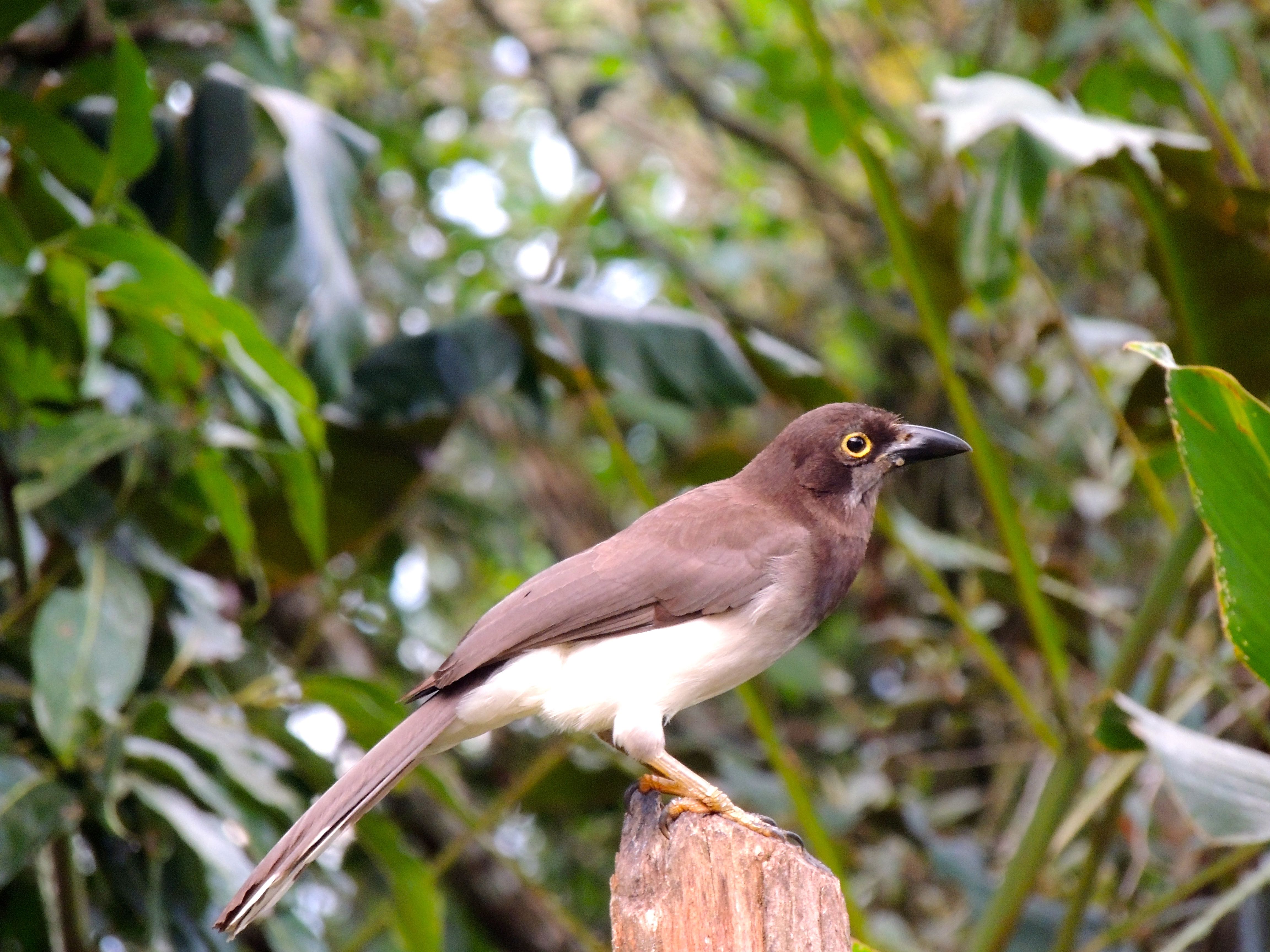 Brown Jay Juvenile - Photo by William Young
Brown Jay Juvenile - Photo by William YoungSilky-Flycatchers — Long-tailed Silky-Flycatchers seemed surprisingly common when we were in the highlands. We saw quite a few on the road outside the Trogon Lodge, and we had a nice view of one at eye level from the veranda at Quetzal's Paradise.
Vireos — We saw Philadelphia Vireos along the Rio Savegre as well as when we were at the two Ranchos. Yellow-winged Vireos were in the trees along the Rio Savegre, while Yellow-throated Vireos were at CATIE and at the base of Cerro Silencio. We saw a couple of Yellow-green Vireos when we were on the road leading to Tapanti. Meche saw Lesser Greenlets a couple of days when we were hiking the trails at Rancho Naturalista, but I did not see them. We heard Rufous-browed Peppershrikes on two days on the road above the Trogon Lodge, but we did not see any.
Warblers — We encountered close to 20 species of warblers. The most common by far was the Chestnut-sided. We saw them everywhere except when we were at the Trogon Lodge, and they were in a variety of plumages. Tennessee Warblers were common, and we saw them at all elevations. Black-and-white Warblers were seen on six days while we were at the two Ranchos. We encountered American Redstarts at the CATIE botanical gardens and at Wayne Easley's house. We had close views of Collared Redstarts along the Rio Savegre, and we saw Slate-throated Redstarts at Tapanti and at the base of Cerro Silencio. We saw Blackburnian Warblers on four days at the two Ranchos. A cooperative Mourning Warbler came to bathe in the pond in front of the Rancho Naturalista dining area, but that was the only one I saw. We encountered Golden-winged Warblers on six days, and I had good looks at them near Tapanti and along the Rio Tuis. Wilson's Warblers were at both the Trogon Lodge and Rancho Naturalista.
We saw a pair of Olive-crowned Yellowthroats at Casa Turire. We saw or heard Rufous-capped Warblers in a few places, with the most reliable being next to Wayne Easley's house. We saw Golden-crowned Warblers on the trails above Rancho Naturalista, at the moth light, and along the Rio Tuis. Flame-throated Warblers were by the road above the Trogon Lodge and along the Rio Savegre. Tropical Parulas were encountered at a few places, including Rancho Naturalista and Wayne Easley's house. We saw a Prothonotary and a Yellow Warbler at CATIE, and a couple more Yellows in a tree next to the fields at Oriente. Black-throated Green Warblers were seen both up the hill from the Trogon Lodge and along the Rio Savegre — we did not encounter any at lower elevations. We found a Louisiana Waterthrush at the Trogon Lodge and along the Rio Tuis.
Bananaquit — Bananaquits frequented the verbena outside Rancho Bajo and the bushes outside the entrance to Rancho Naturalista.
Tanagers — We saw a lot of tanagers on the trip from both families. Blue-gray, Palm, and Passerini's were all seen most days around the two Ranchos. When we were in San Isidro, the Cherrie's replaced the Passerini's, and it came to feeders. Golden-hooded Tanagers were fairly common in San Isidro and when we were at the two Ranchos. Silver-throated Tanagers were encountered on five days. We saw them along the Rio Savegre, at Rancho Naturalista, at the base of Cerro Silencio, and at Tapanti. We had nice looks at Red-throated Ant-Tanagers in a few places, including at Wayne Easley's house and near the Rancho Naturalista moth light. We saw a female Scarlet-thighed Dacnis at CATIE and a male at Tapanti. Some Black-and-yellow Tanagers were at the base of Cerro Silencio. A White-shouldered Tanager was on the paths by a pasture at Rancho Naturalista. Summer Tanagers came to the feeders at both Rancho Naturalista and the hotel in San Isidro. We saw one male Scarlet Tanager in the trees at Rancho Bajo. We had a nice look at a perched Crimson-collared Tanager as we were driving through La Suiza. We saw one Plain-colored Tanager at CATIE. Meche heard a Carmiol's Tanager on the trails at Rancho Naturalista, but we did not see it.
We saw some tanager species only in the highlands. At the Trogon Lodge, the Sooty-capped Chlorospingus and Slaty Flowerpiercer were common and tame. We saw the Common Chlorospingus at both the Trogon Lodge and in Tapanti. Golden-browed Chlorophonias sometimes came to the fruiting trees at the lodge, but we did not see any; we heard one at Tapanti, but did not see it. We saw Spangle-cheeked Tanagers along the Rio Savegre, but saw them in better light and at eye level at Tapanti. We saw Flame-colored Tanagers up the hill from the Trogon Lodge. We saw Speckled Tanagers at the feeders at Los Cusingos, and we ran into a couple more on the trails at Rancho Naturalista. Bay-headed Tanagers were at Tapanti and at the base of Cerro Silencio. We saw a Green Honeycreeper at the base of Cerro Silencio and another at Los Cusingos. A Gray-headed Tanager came to the feeders at Los Cusingos.
Euphonias — We saw three species of Euphonia. We saw Yellow-throated Euphonias on more than half the days at the two Ranchos. A pair of Olive-backed were very low right next to Wayne's house; we also saw some along the Rio Tuis. We saw Tawny-capped Euphonias on three days, including at the base of Cerro Silencio and along the Rio Tuis. We saw both Lesser Goldfinches and Yellow-bellied Siskin by the side of the road along the Rio Savegre.
Saltators — We saw Buff-throated Saltators on 7 days and Black-headed on 6. Both species were common around the two Ranchos, and we saw a Buff-throated at Los Cusingos. We saw Grayish Saltators as we were leaving the base of Cerro Silencio and as we approached Tapanti. Black-thighed Grosbeaks were along the Rio Savegre, and we saw Slate-colored Grosbeaks in the woods near Cope's house. We saw a Rose-breasted Grosbeak from the veranda at Rancho Bajo and when we were up the hill from the Trogon Lodge.
Finches — Both Variable Seedeaters and Yellow-faced Grassquits were common around Rancho Bajo. We also saw a Yellow-faced Grassquit along the Rio Savegre. We saw Blue-black Grassquits at Oriente and in a field on the way to Casa Turire. We found Thick-billed Seed-Finches at Wayne Easley's house, at the base of Cerro Silencio, and along the Rio Tuis. Large-footed and Yellow-thighed Finches were relatively common on the grounds of the Trogon Lodge. Ashley and Meche saw a skulking White-naped Brushfinch next to the road near Tapanti, but I did not see it.
Sparrows — We saw a lot of Rufous-collared Sparrows in populated areas, around the hotel at San Isidro, and in agricultural areas, but not many around the two Ranchos. The more common sparrow around Rancho Bajo was the Black-striped — we heard them most mornings as part of the dawn chorus. Orange-billed Sparrows were around the feeders at Rancho Naturalista and Wayne Easley's house and around the moth light at Rancho Naturalista. The only House Sparrows I saw were during our first day in San Jose.
Blackbirds — Great-tailed Grackles were extremely common, except around the two Ranchos. We saw them whenever we drove through populated areas and in some agricultural areas. Giant Cowbirds were surprisingly common, with Wayne Easley's house being the most reliable place to see them because they parasitize the oropendola nests. We saw Bronzed and Shiny Cowbirds at Cerro Silencio, and we saw a Bronzed at Oriente. We saw a couple of Black-cowled Orioles, including one in a tree at Rancho Bajo. Baltimore Orioles showed up in a number of places, including at the overlook by the Pacific, the road home from Tapanti, and a tree by the road between the two Ranchos. Montezuma Oropendolas were present and numerous in many place while we stayed at the two Ranchos. Chestnut-headed Oropendolas were not as common, but we saw them on 7 of the days we were at the two Ranchos. Melodious Blackbirds were at CATIE, at the base of Cerro Silencio, and at Rancho Naturalista. At Oriente, we saw both Eastern Meadowlarks and Red-breasted Blackbirds, but we did not see them anywhere else.
Mammals
We did not see or hear many mammals. We did not see any monkeys, but we heard Mantled Howler Monkeys near Cope's house. Our only Brown-throated Three-toed Sloths were in La Union and beside Cope's house. We saw Tayras one day, both at the Rancho Naturalista feeders and on the road back to Rancho Bajo. One afternoon, we saw both a Central American Long-nosed Coati and an Azar's Agouti at the Rancho Naturalista feeders. We saw three species of squirrel. Red-tailed Squirrels frequently came to the Rancho Naturalista feeders and would often take entire bananas. We sometimes saw Variegated Squirrels, and in Tapanti, we saw Central American Dwarf Squirrels. We saw some dead skunks, probably Hooded Skunks, along the road. A species of rice rat was seen sometimes around the feeders at Rancho Naturalista. Near Cope's house, we saw Honduran White Bats. On the grounds of our hotel in San Isidro was a colony of Jamaican Fruit Bats. And one of the short-tailed long-nosed bat species was hanging outside our veranda door at Rancho Bajo.
 Brown-throated Three-toed Sloth - Photo by William Young
Brown-throated Three-toed Sloth - Photo by William Young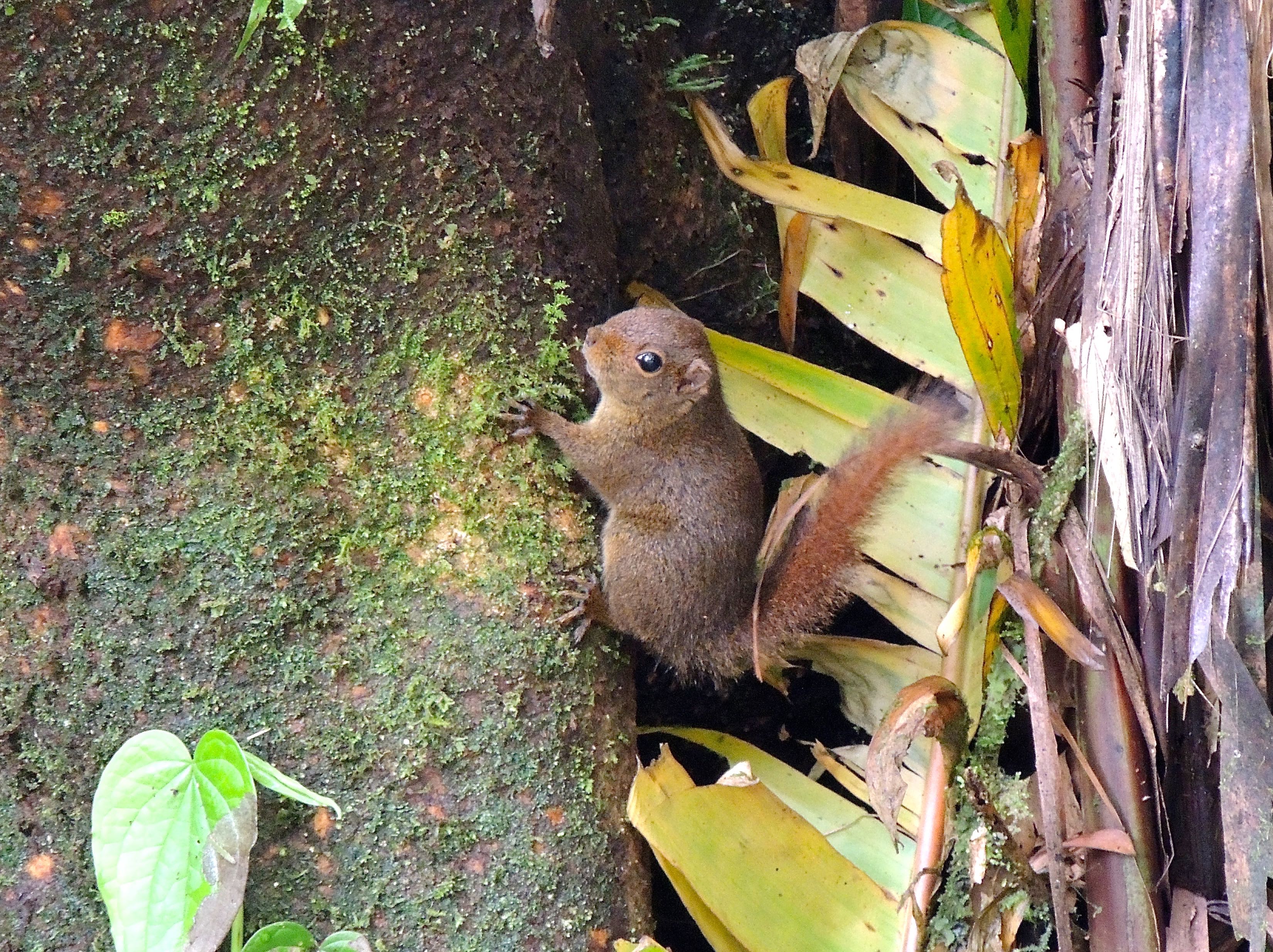 Central American Dwarf Squirrel - Photo by William Young
Central American Dwarf Squirrel - Photo by William YoungReptiles and Amphibians
The only snake I saw was a Fer-de-lance, whom we encountered the night we were looking for arthropods on the Rancho Naturalista trails. Along the Rio Savegre, we saw a couple of Green Spiny Lizards. At Cope's house we saw both Green Basilisks and Casque-headed Lizards. We saw the Blue Jeans color morph of the tiny Strawberry Poison-Dart Frogs. We also saw some larger frogs I could not identify. CATIE had a number of Spectacled Caimans, including some who looked very young.
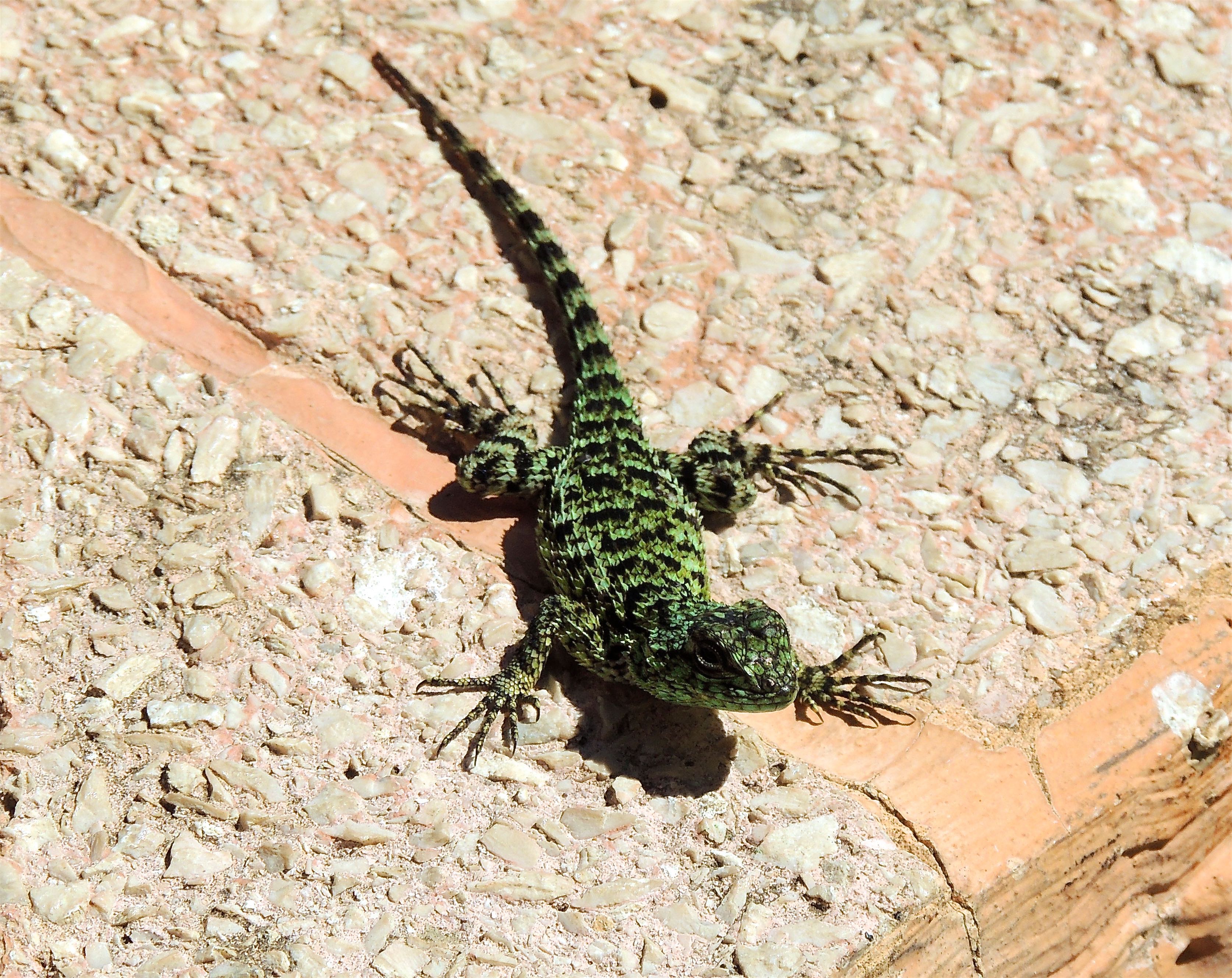 Green Spiny Lizard - Photo by William Young
Green Spiny Lizard - Photo by William Young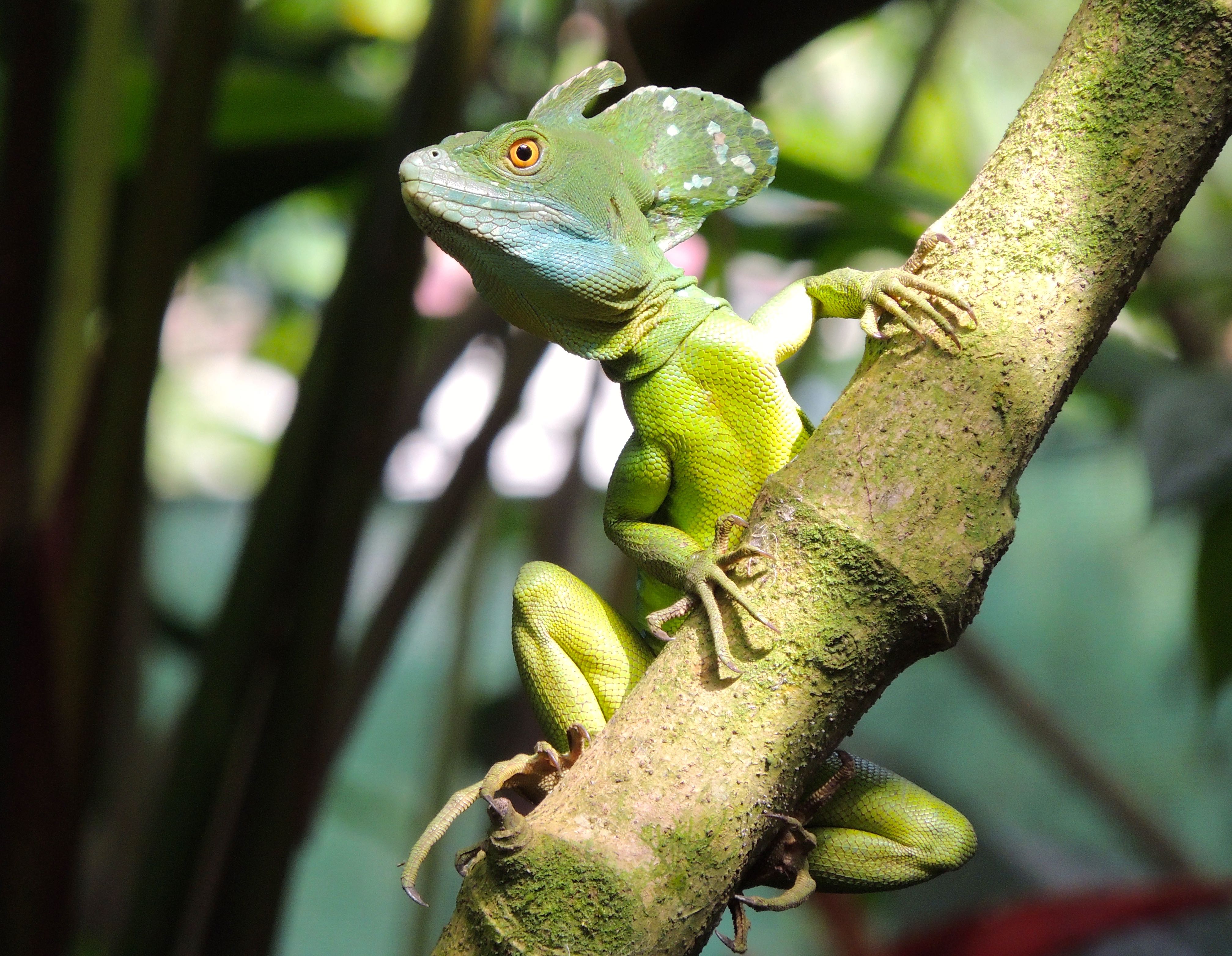 Green Basilisk - Photo by William Young
Green Basilisk - Photo by William YoungArthropods
Ashley spent a lot of time photographing arthropods on the trip. Some of the most memorable were the Tailless Whip-Scorpions we found on the night walk at Rancho Naturalista. We saw countless species of spiders, ranging from tiny ones to very large Orange-kneed Tarantulas. We saw a lot of Morpho butterflies and many other colorful butterfly species. There were also a lot of dragonflies and damselflies. The most memorable were the helicopter damselflies we saw at Los Cusingos — large ones with blue tips to their wings and smaller ones with yellow tips. Cope had a huge Elephant Beetle who appeared to be at least a few inches long. And Wayne Easley showed us a number of unusual grasshoppers and other insects.
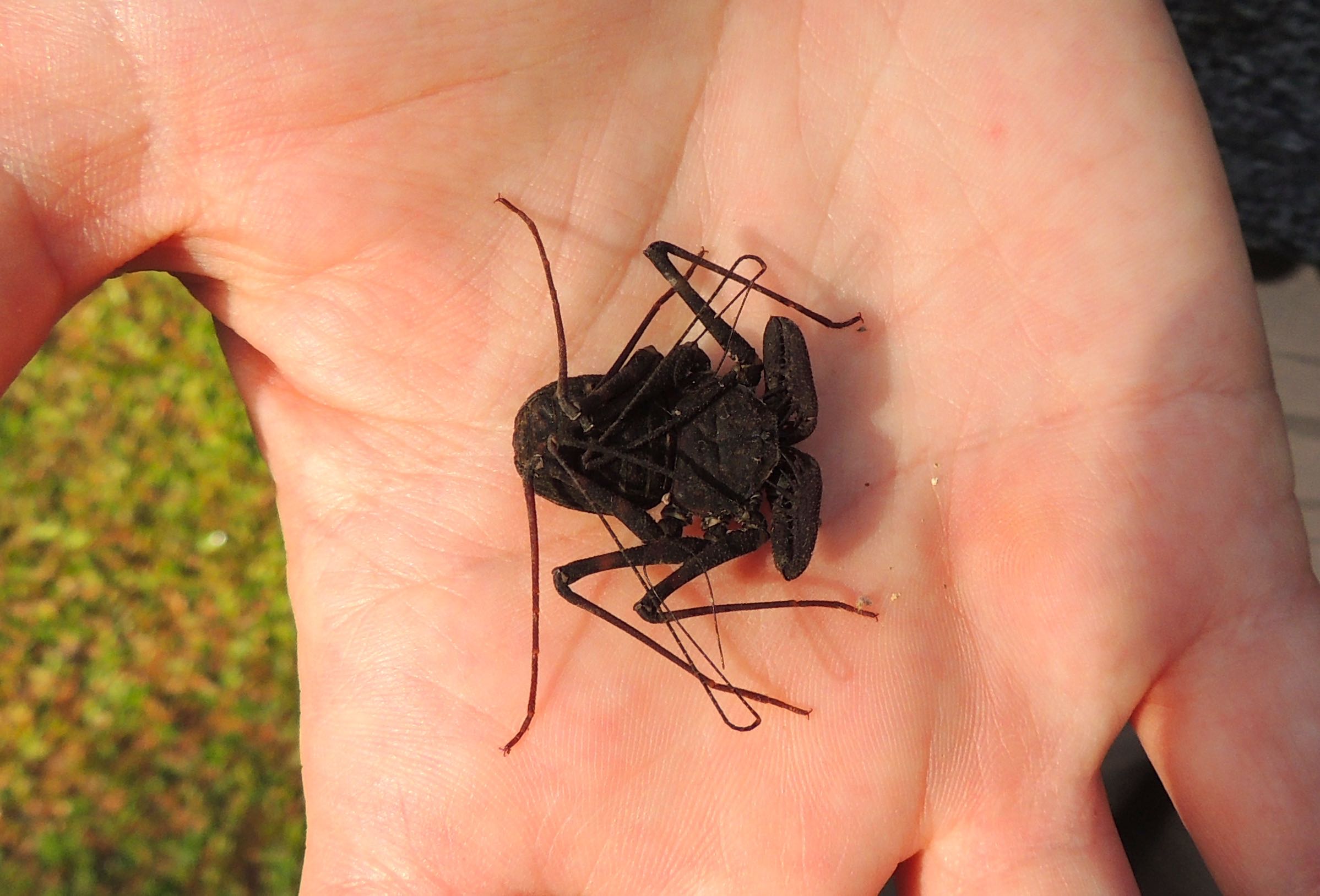 Tailless Whip-Scorpion - Photo by William Young
Tailless Whip-Scorpion - Photo by William Young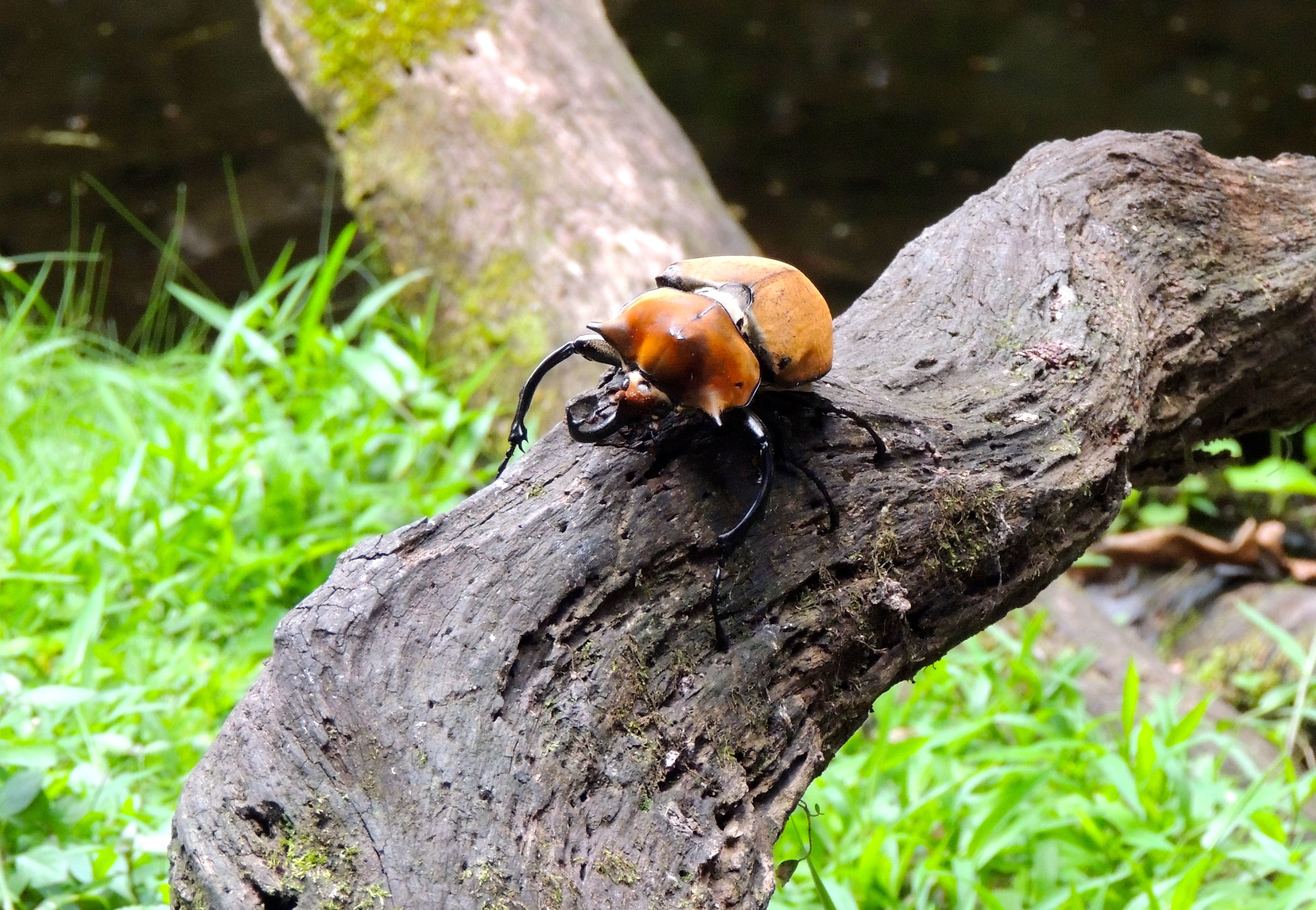 Elephant Beetle - Photo by William Young
Elephant Beetle - Photo by William Young